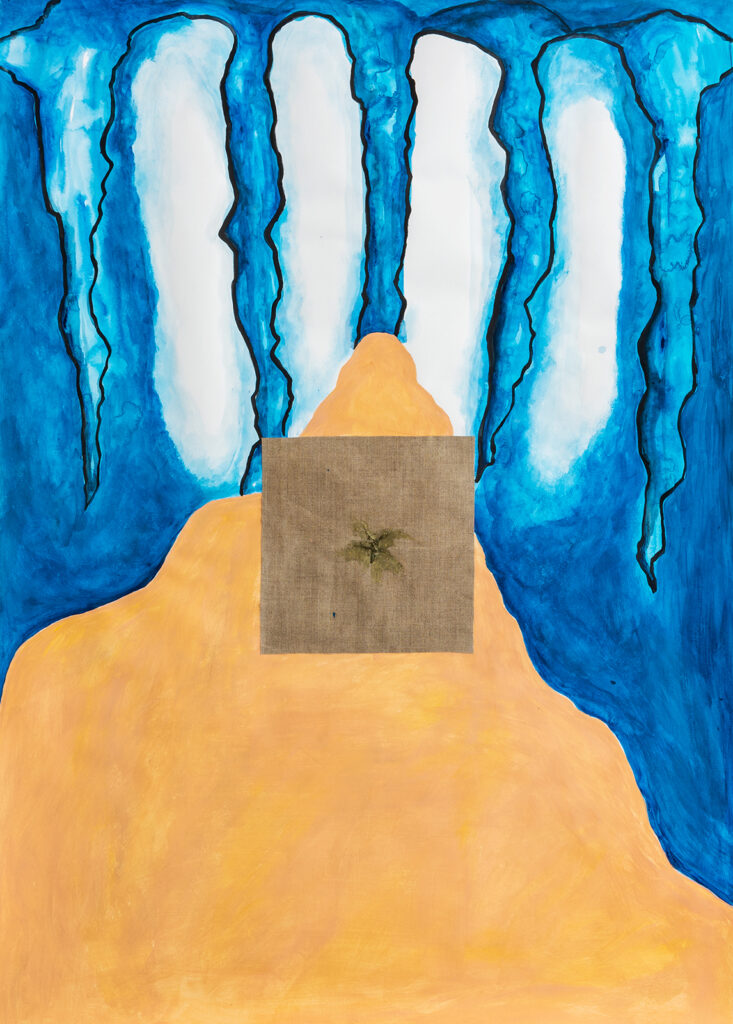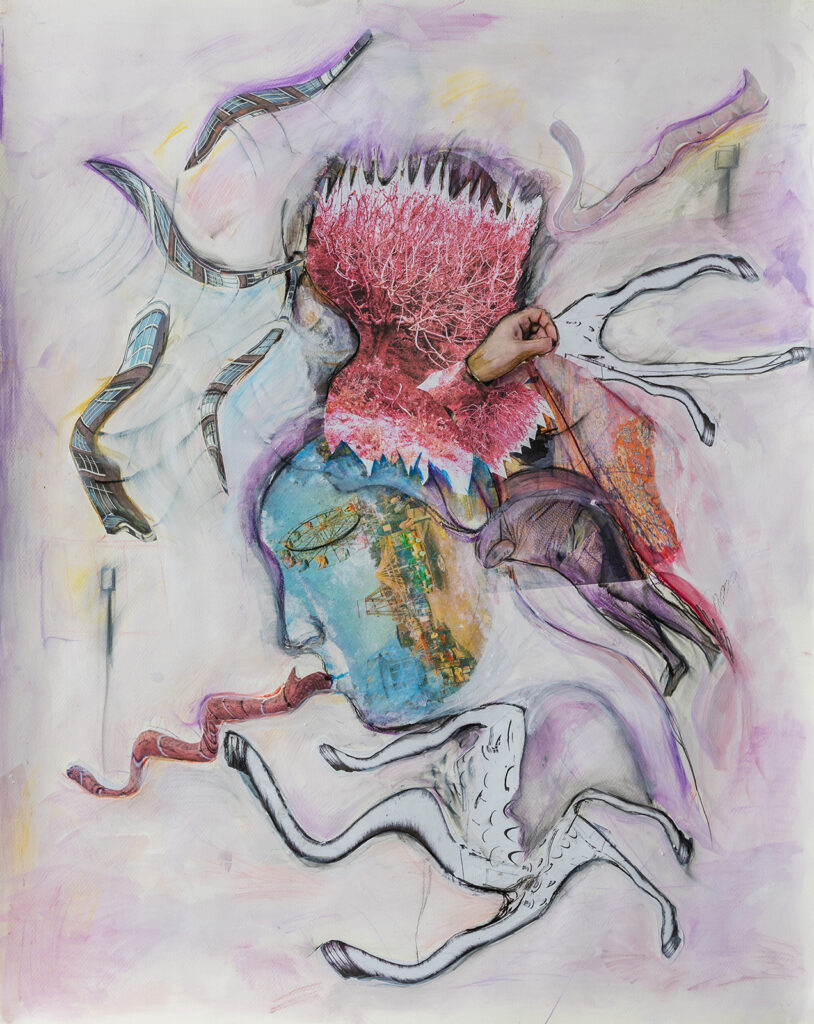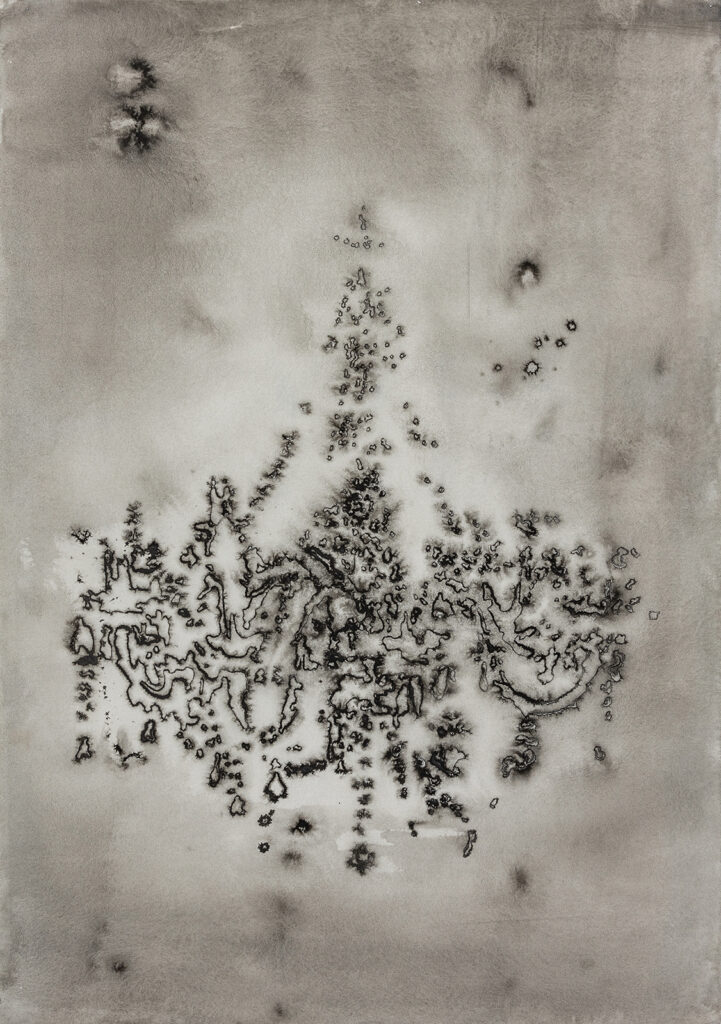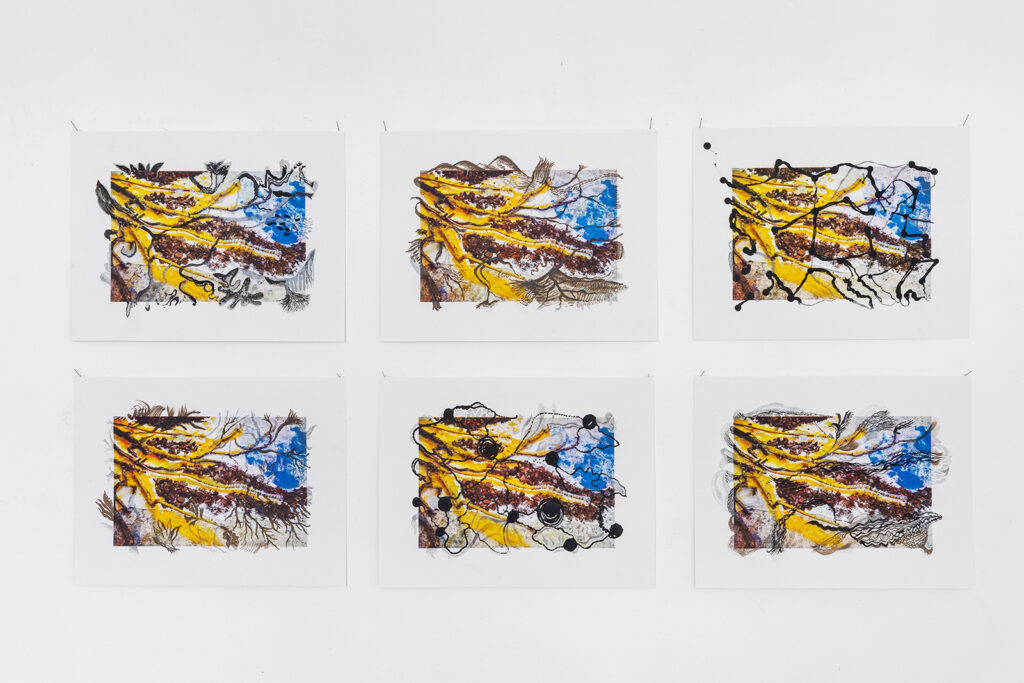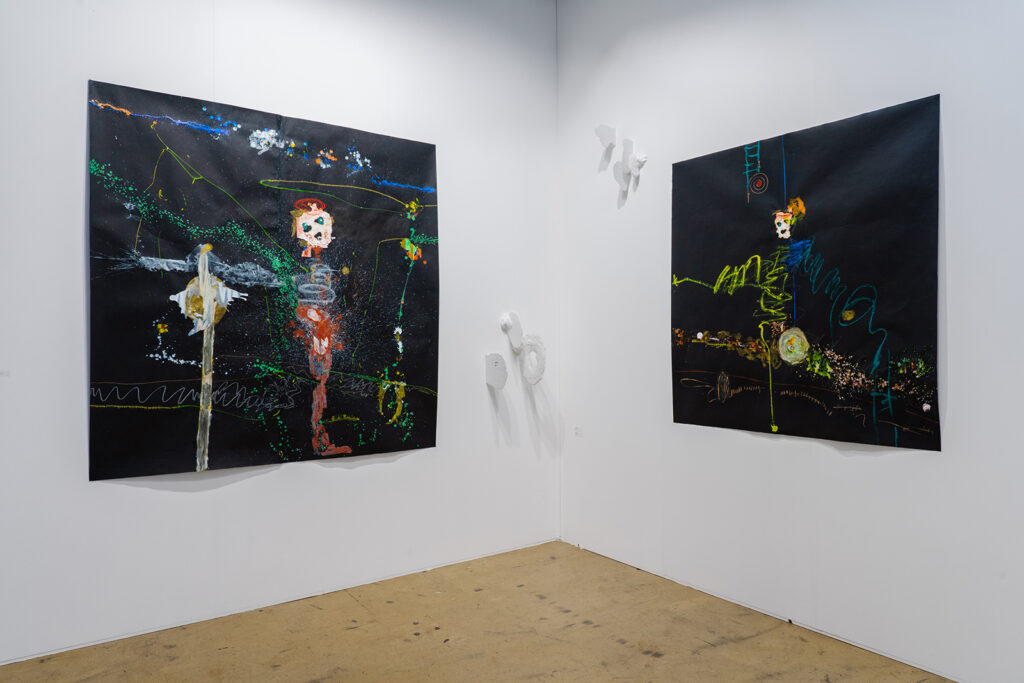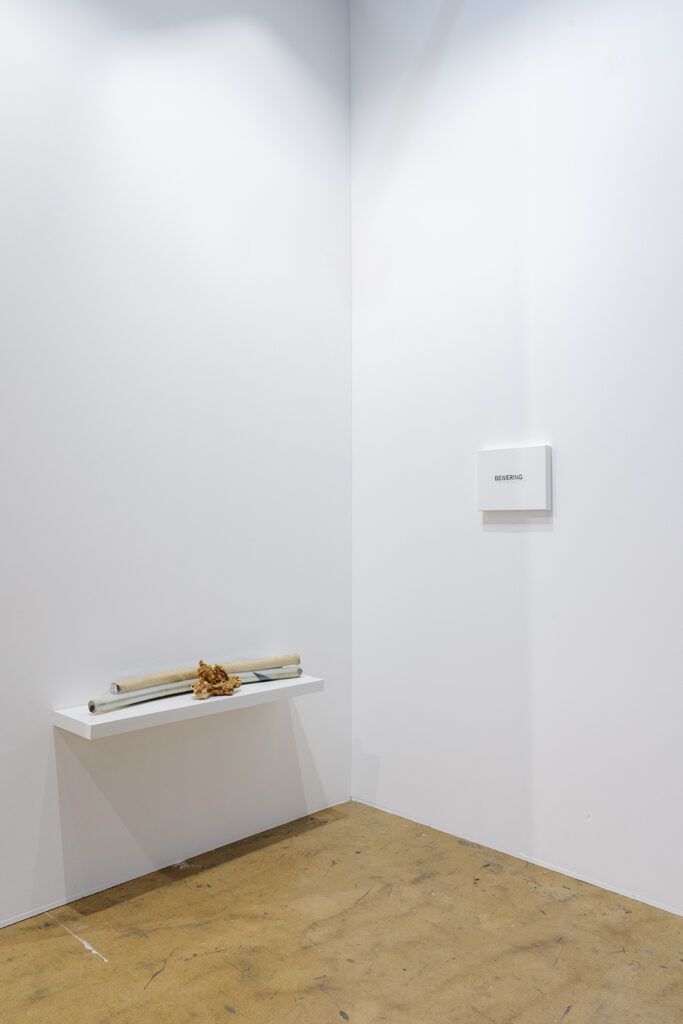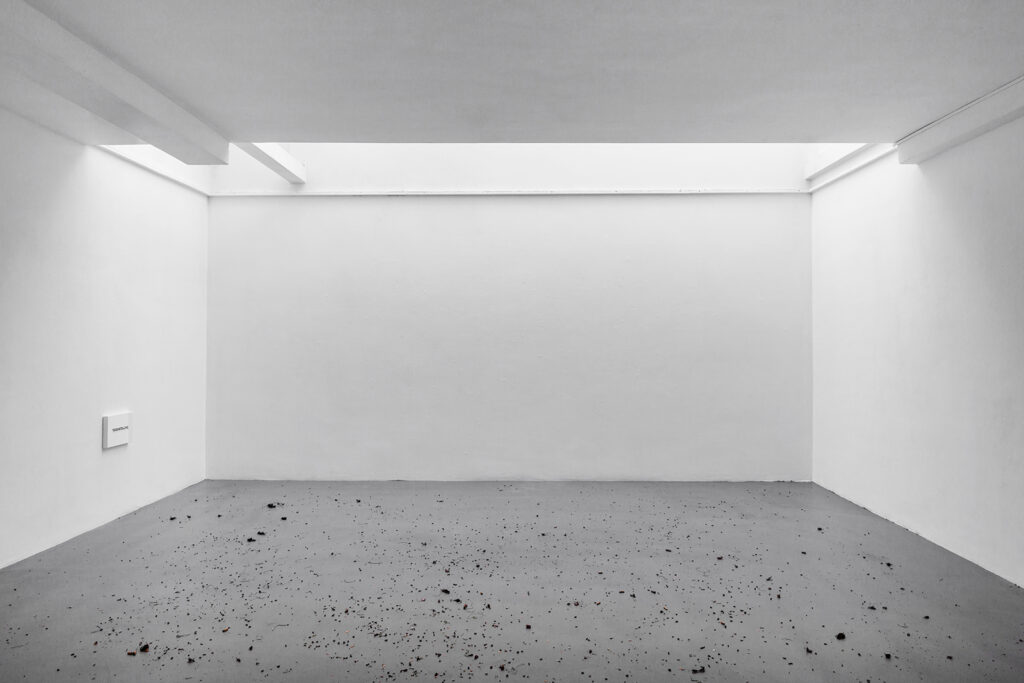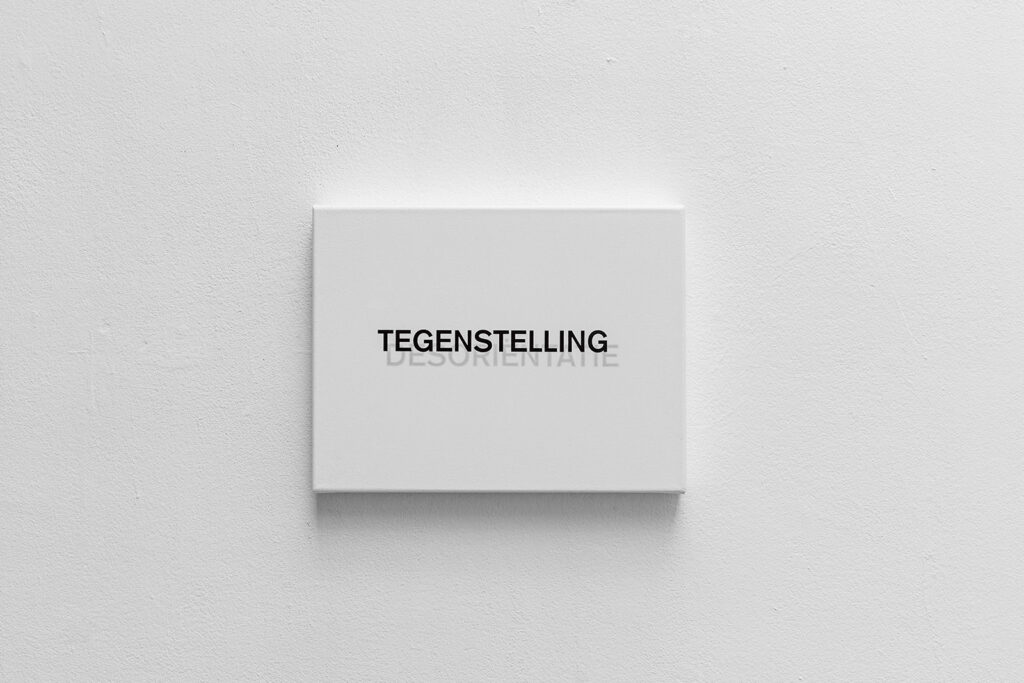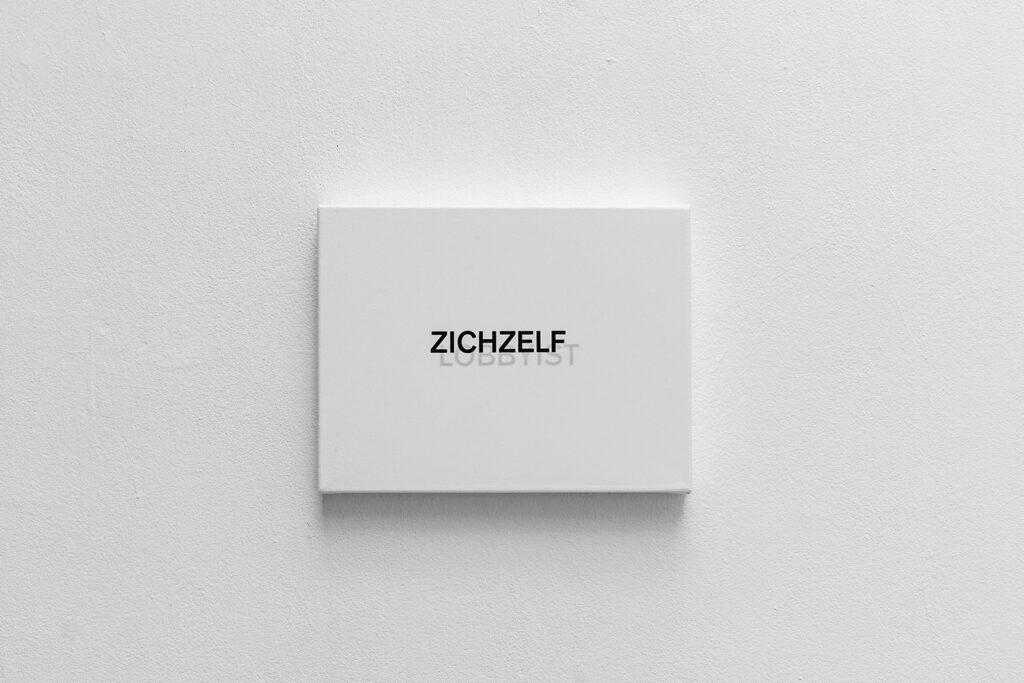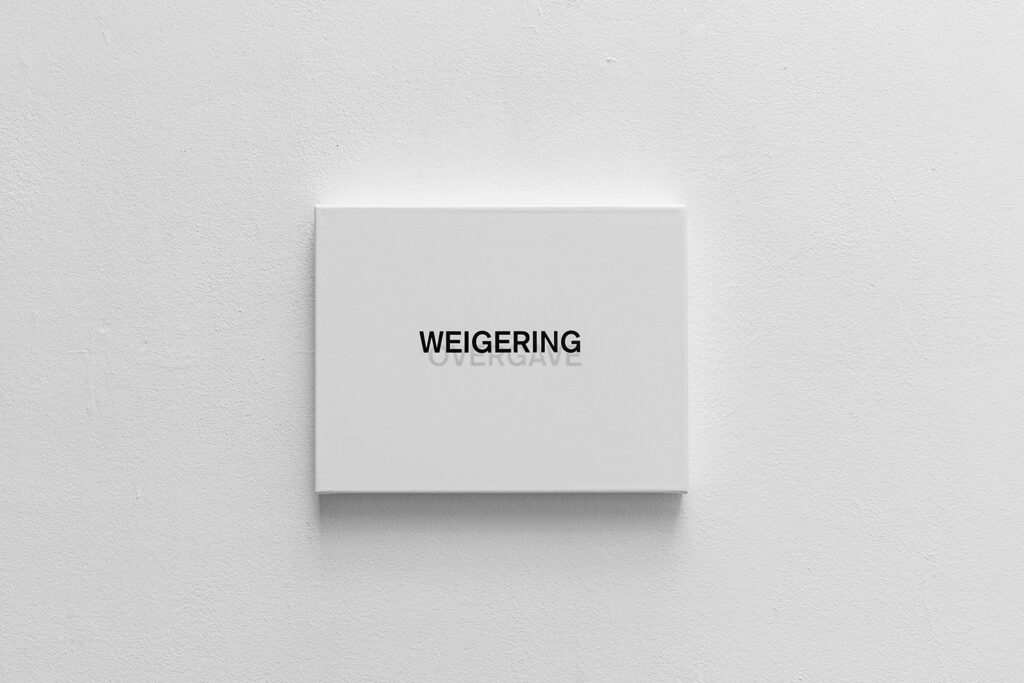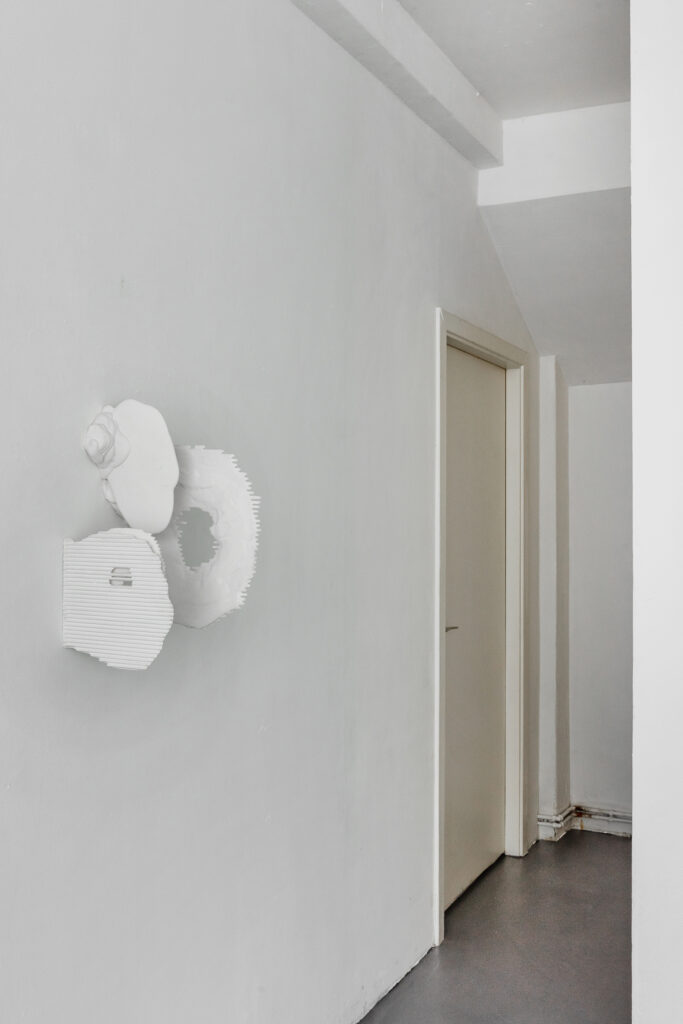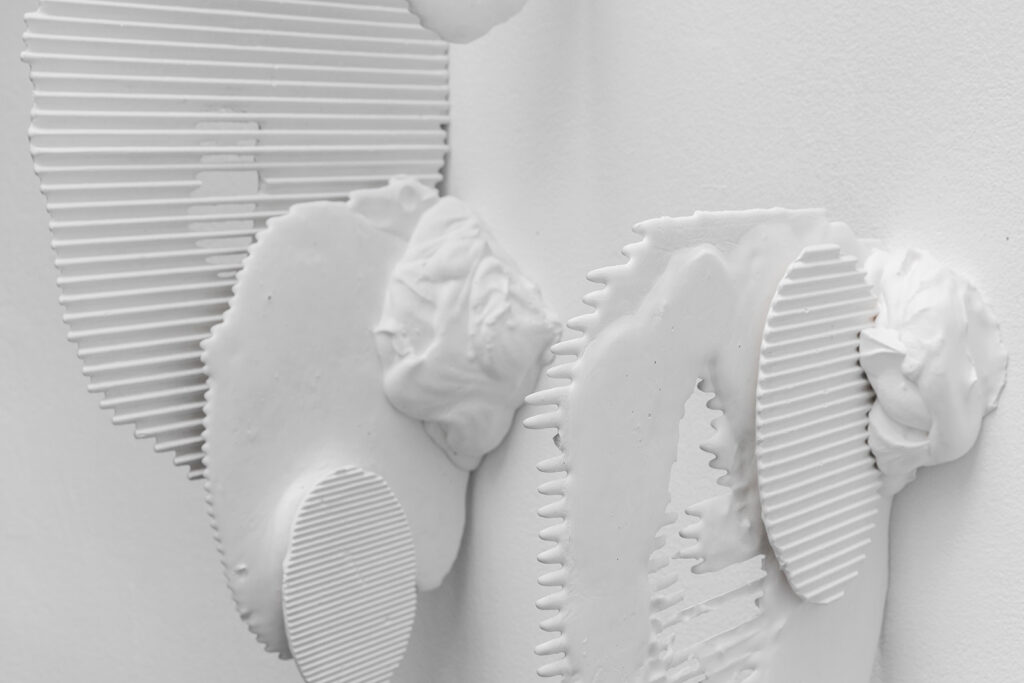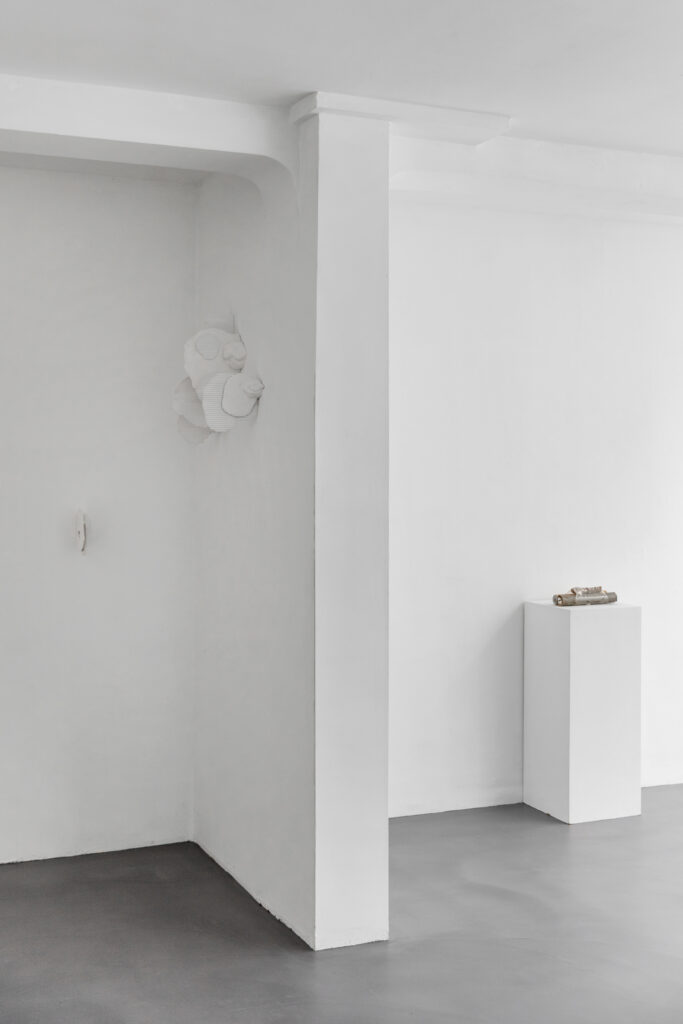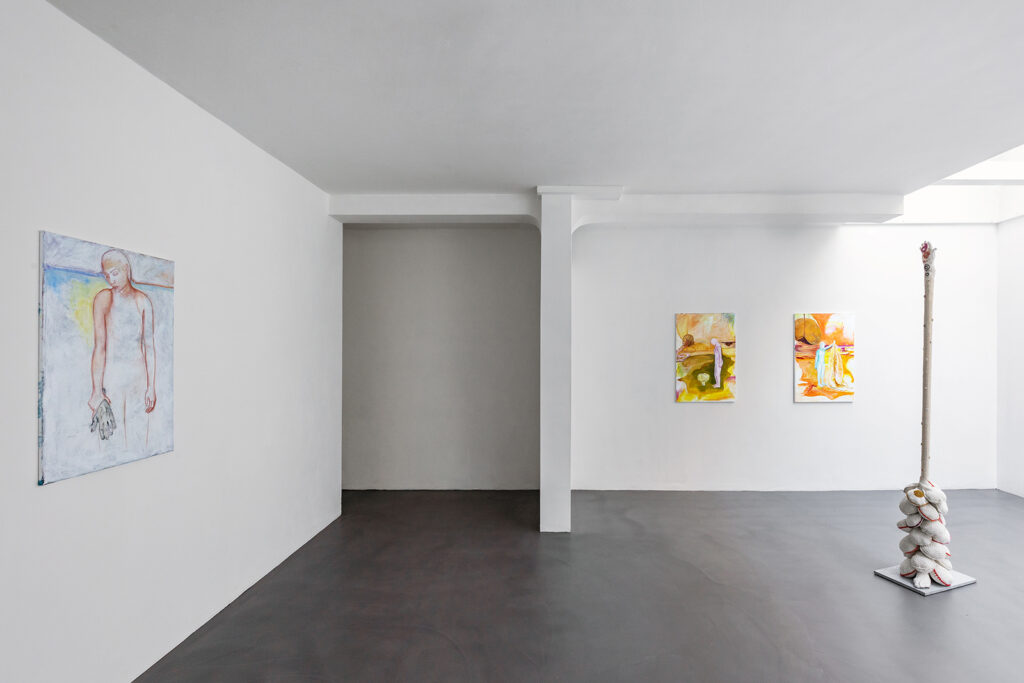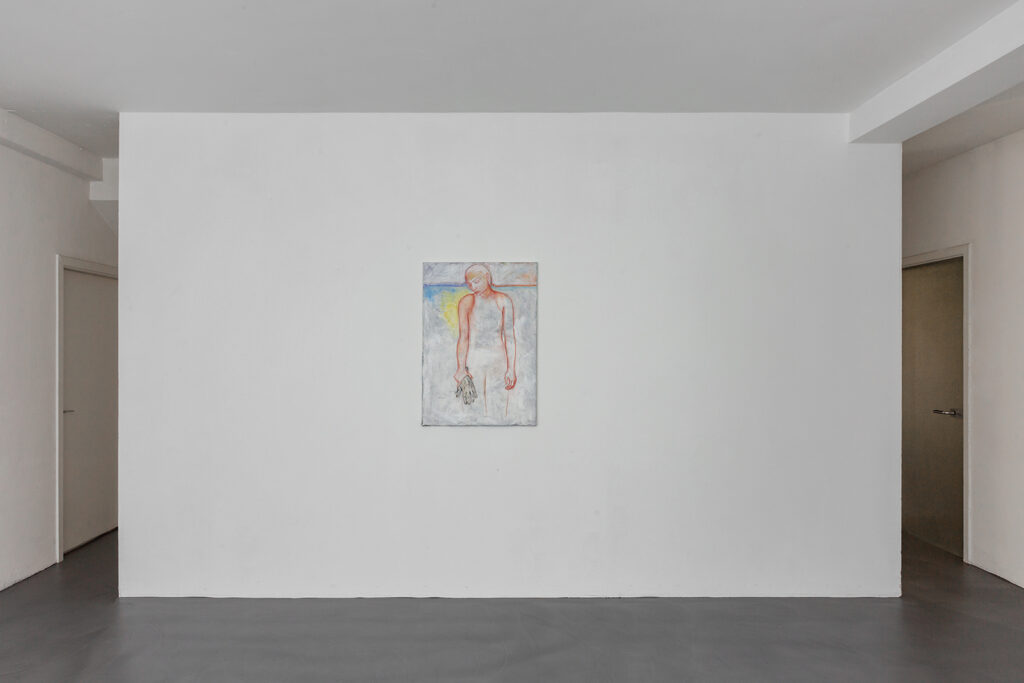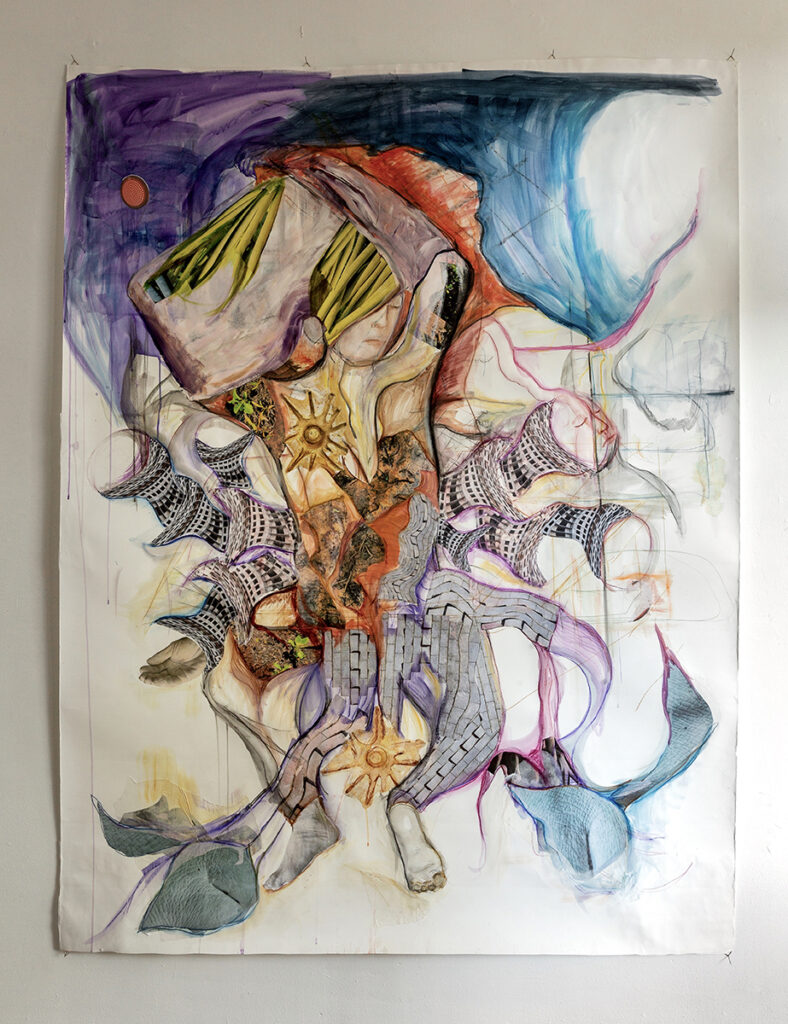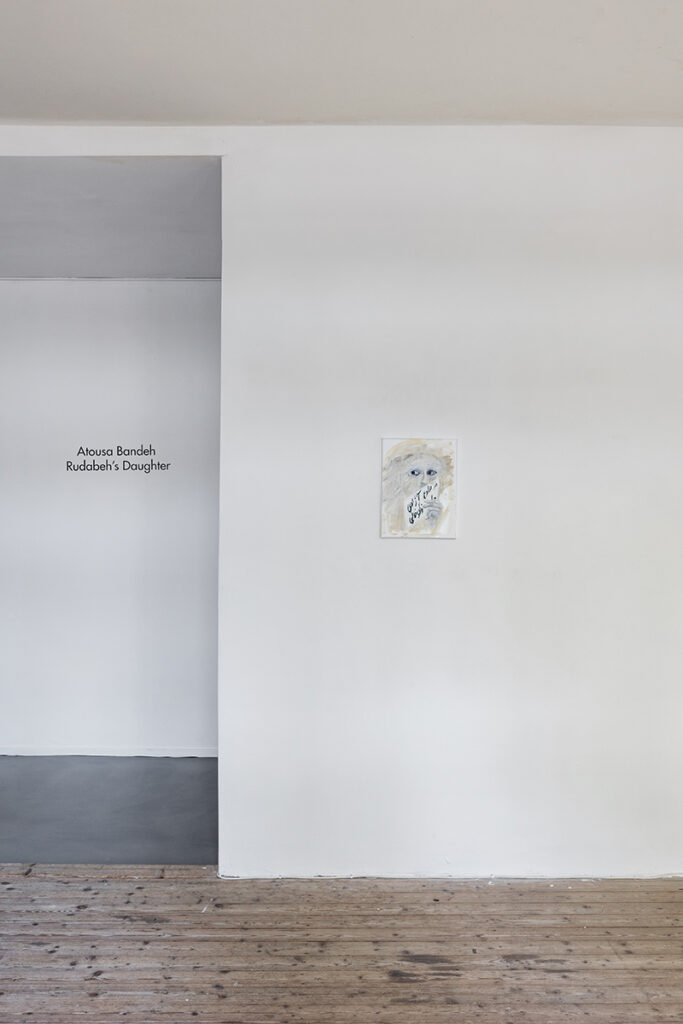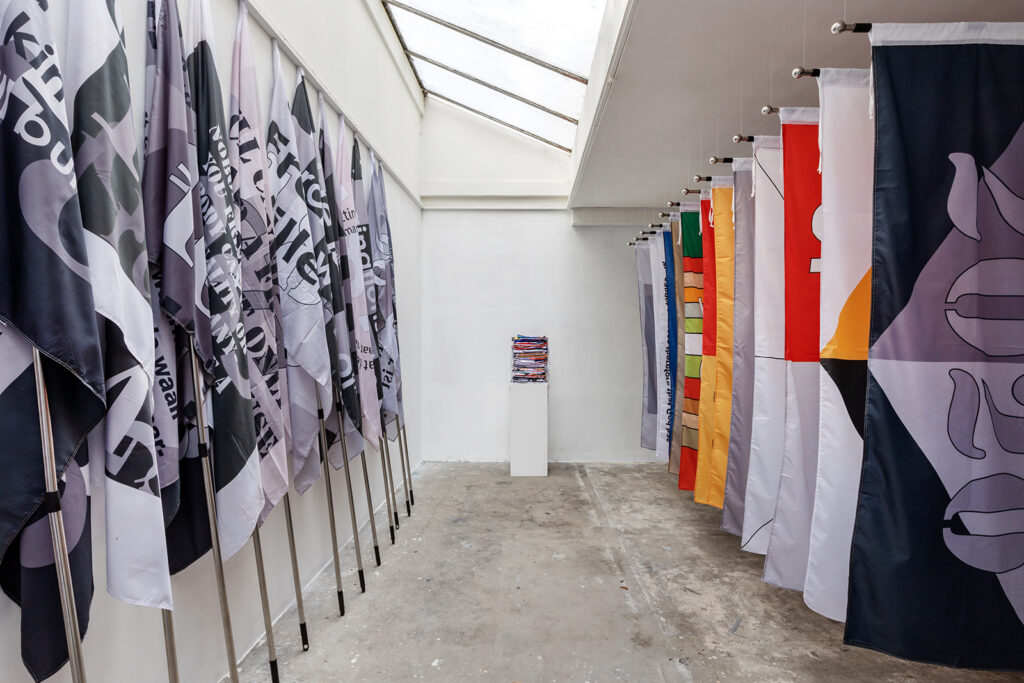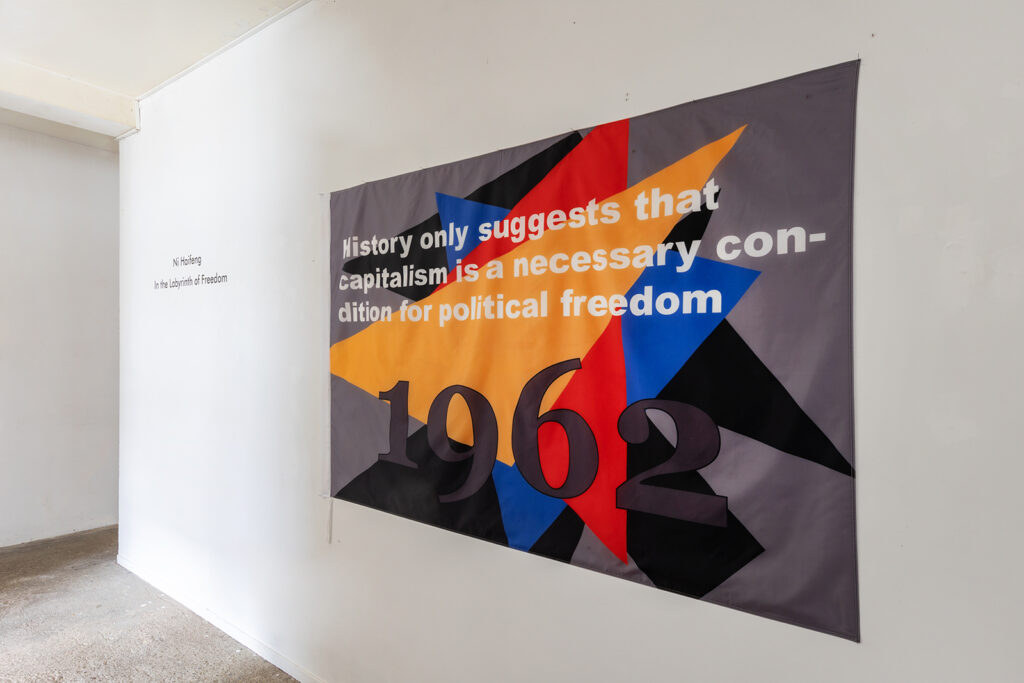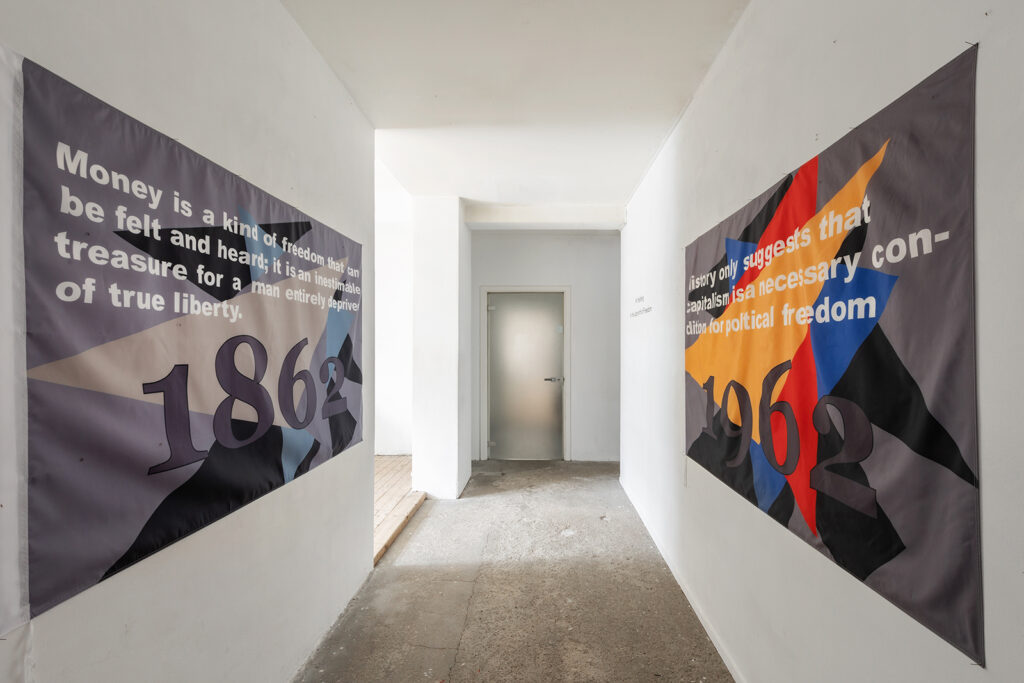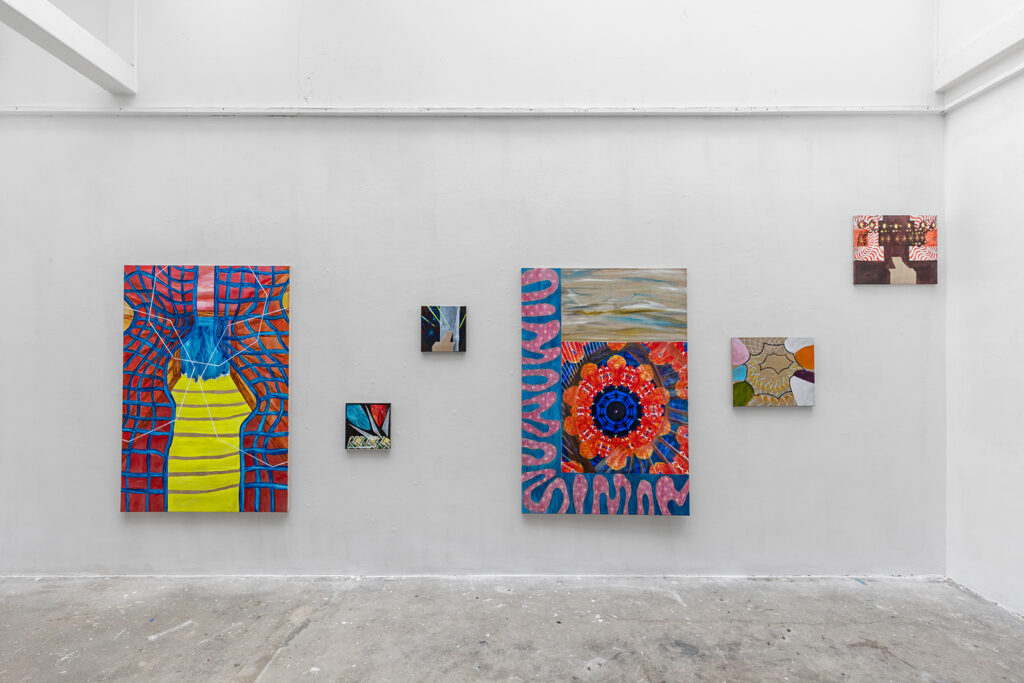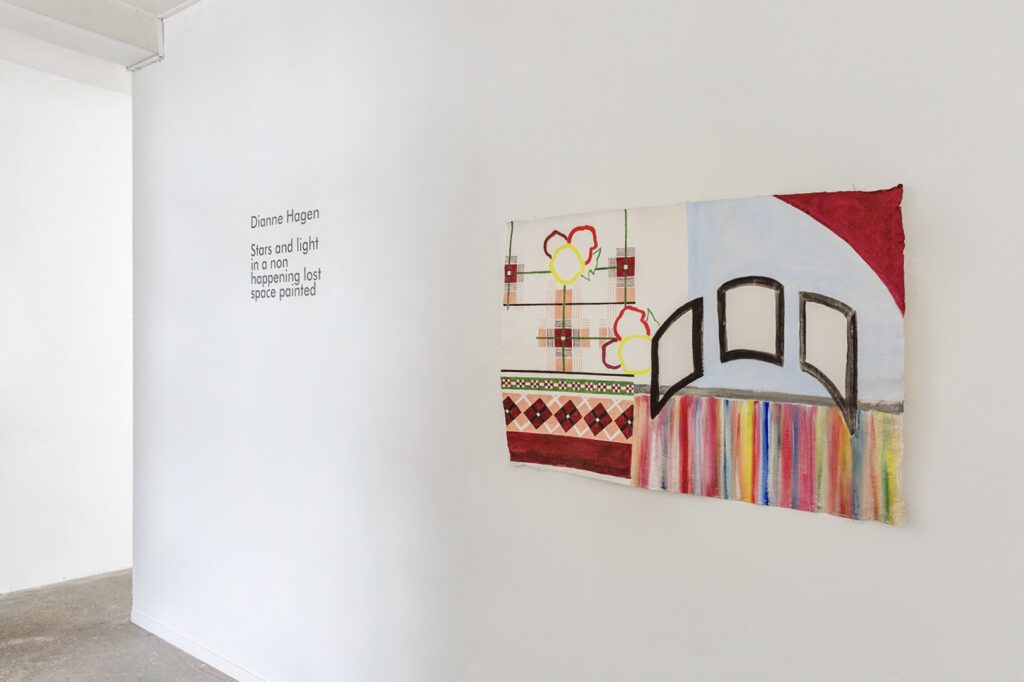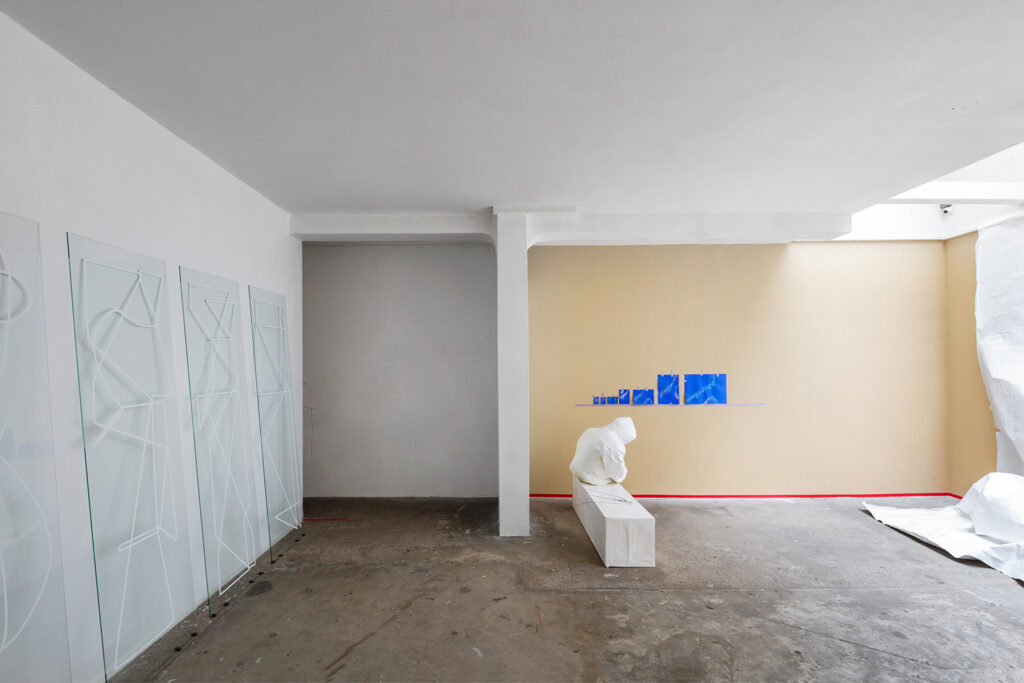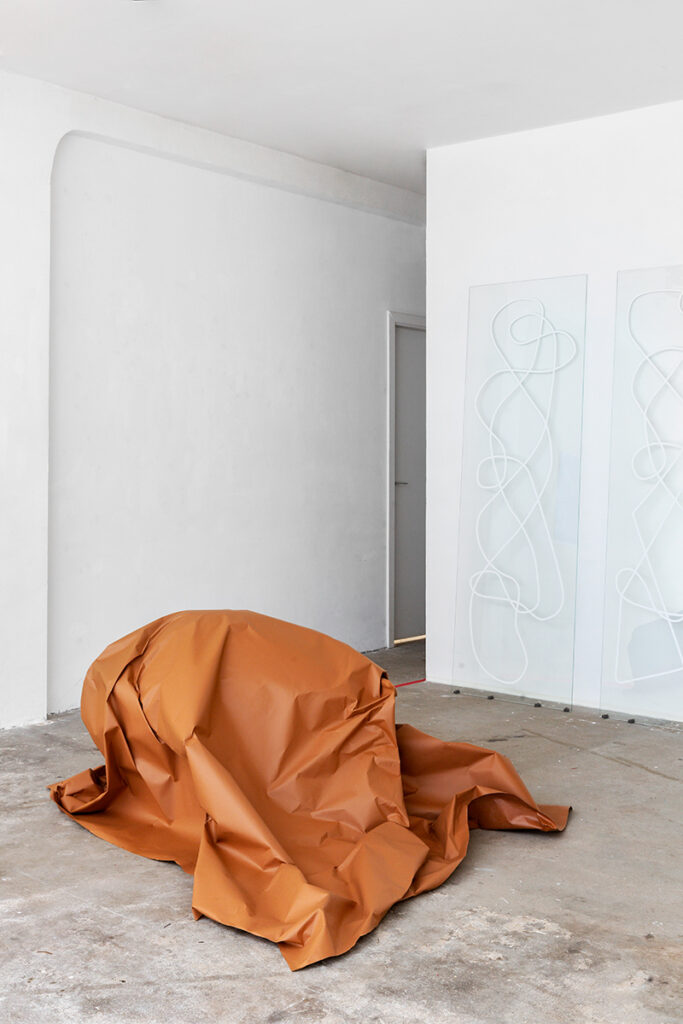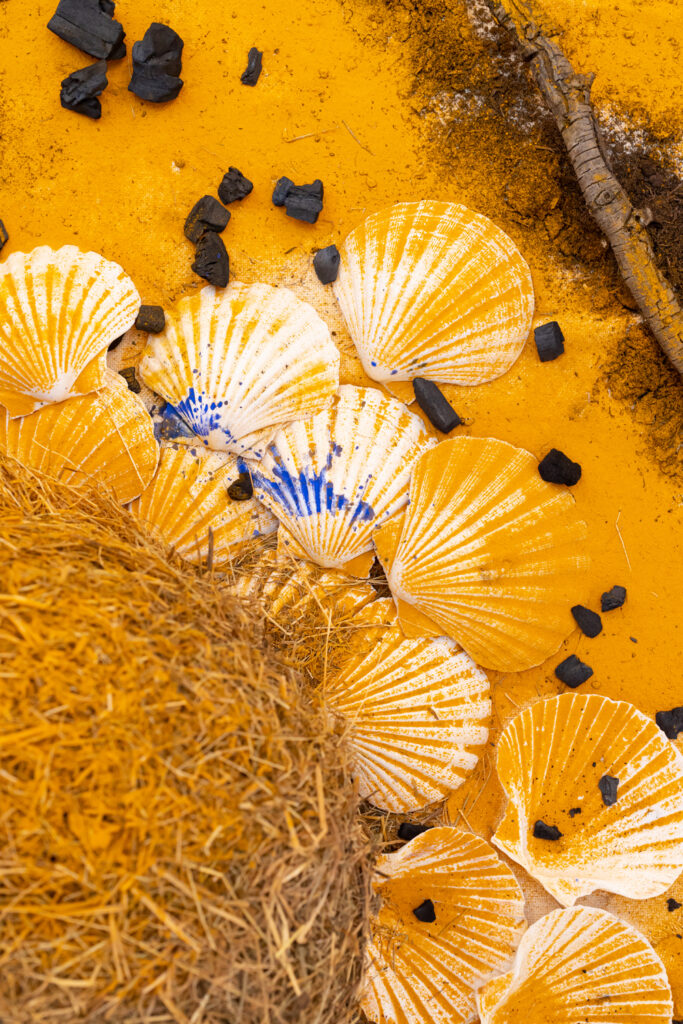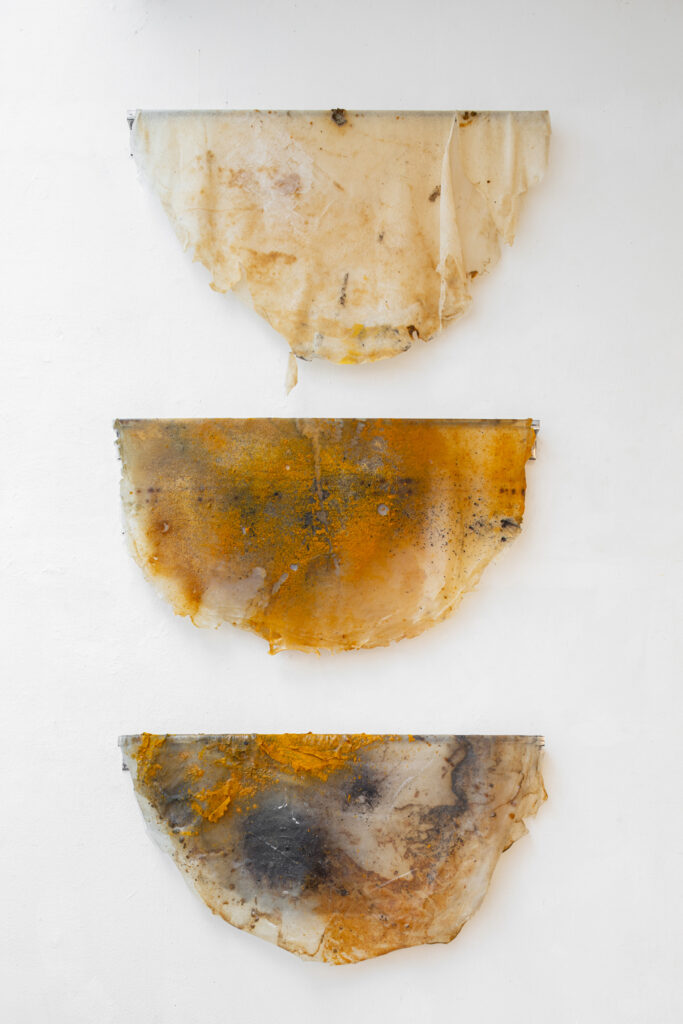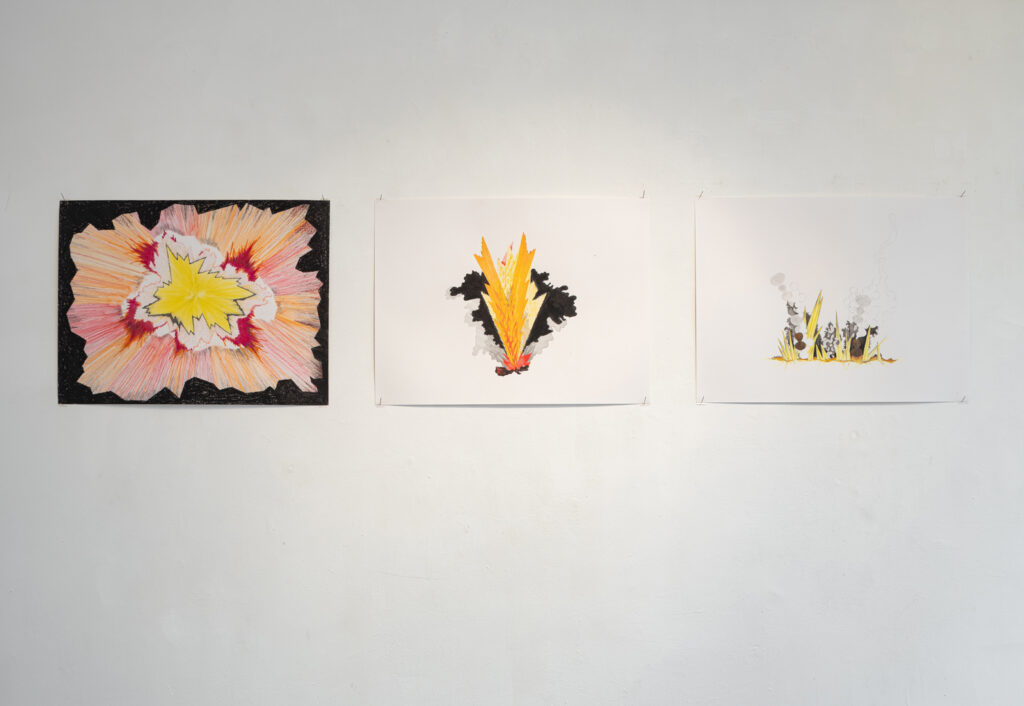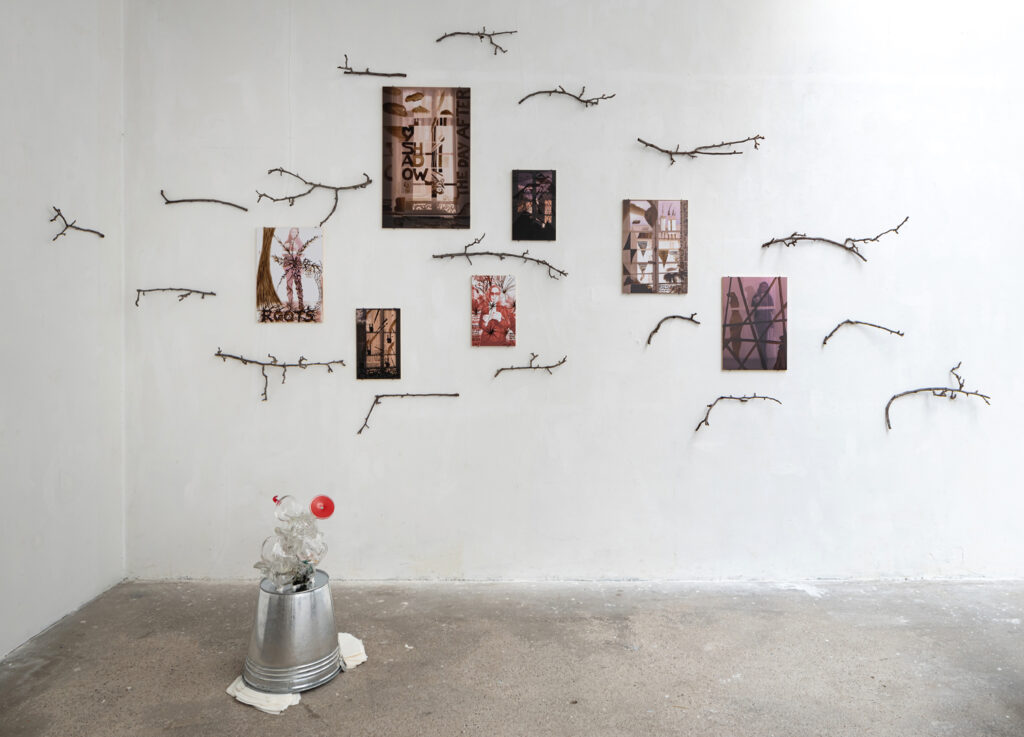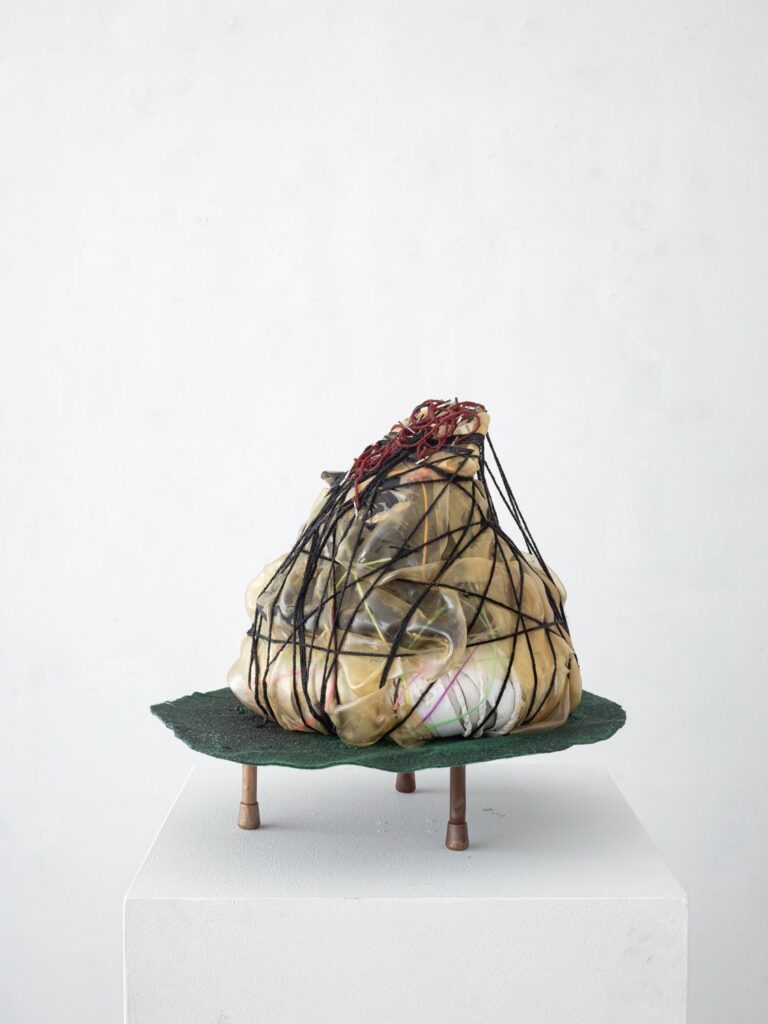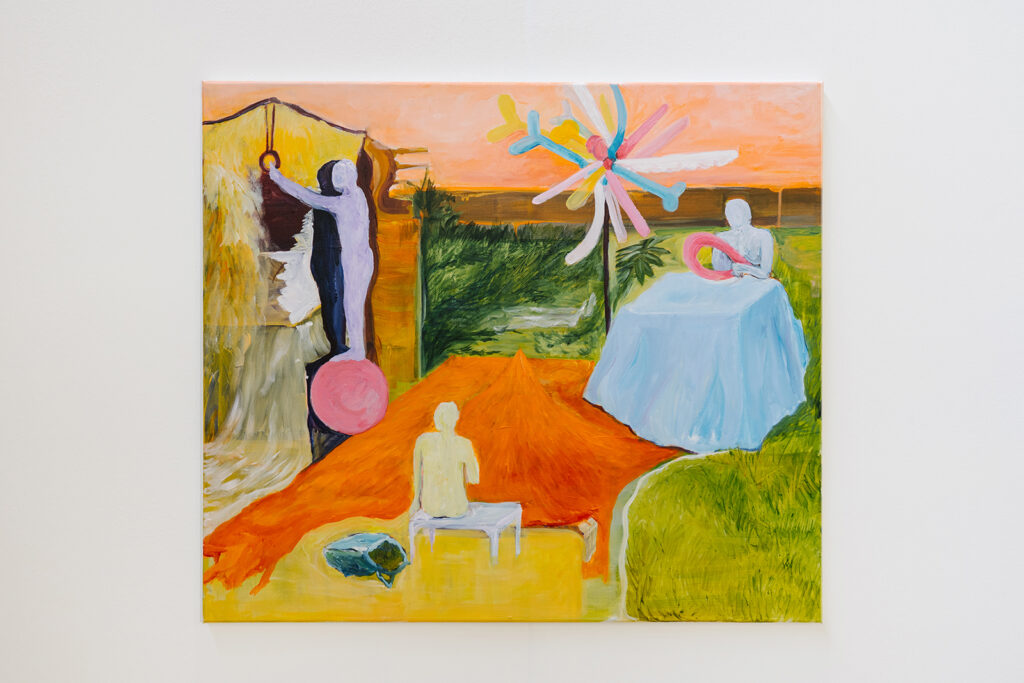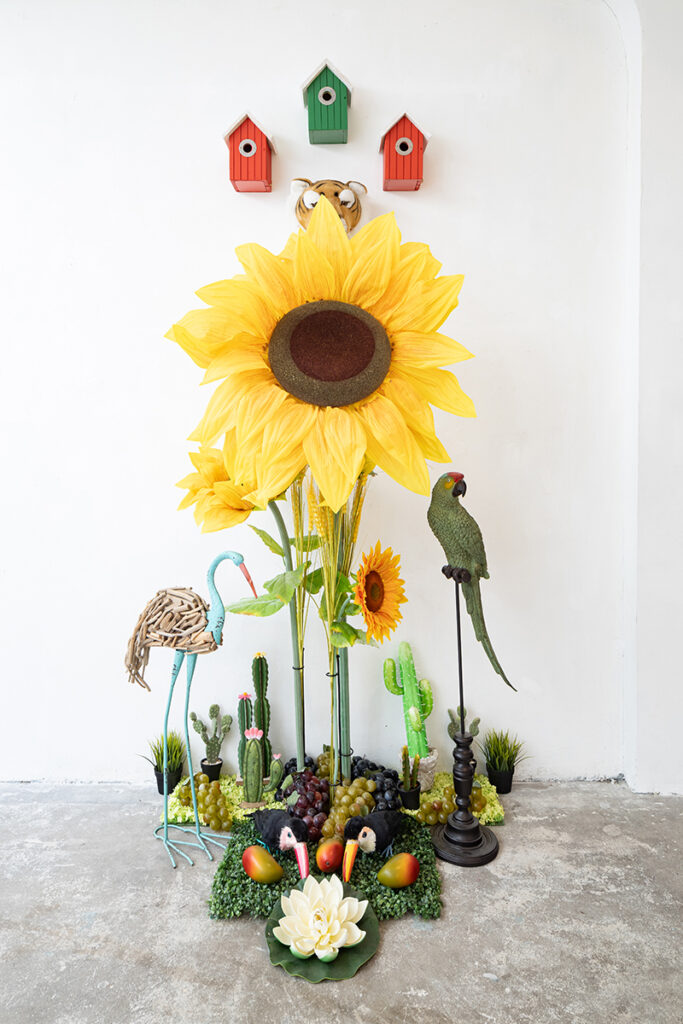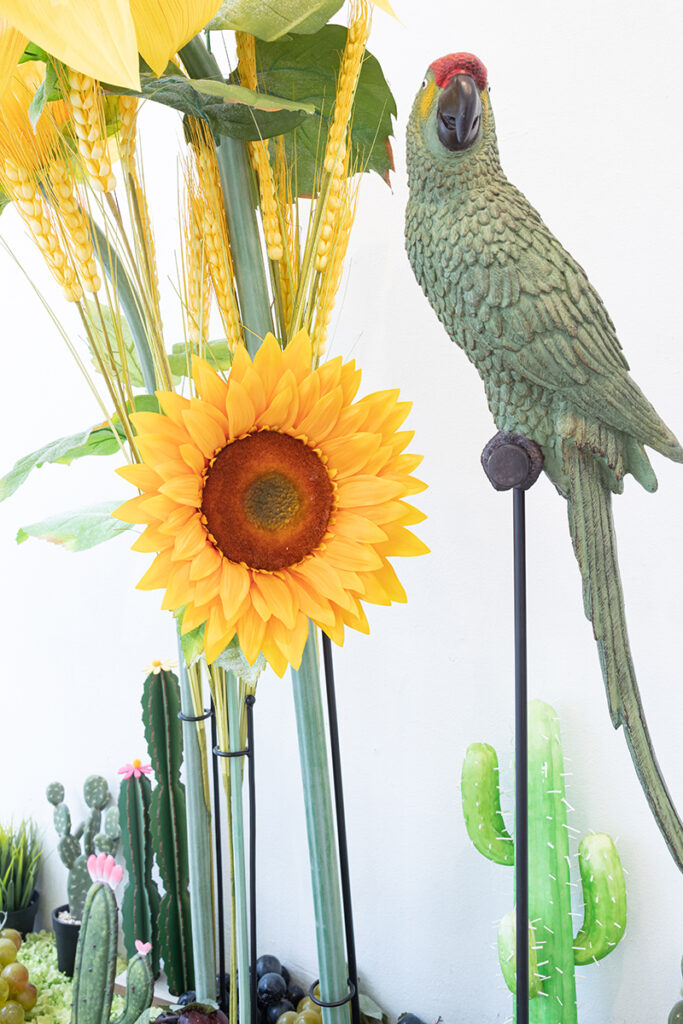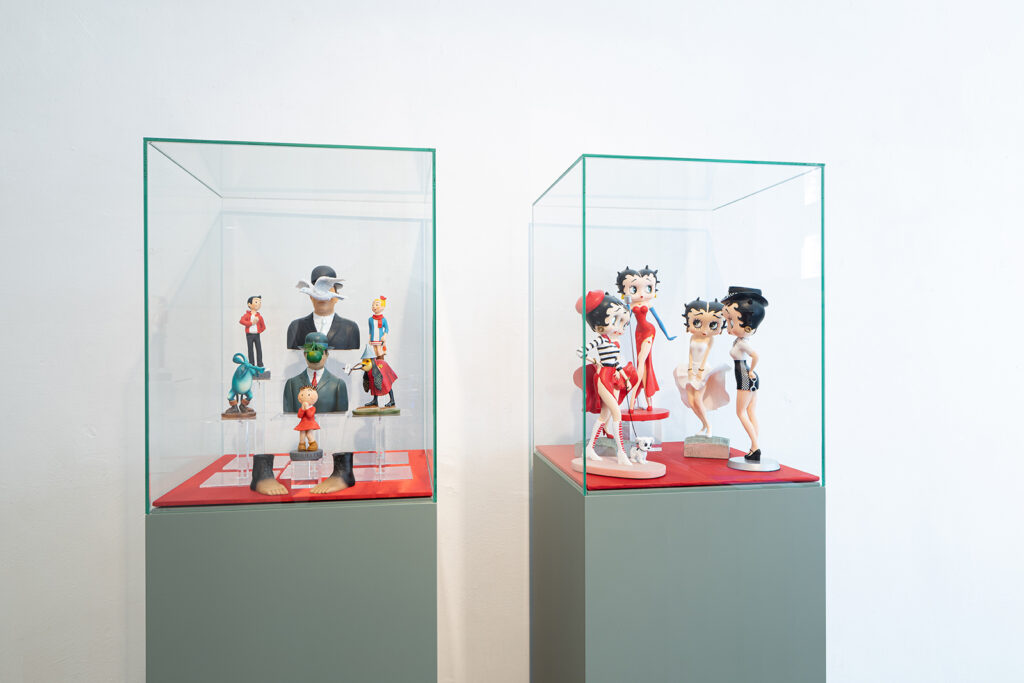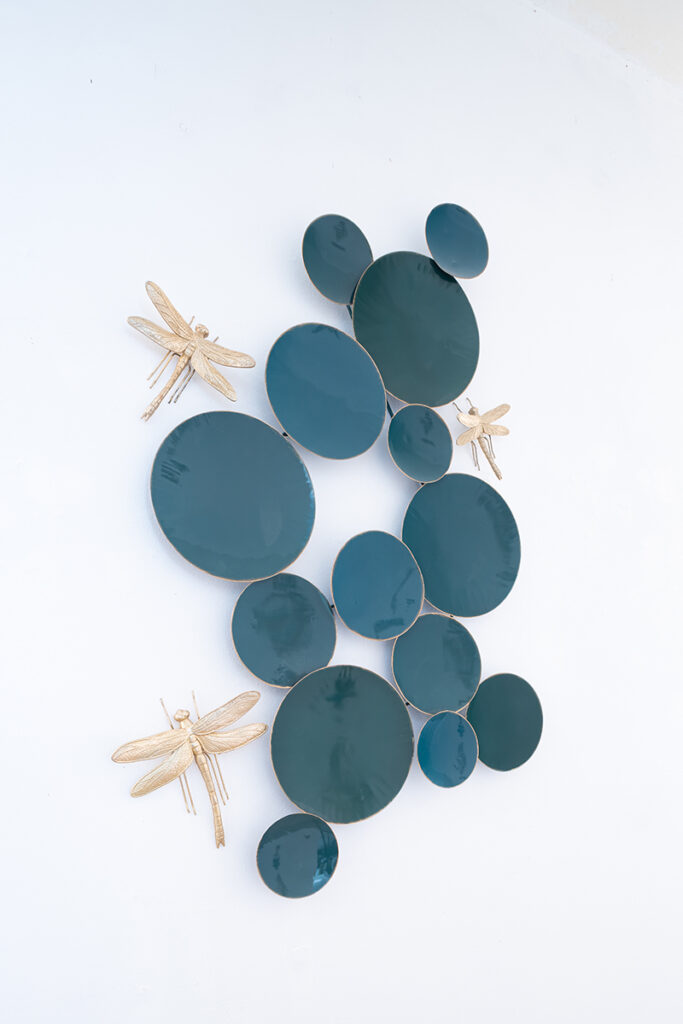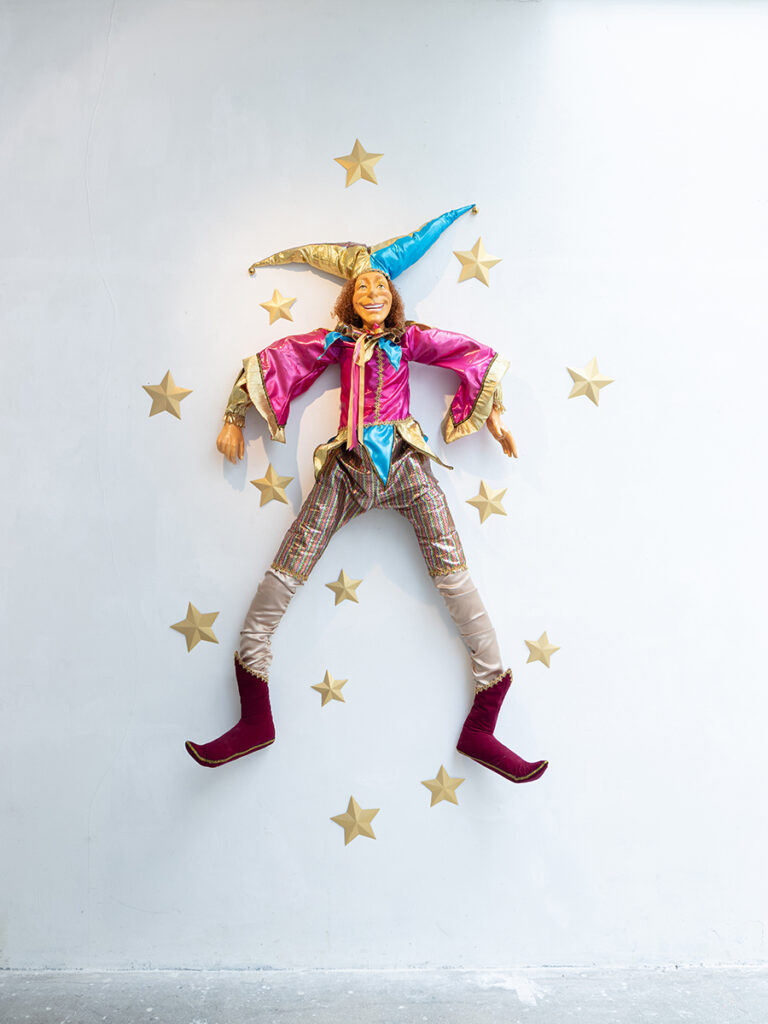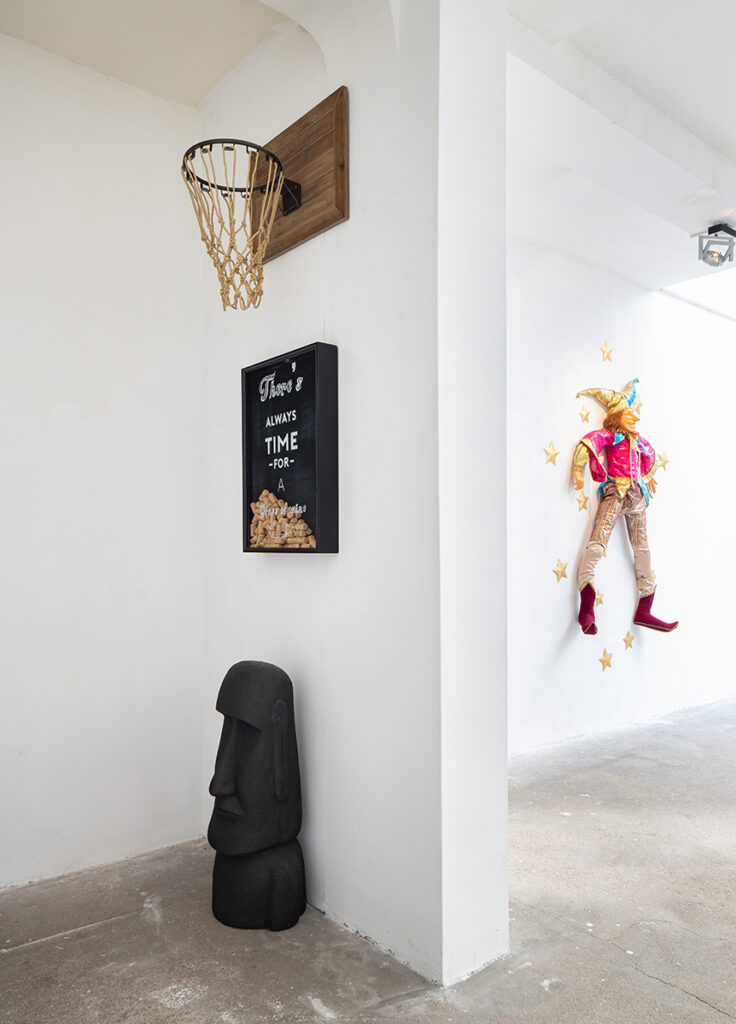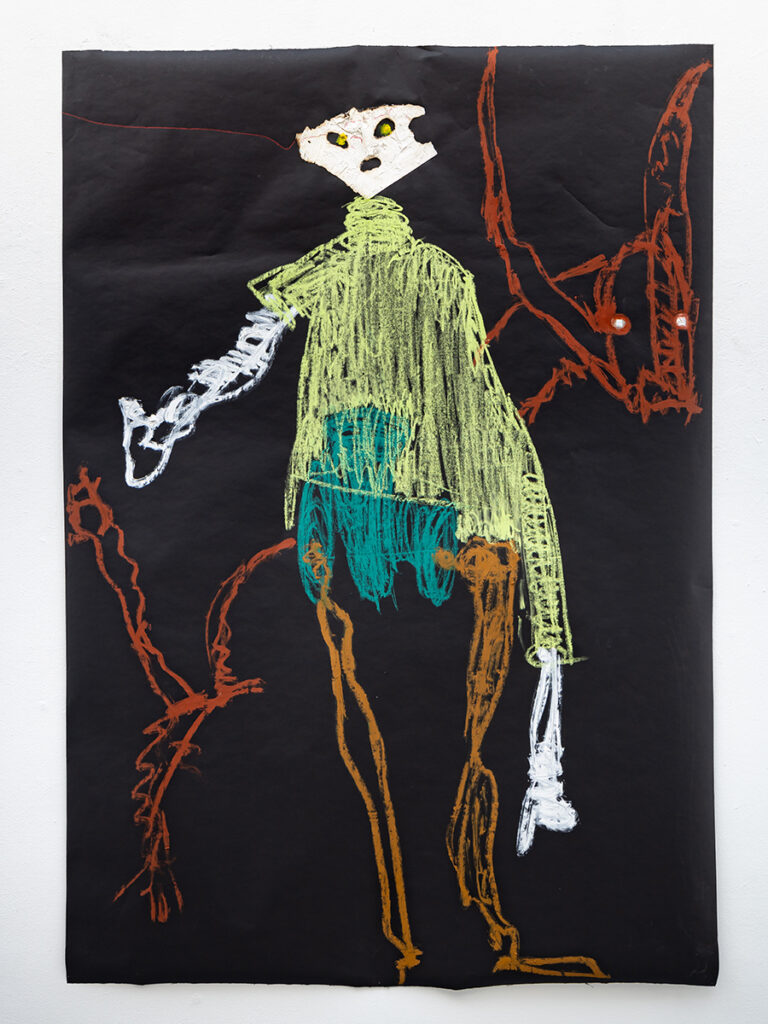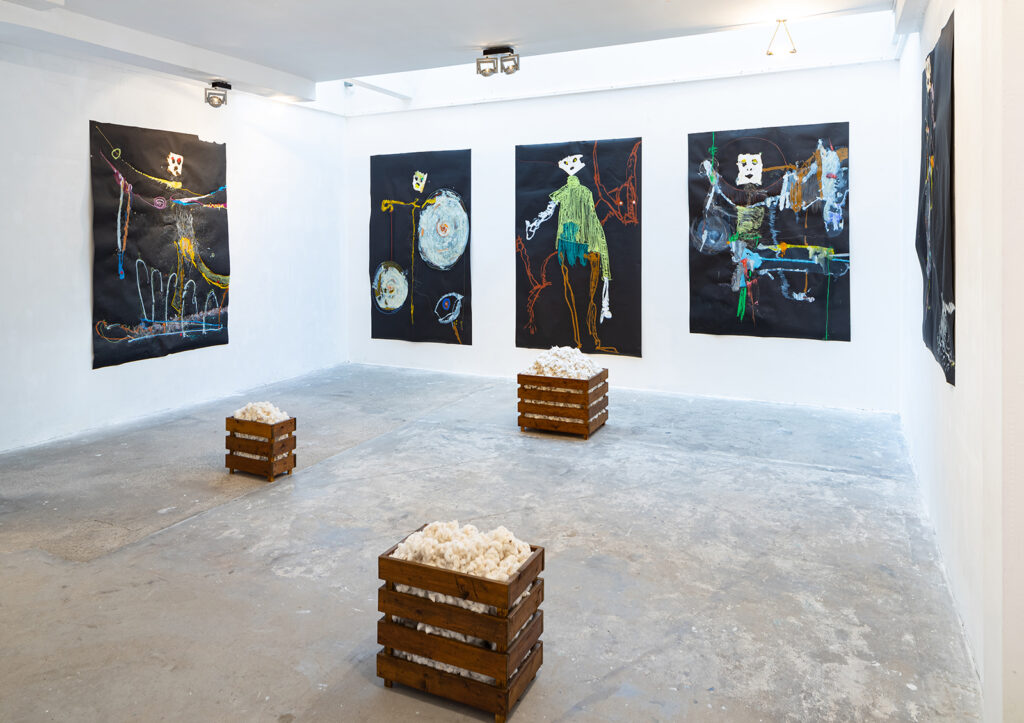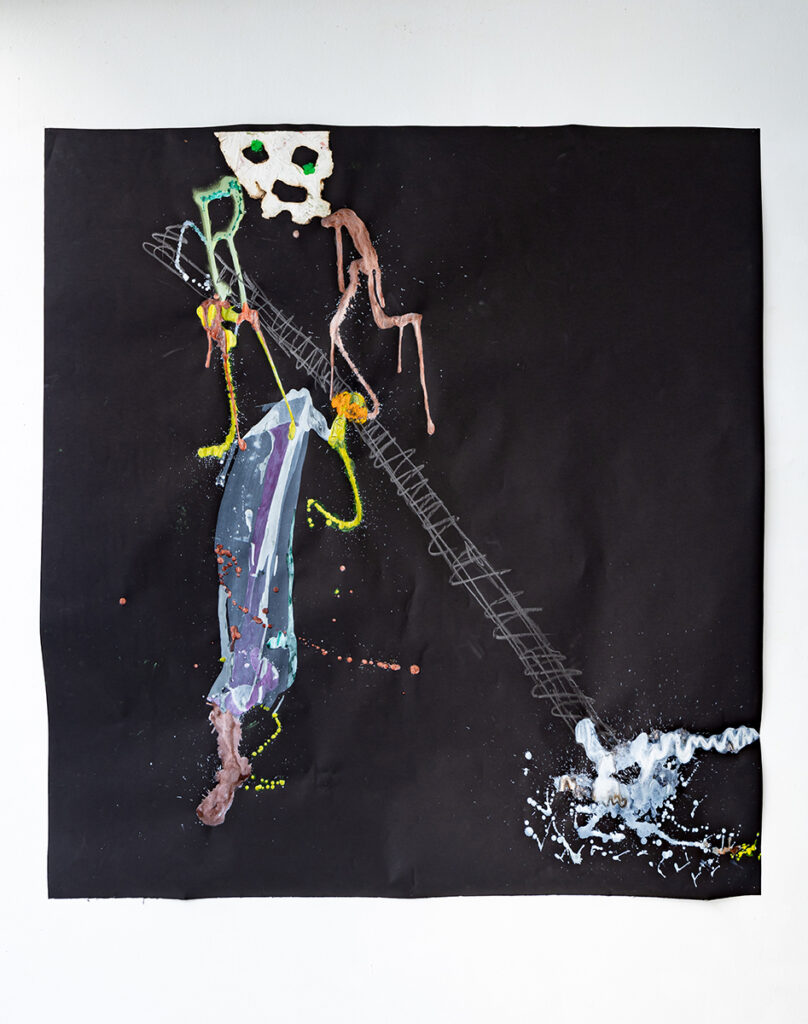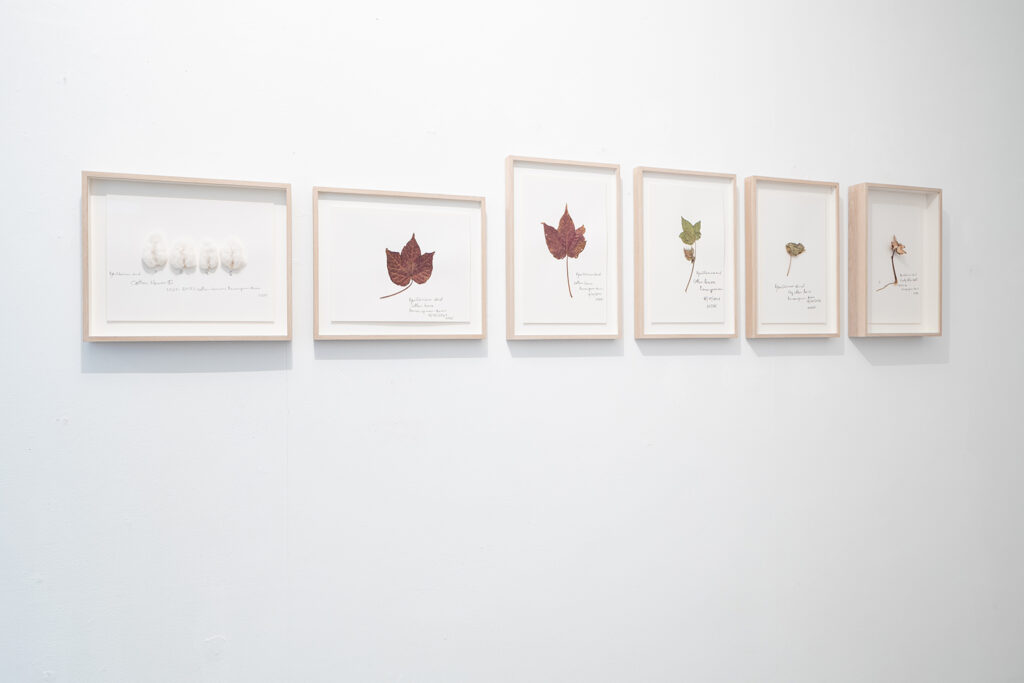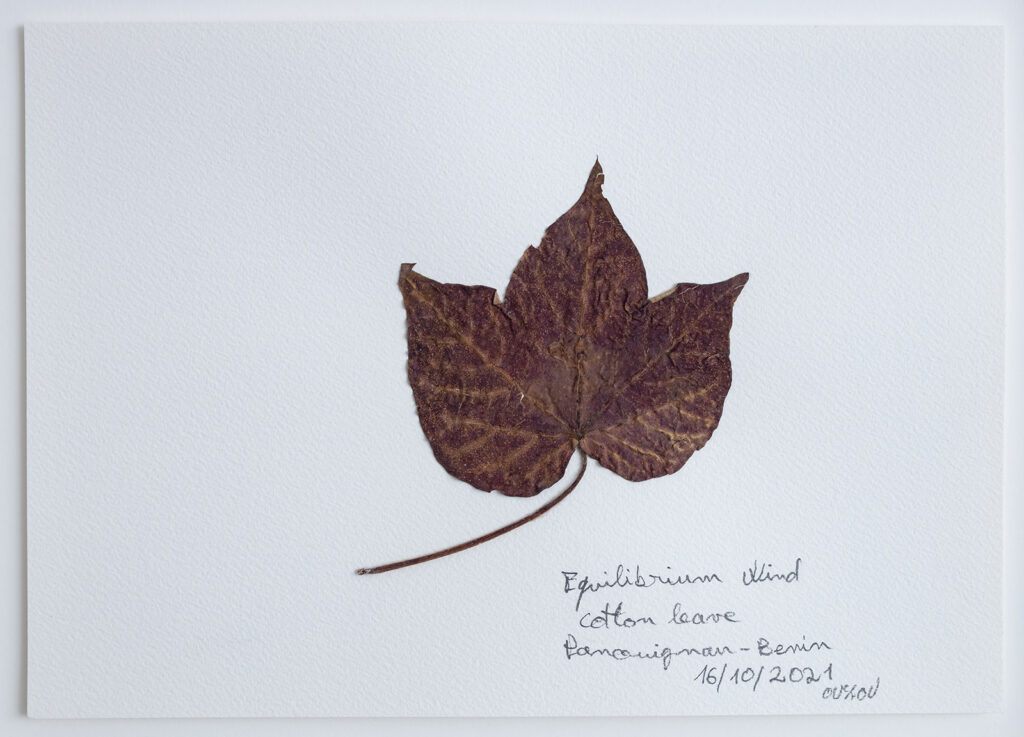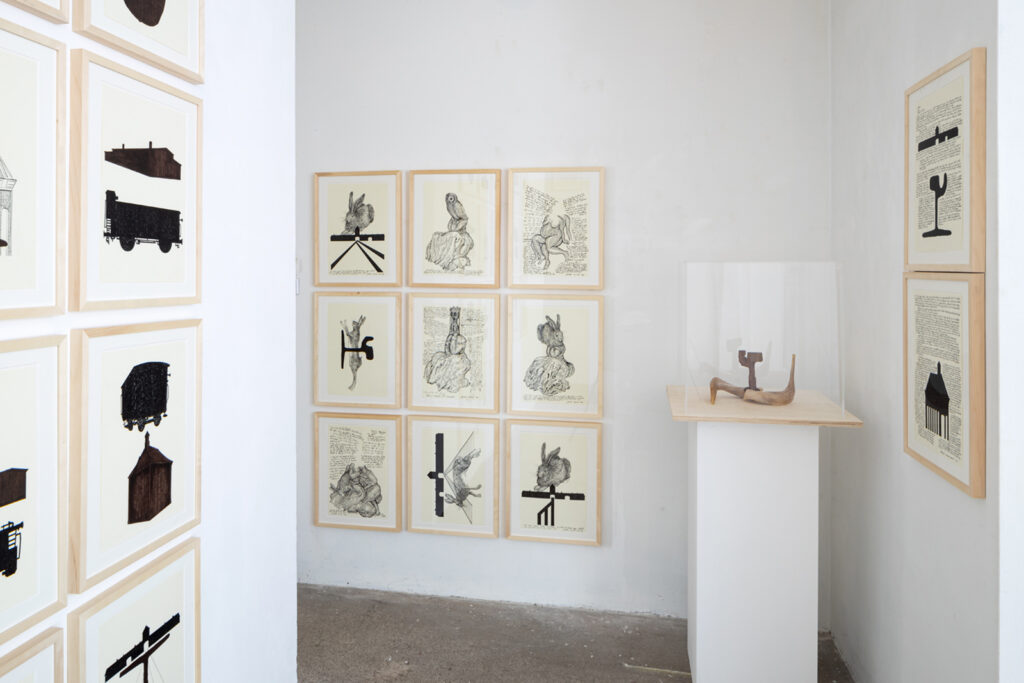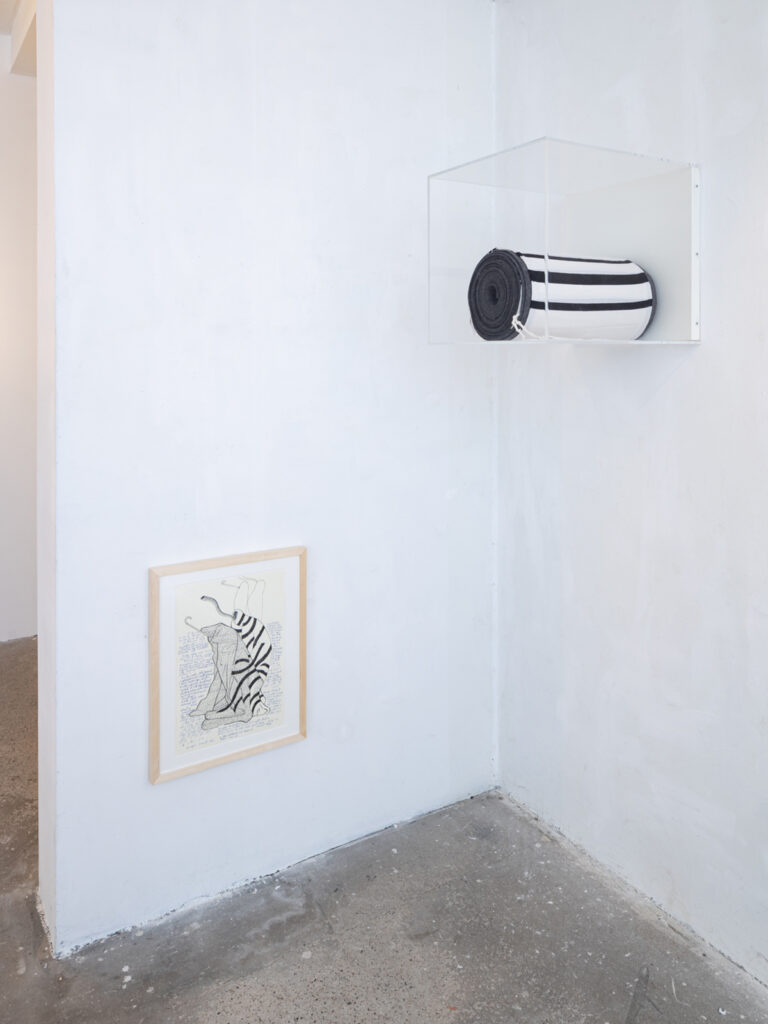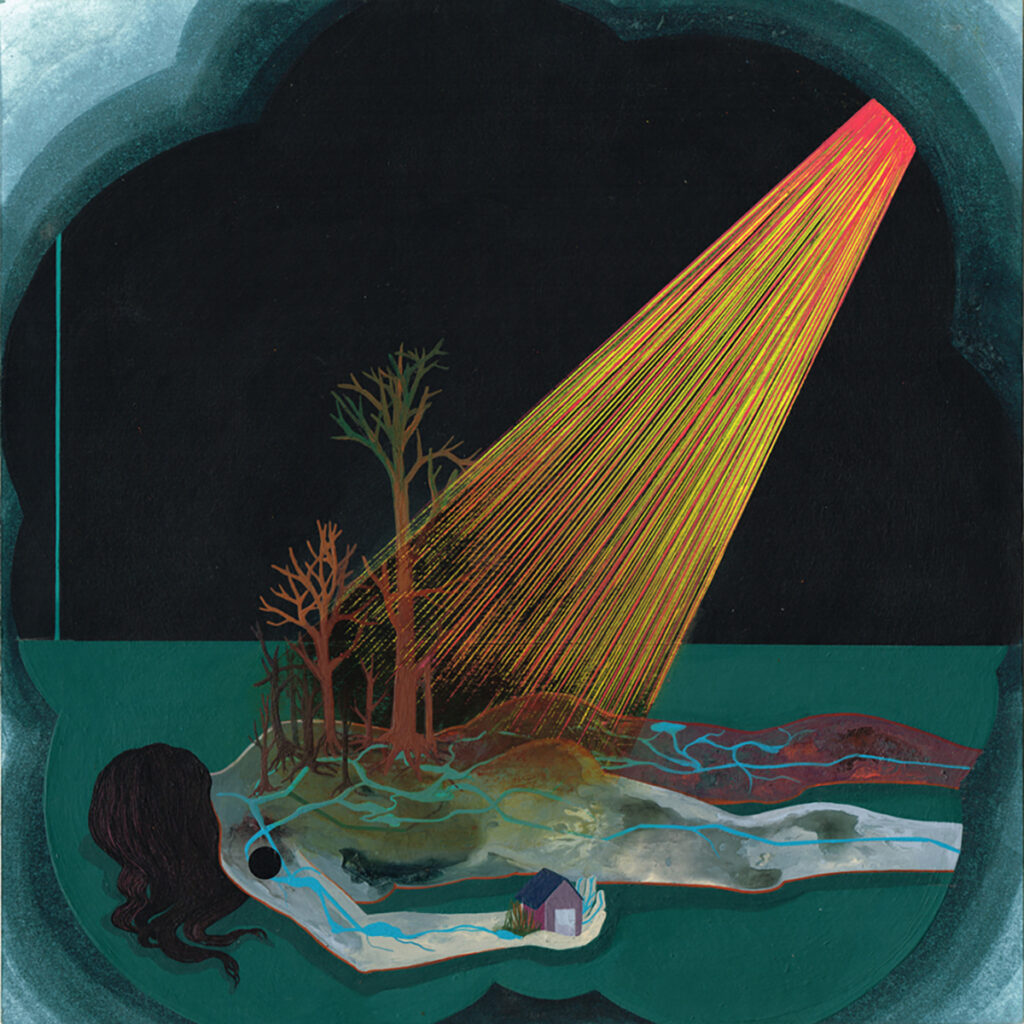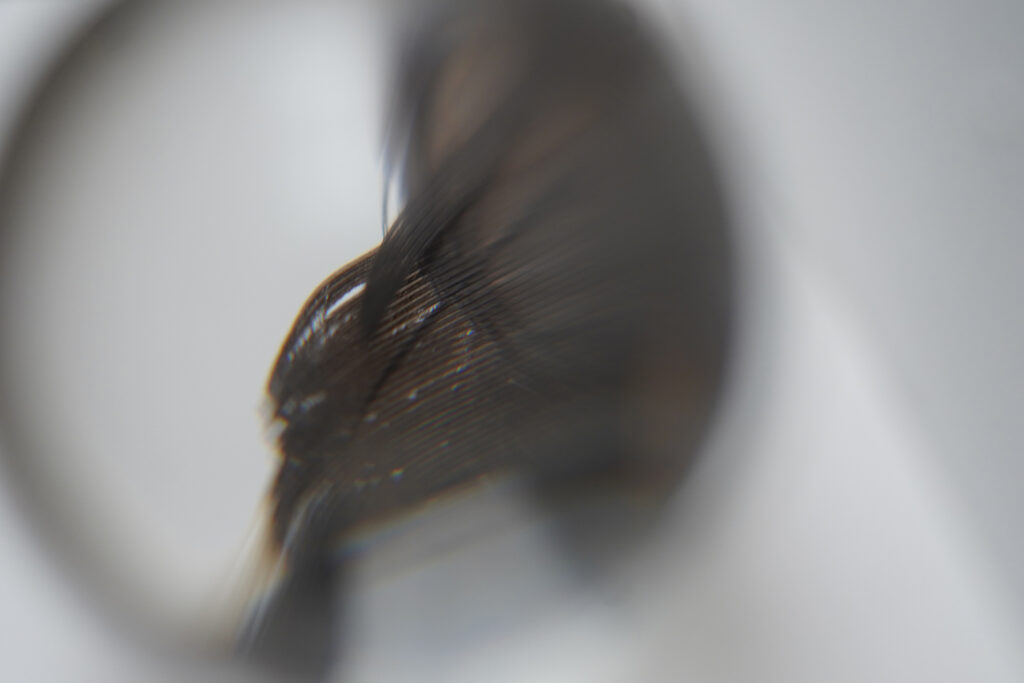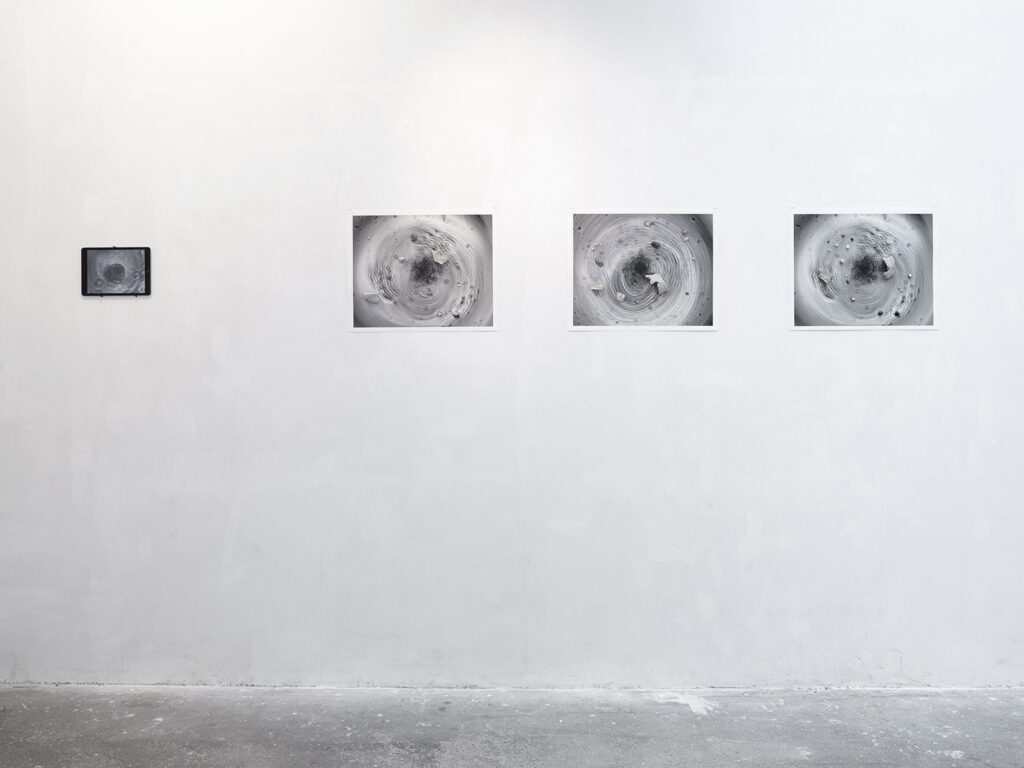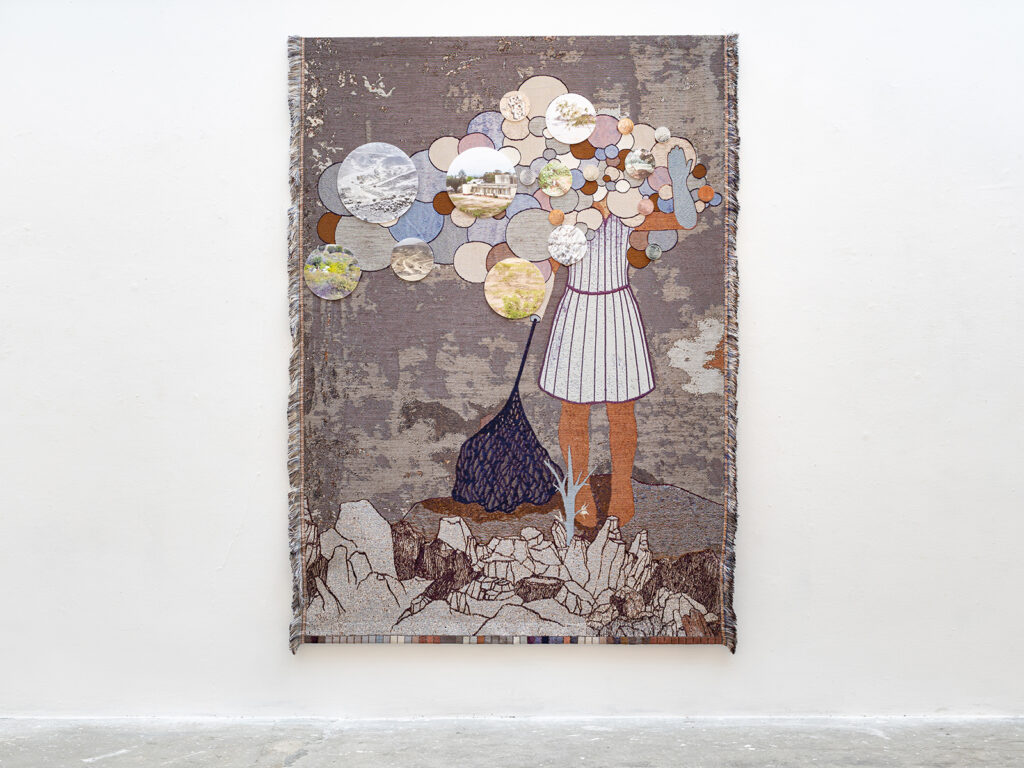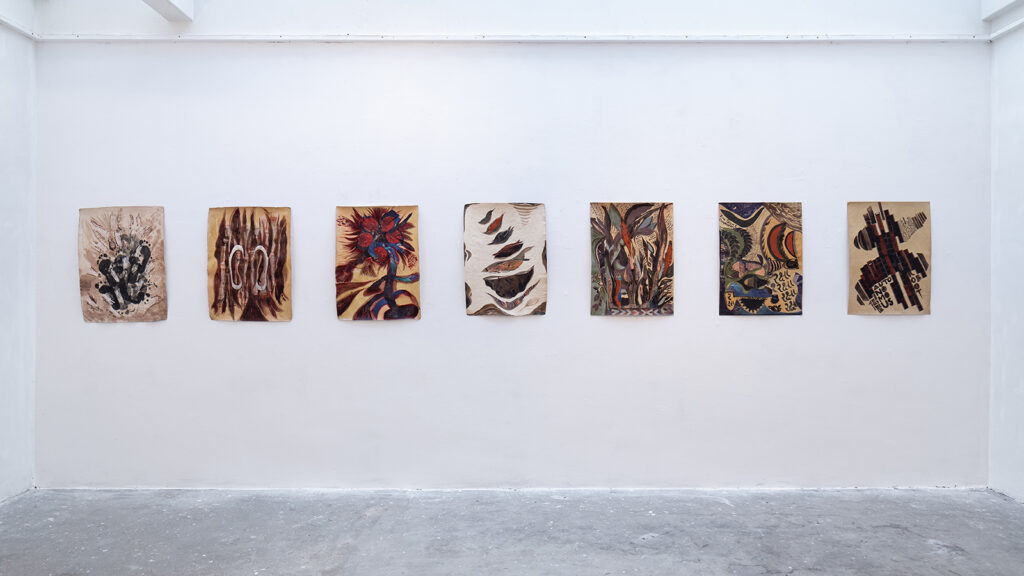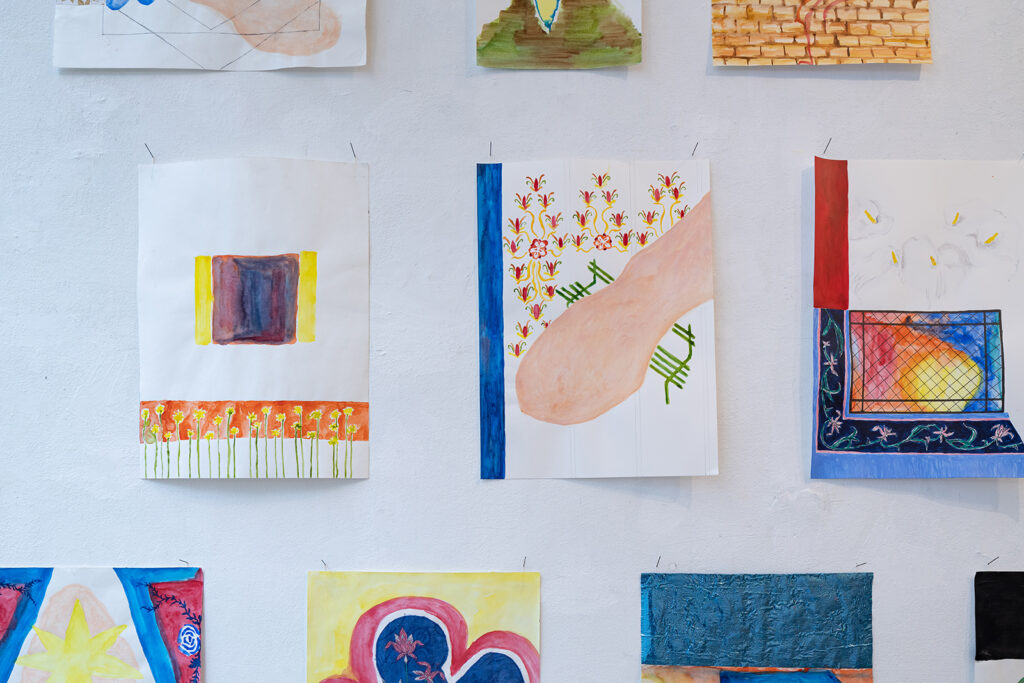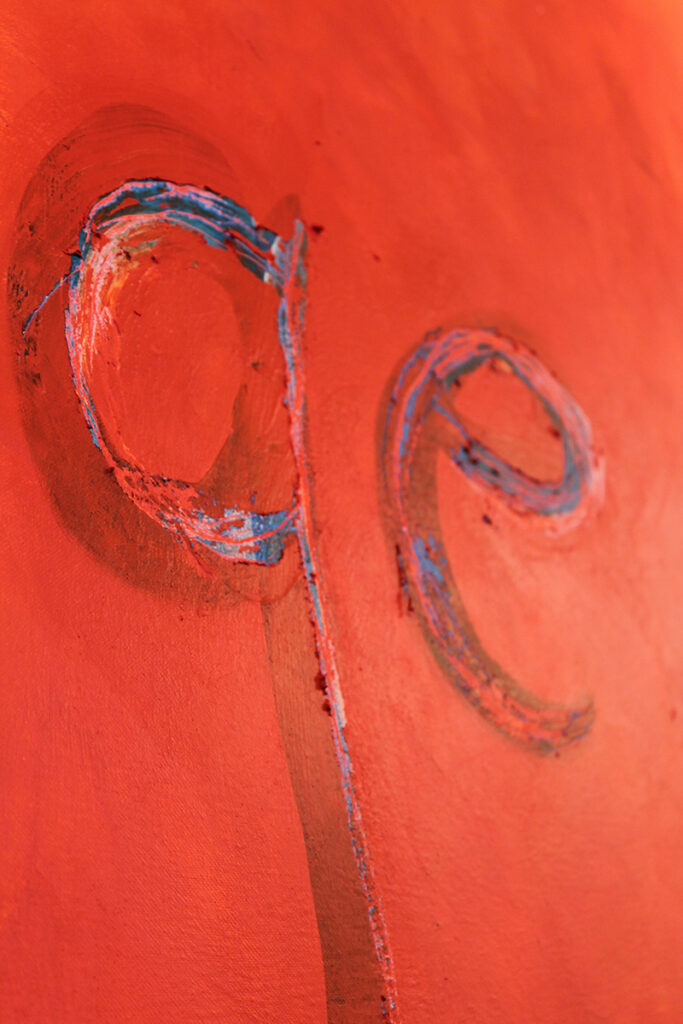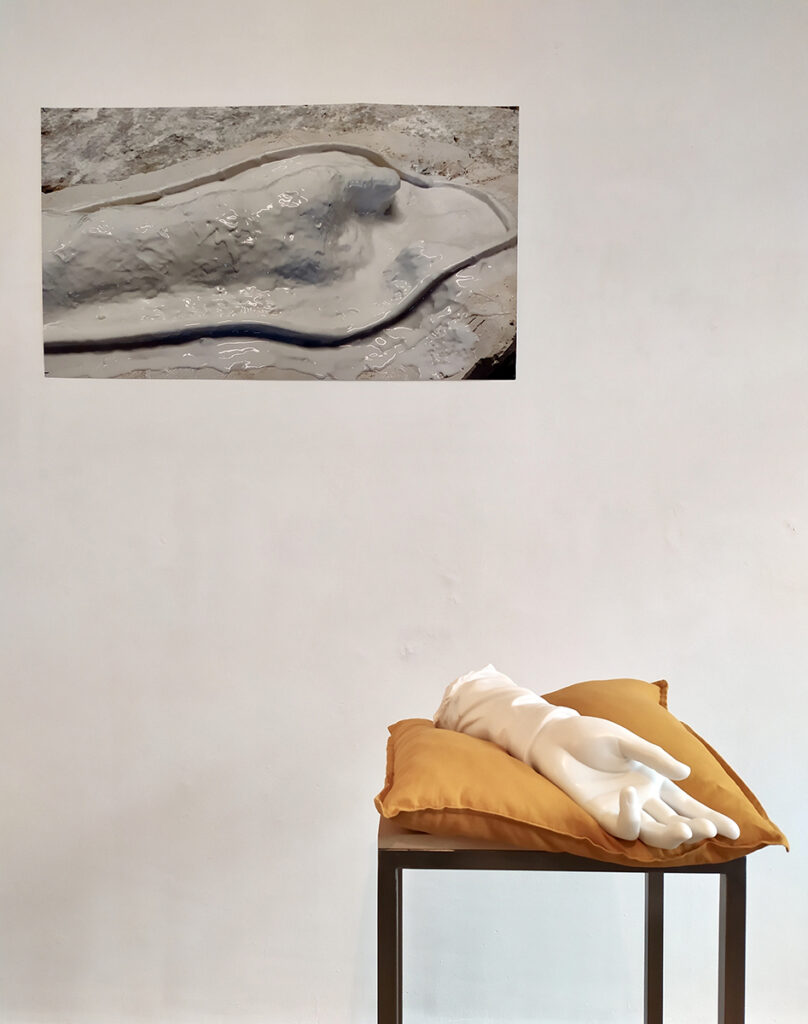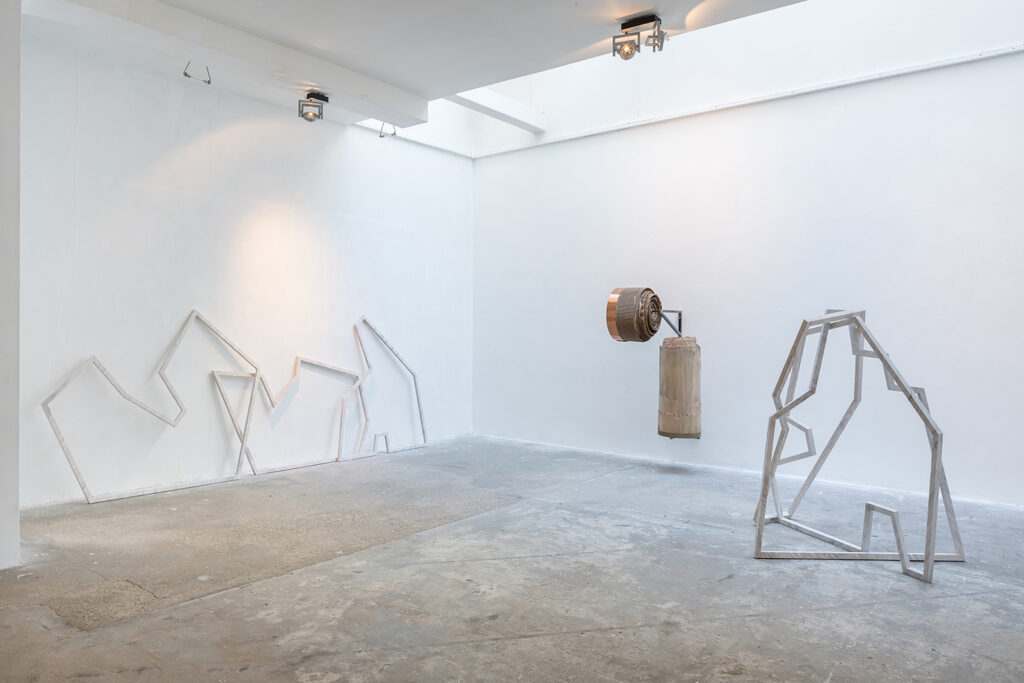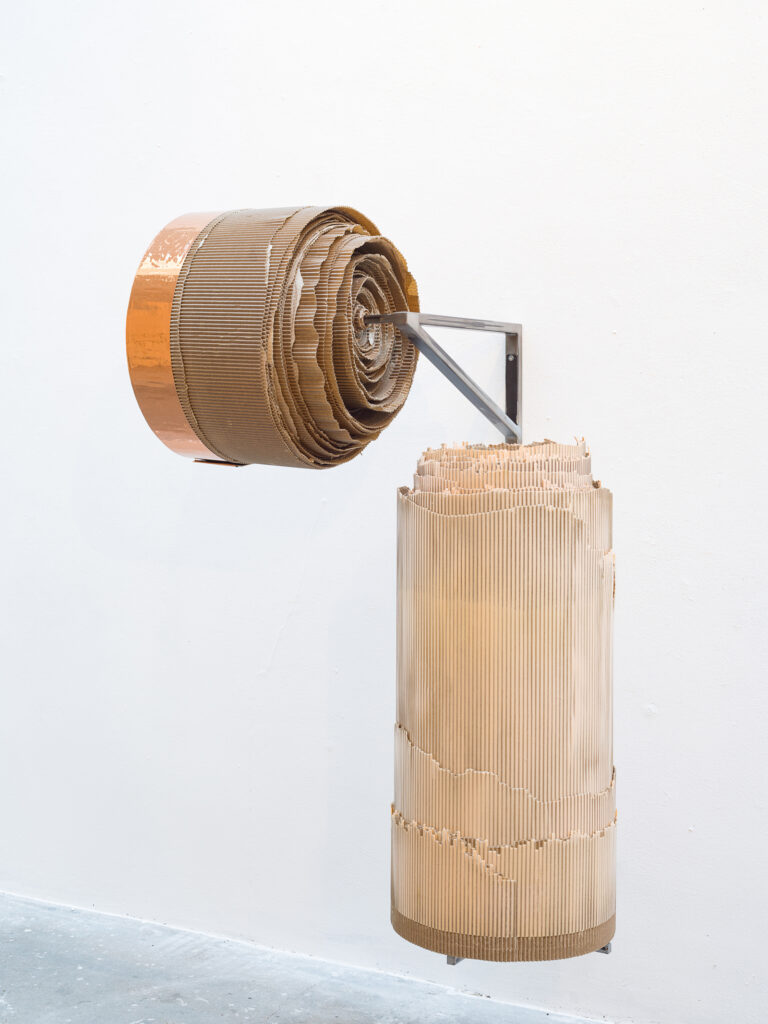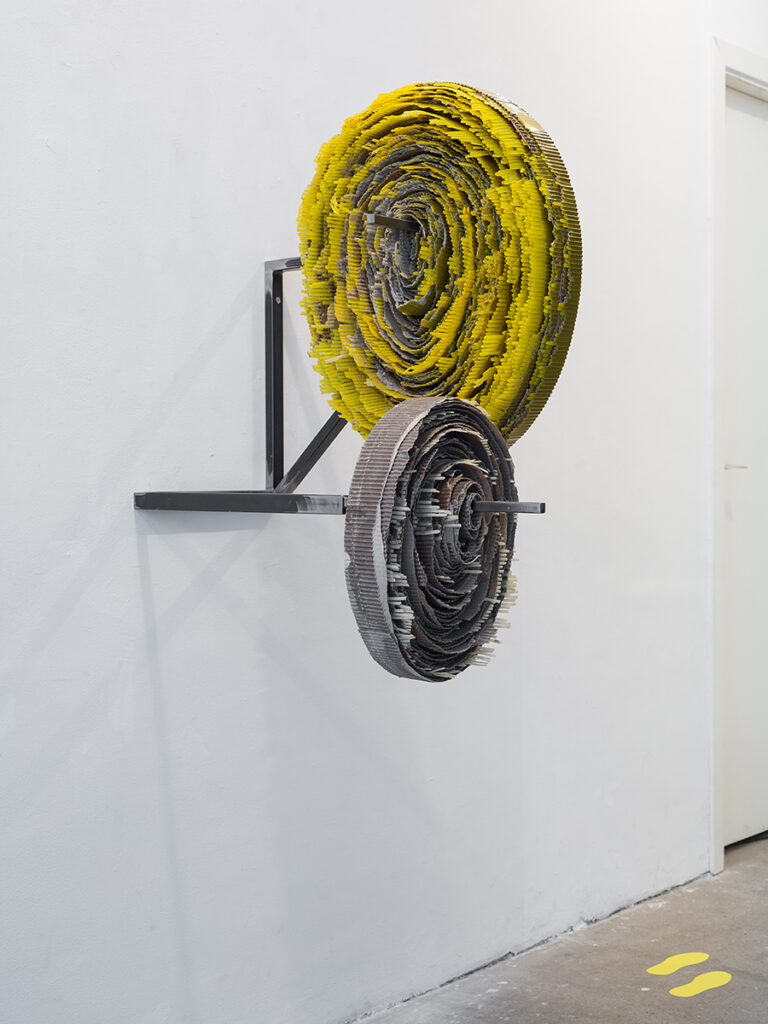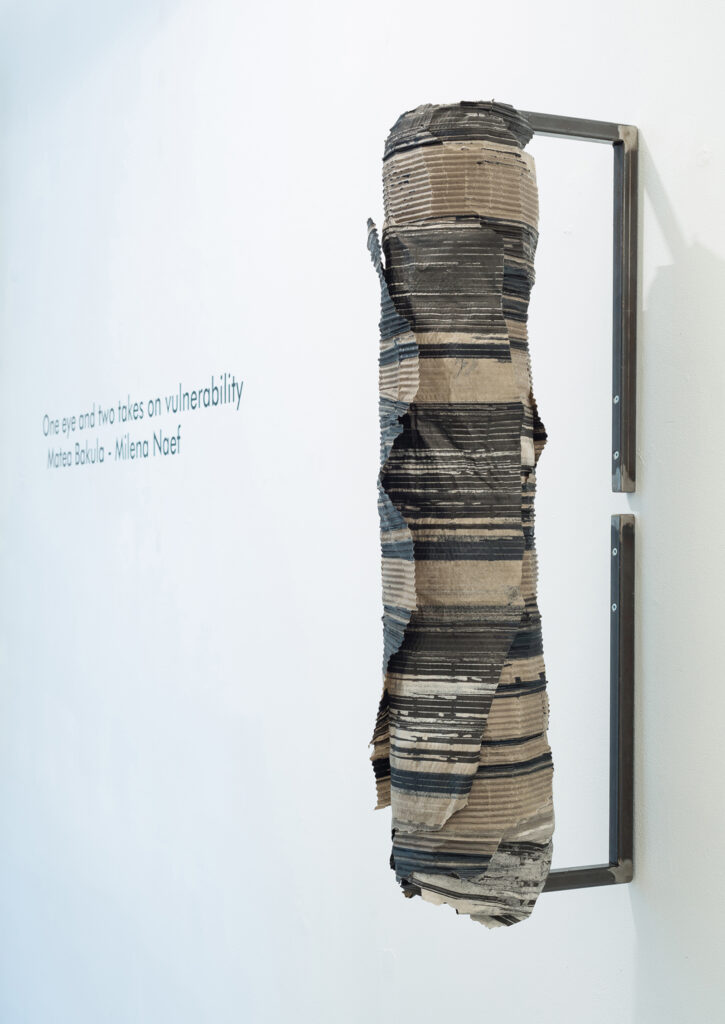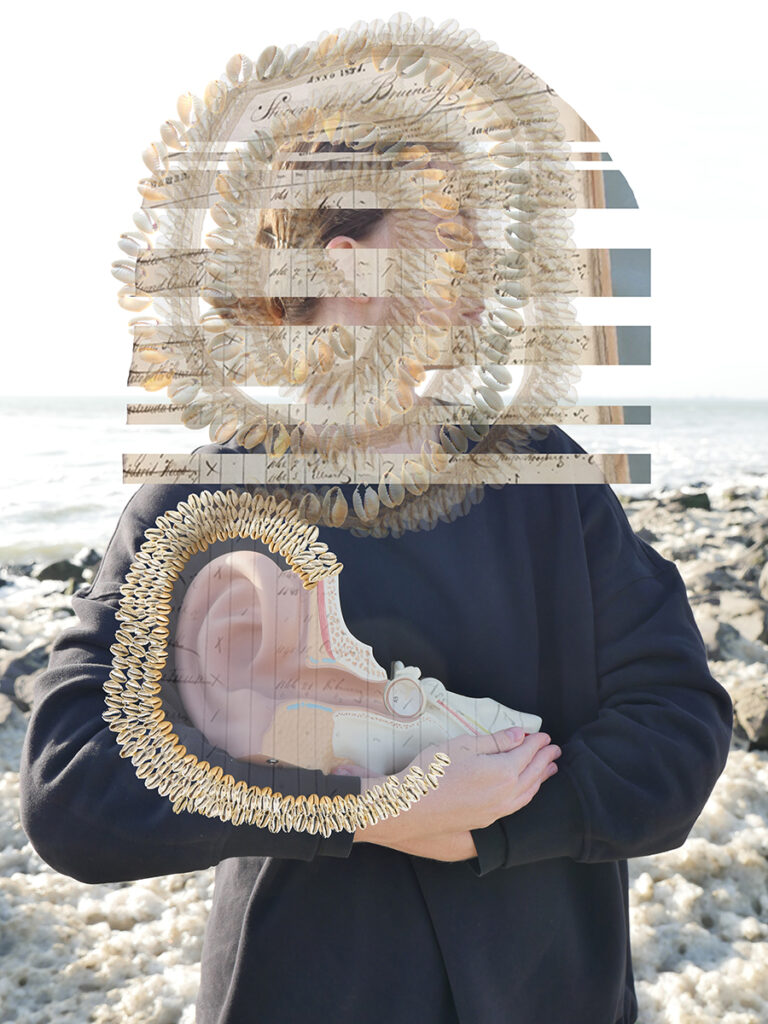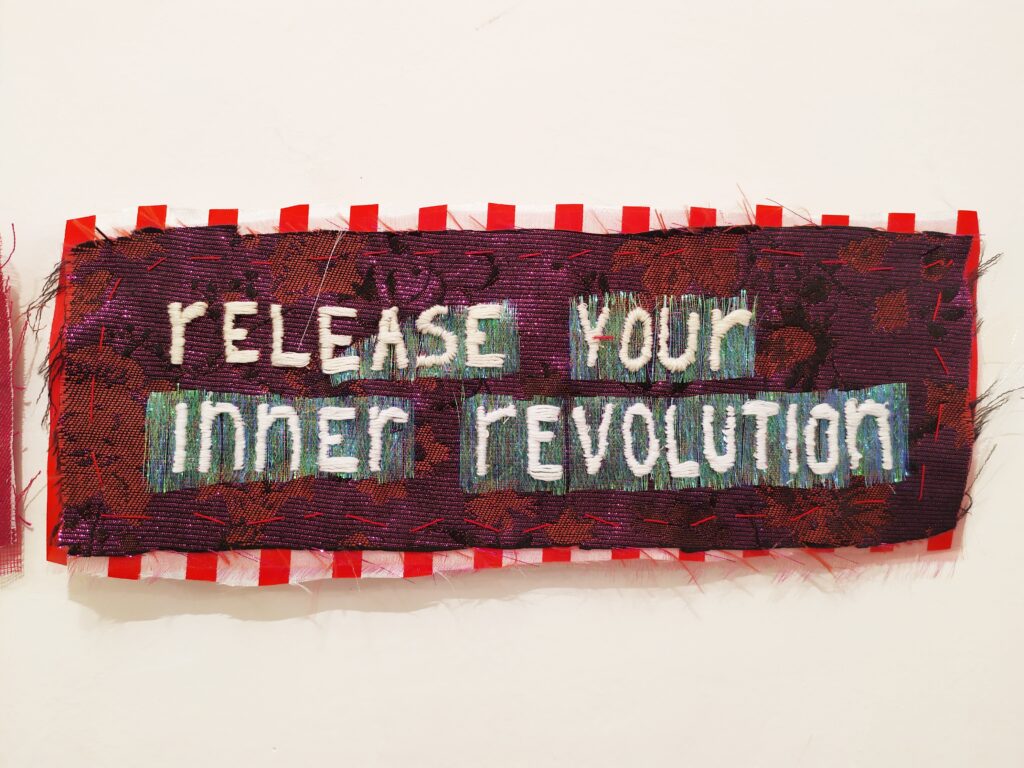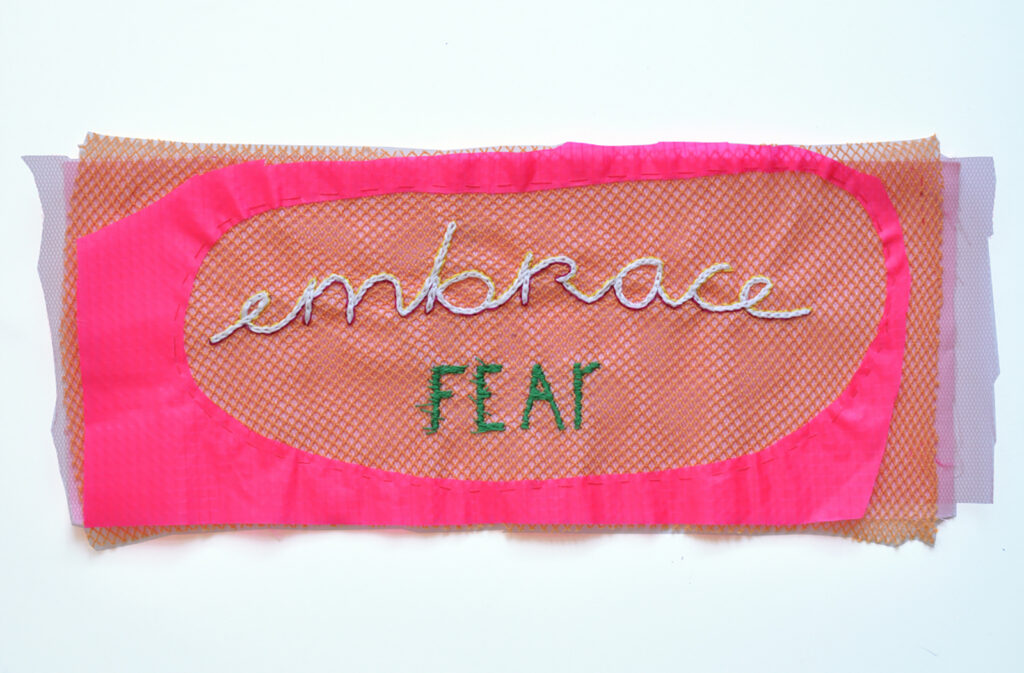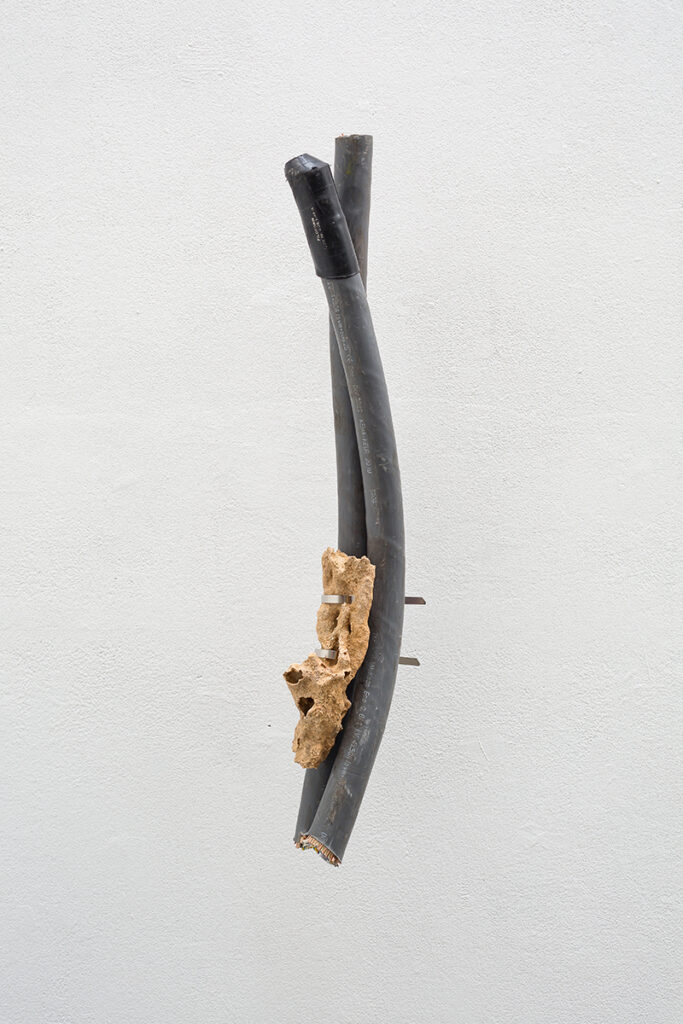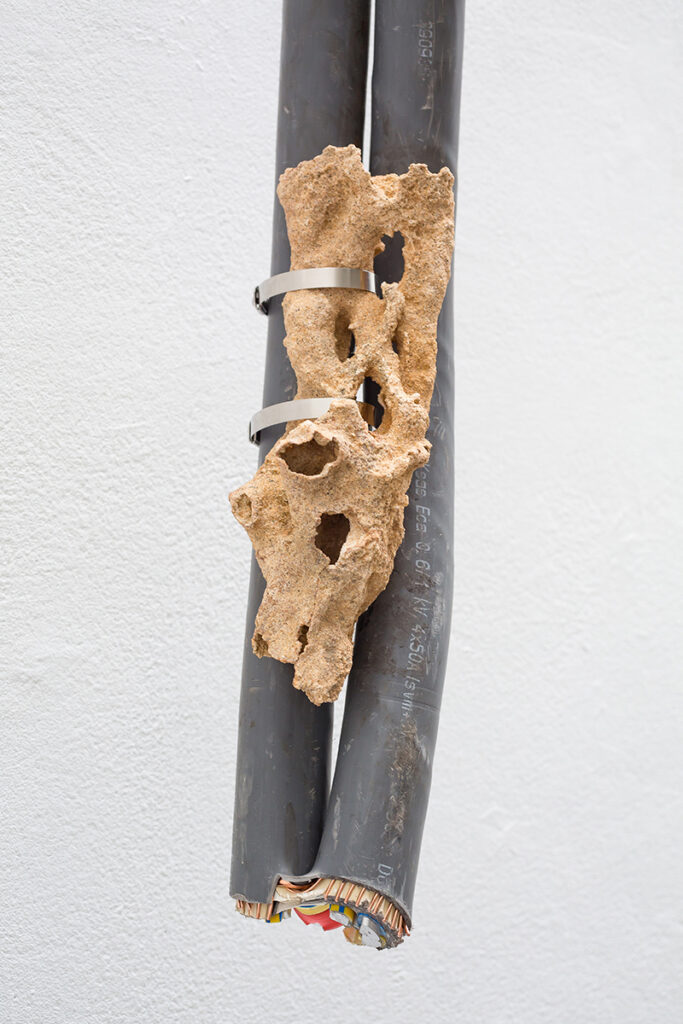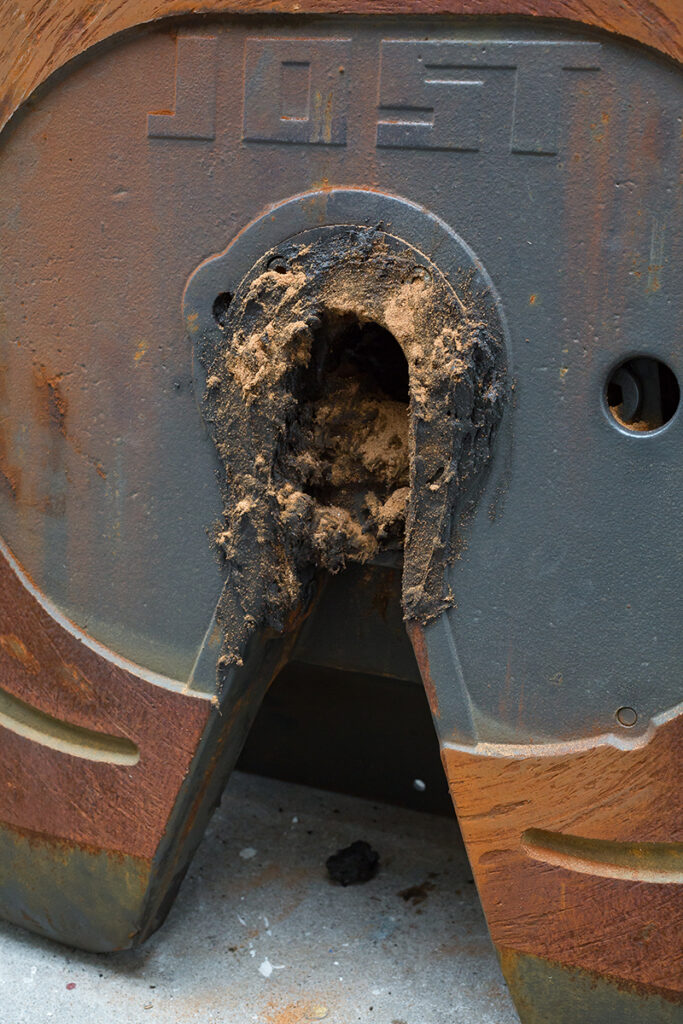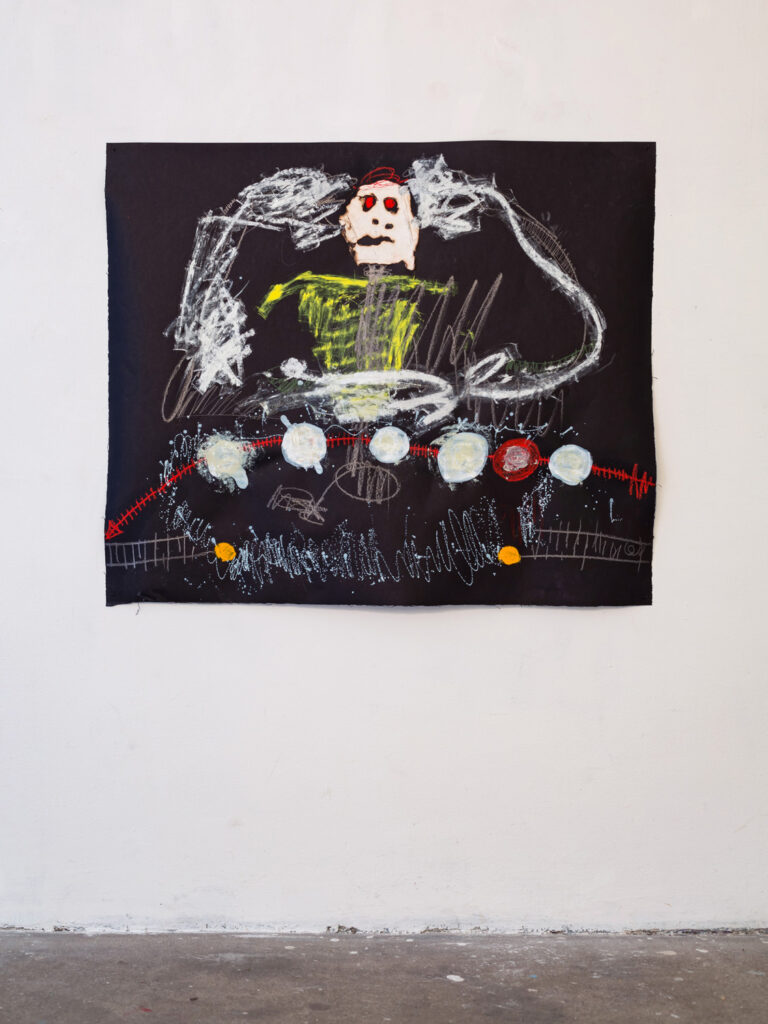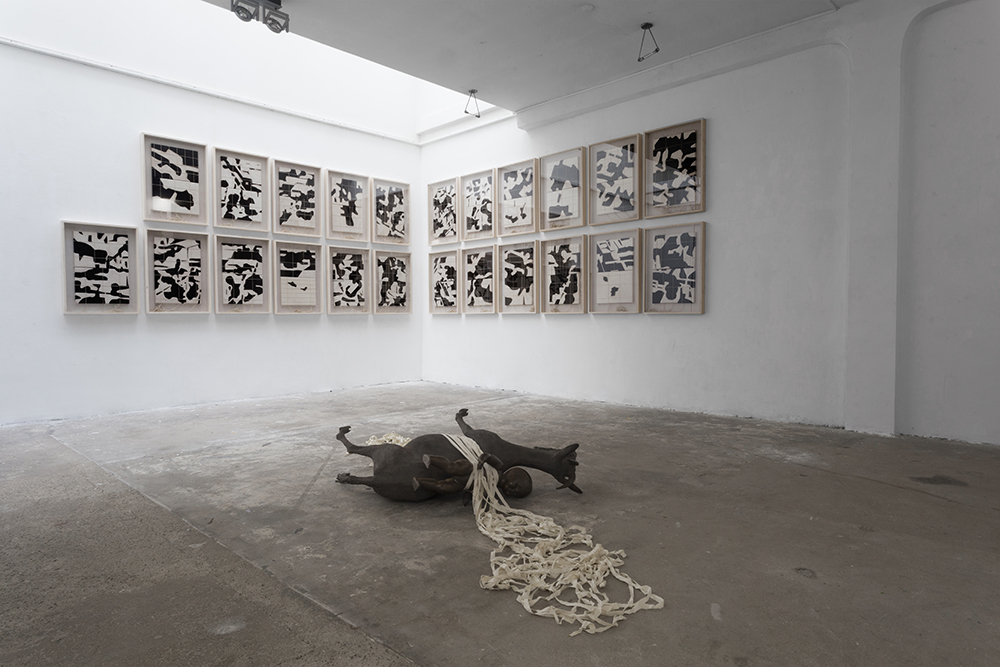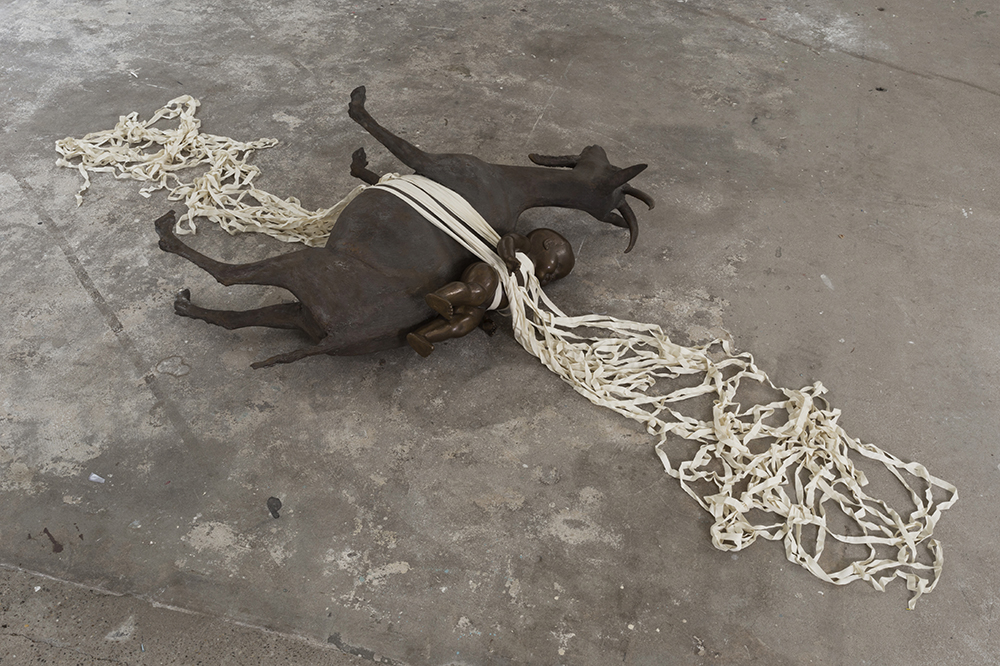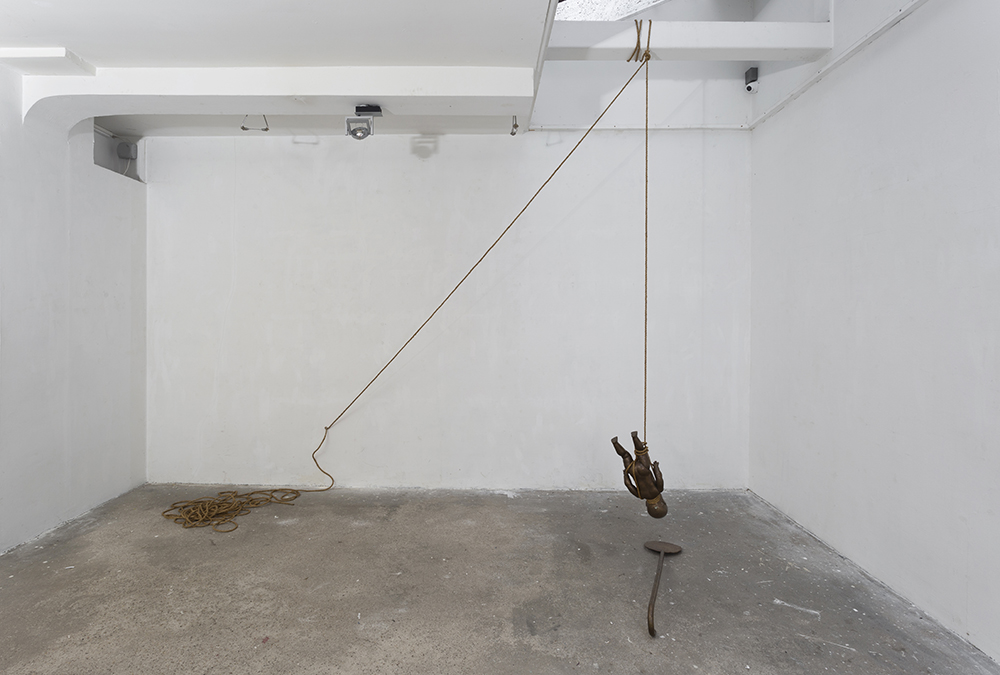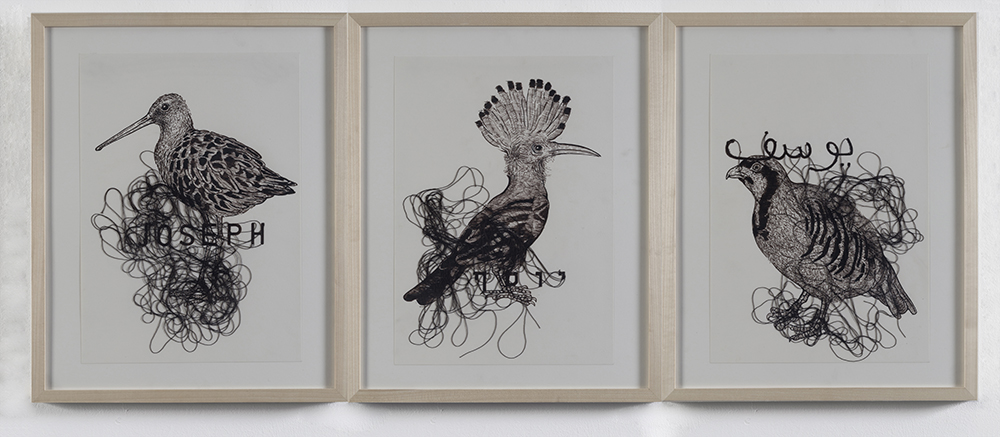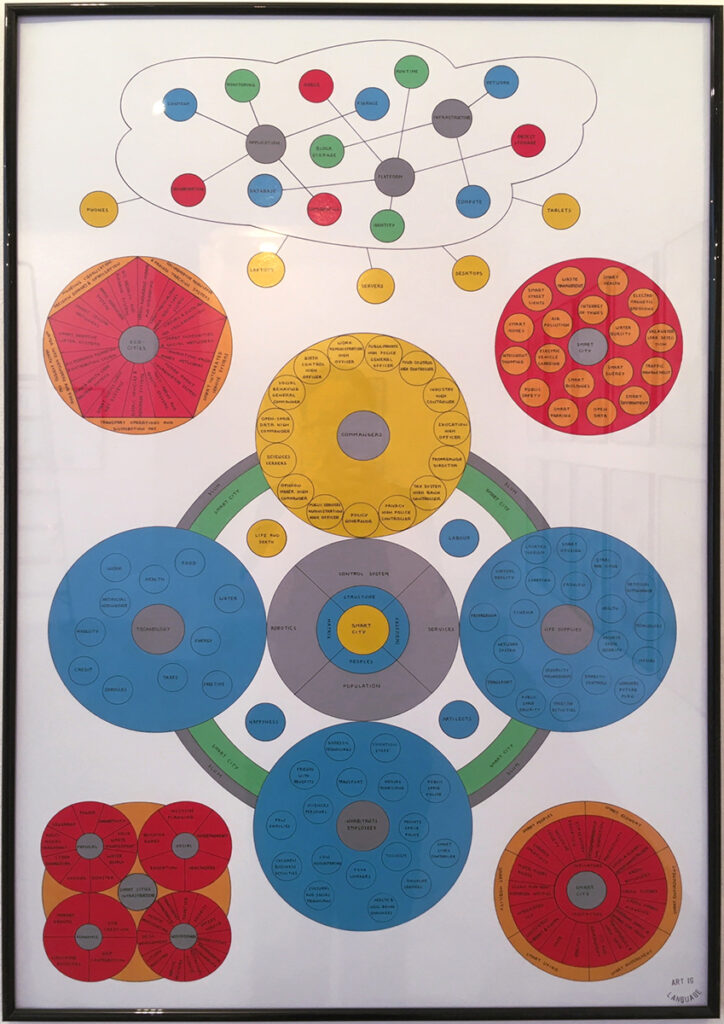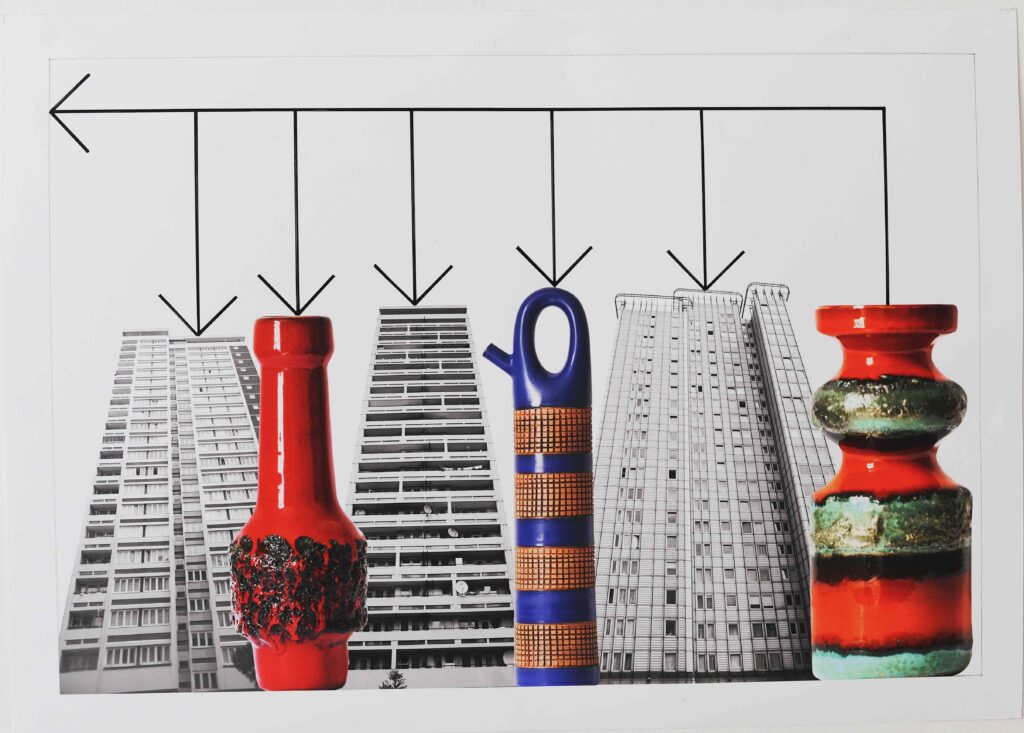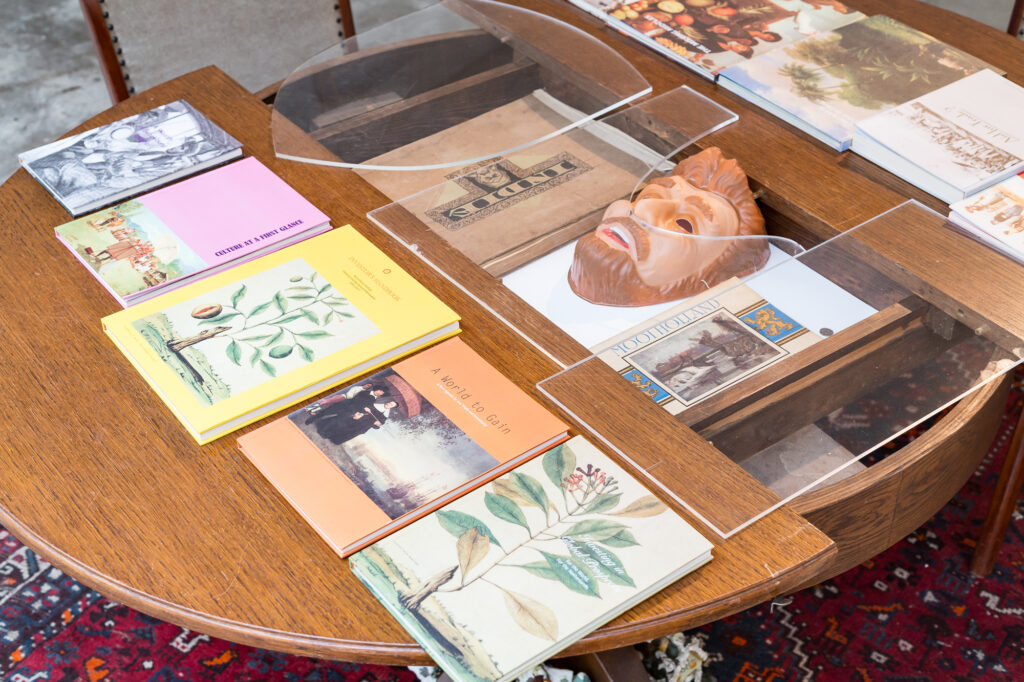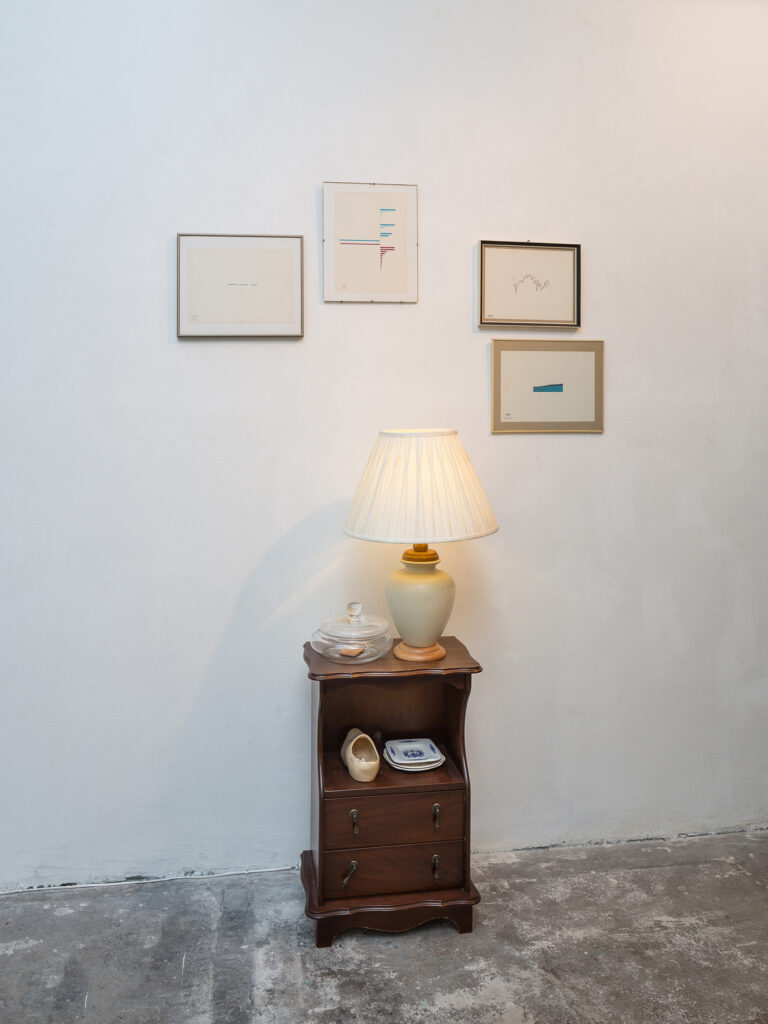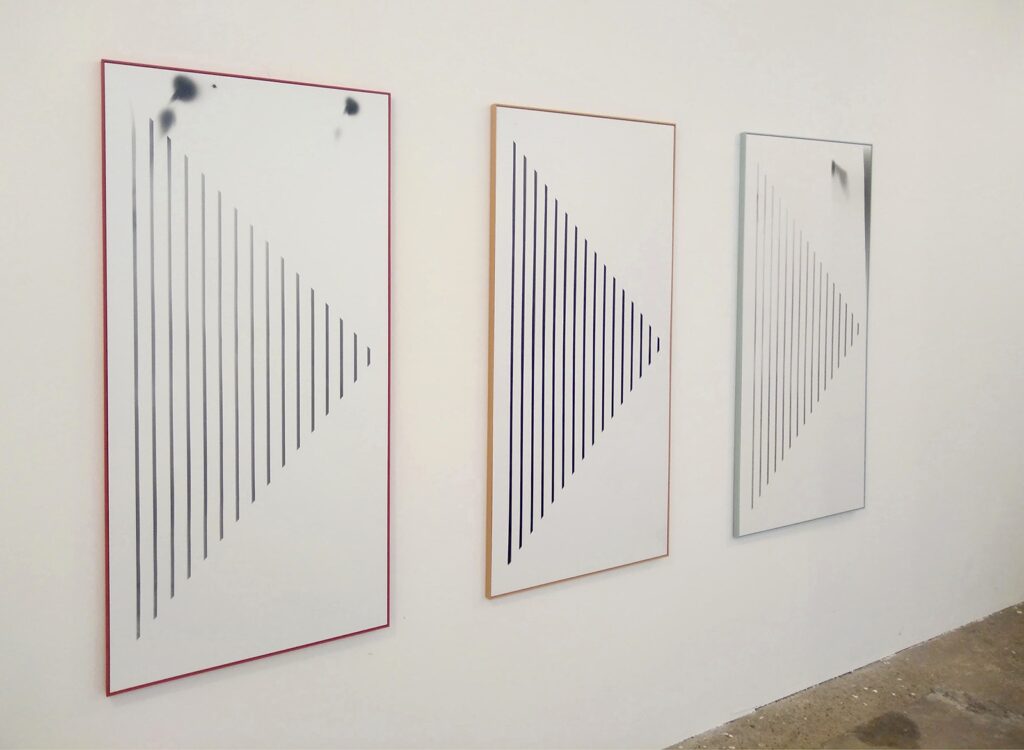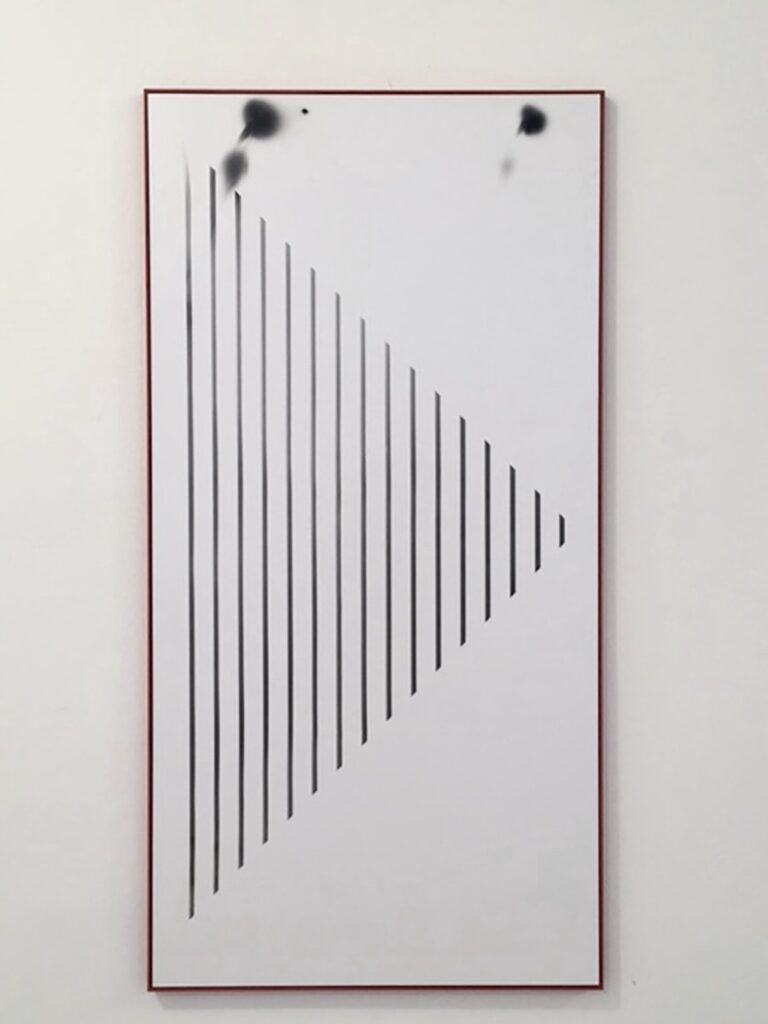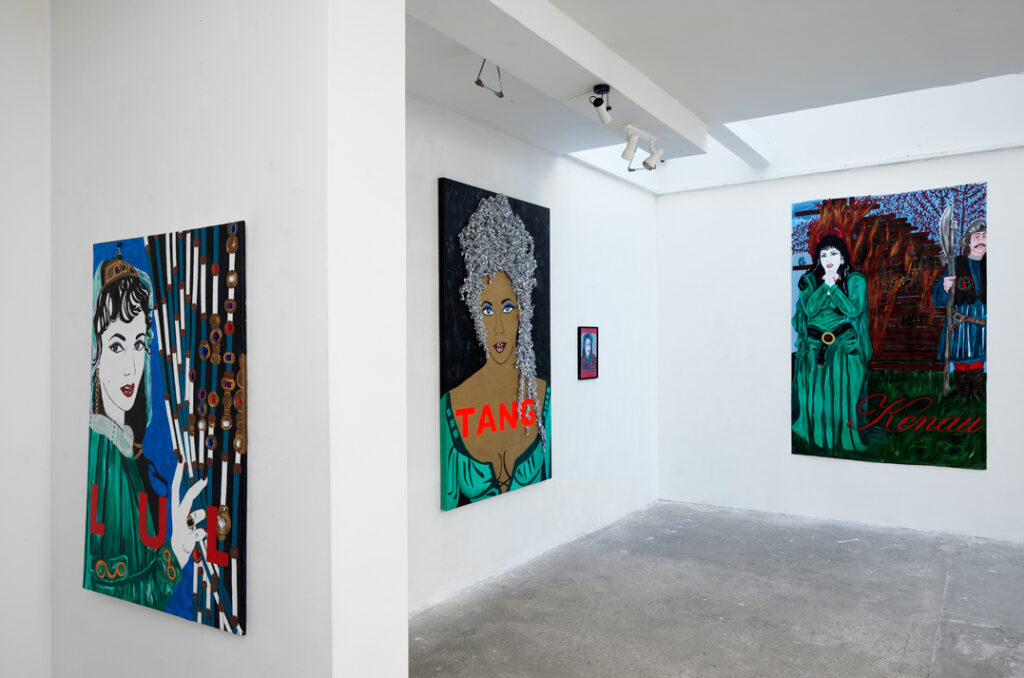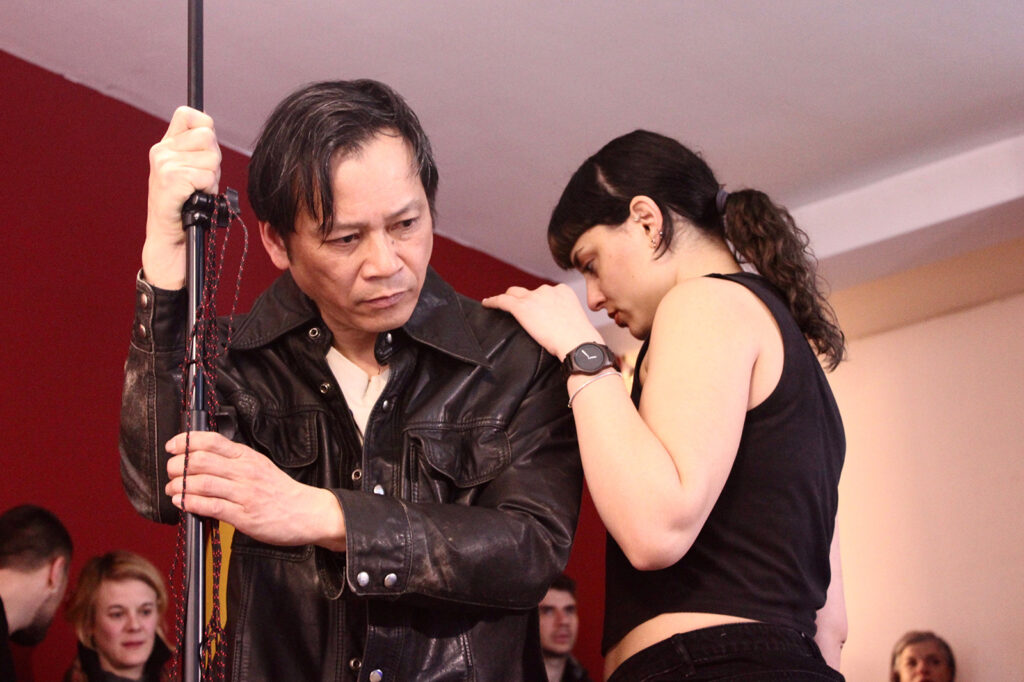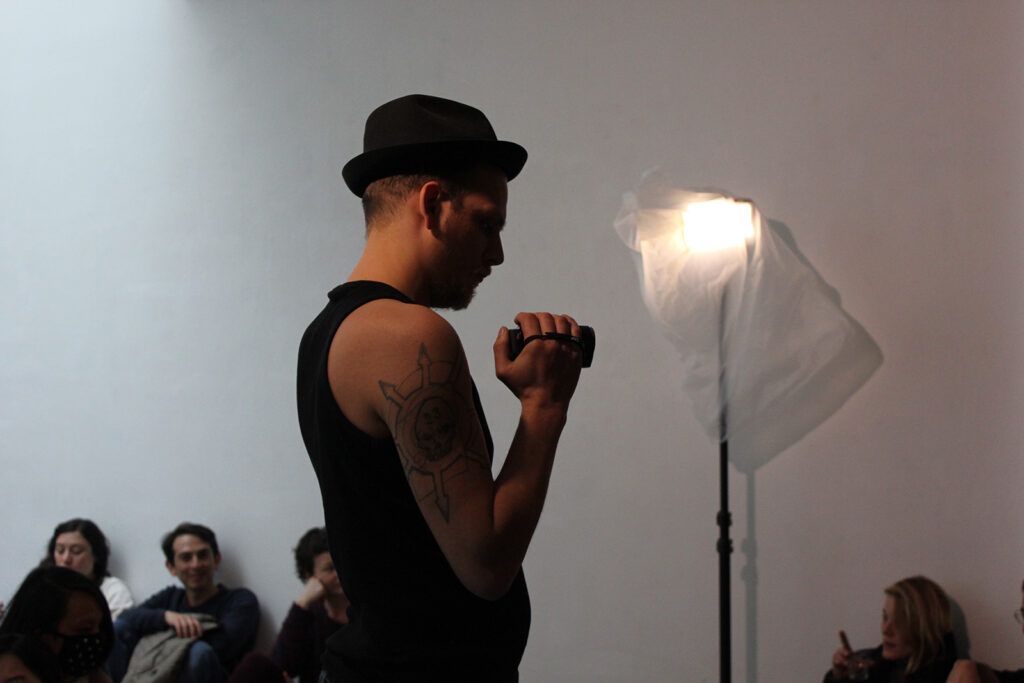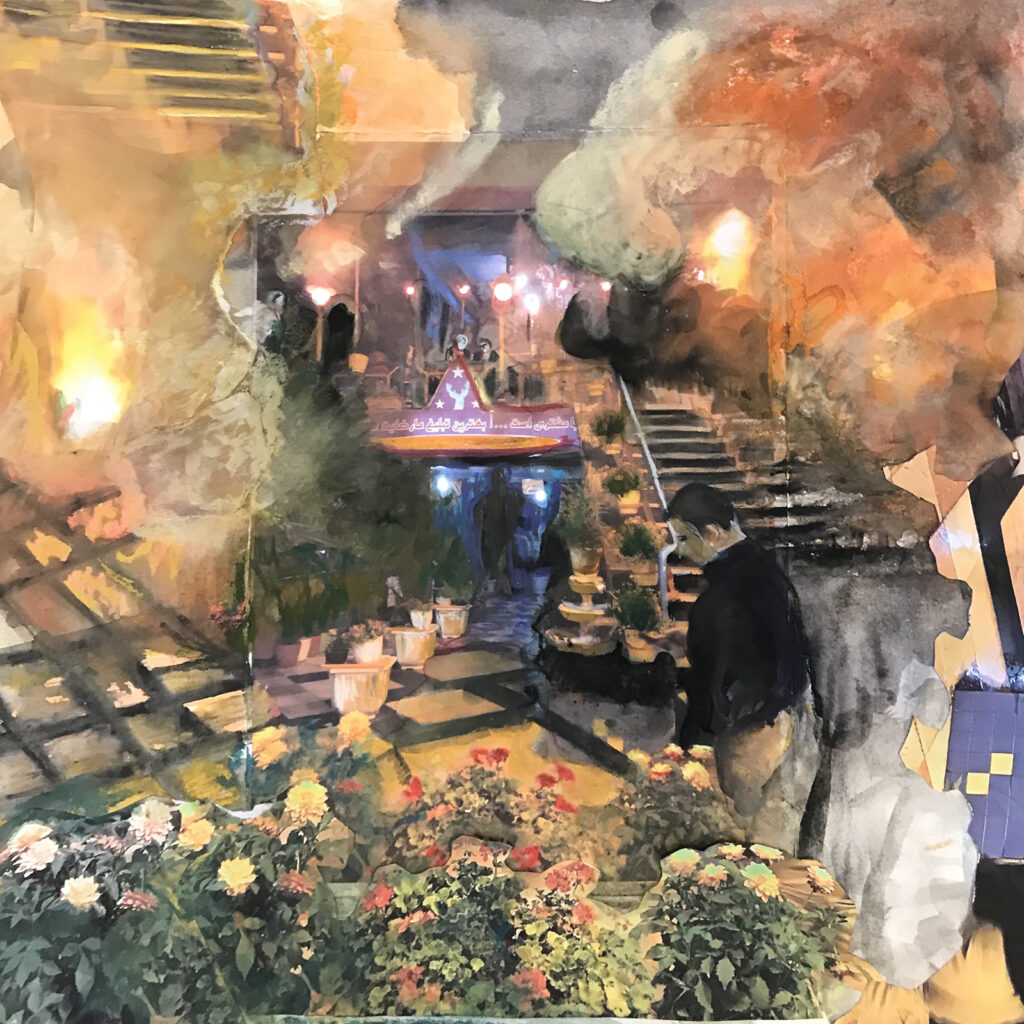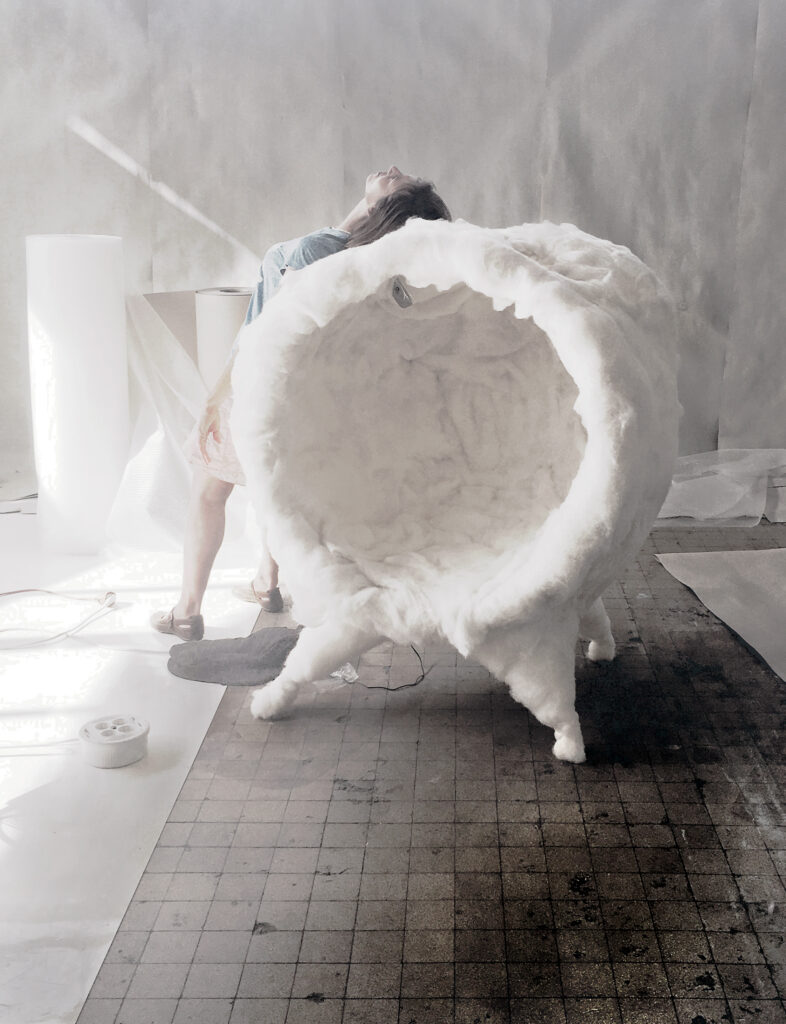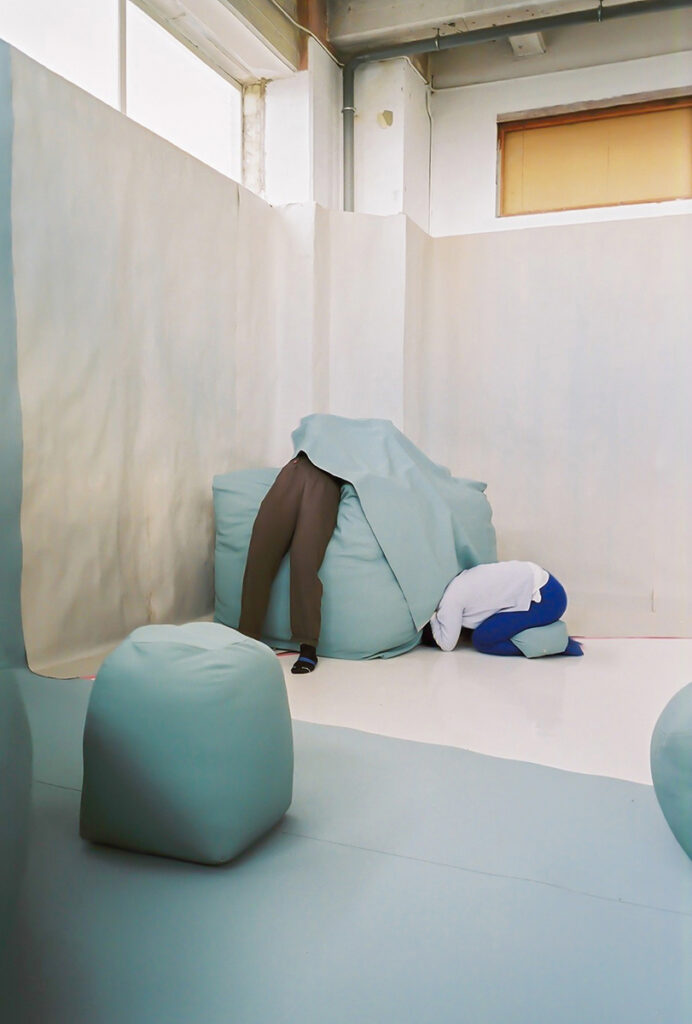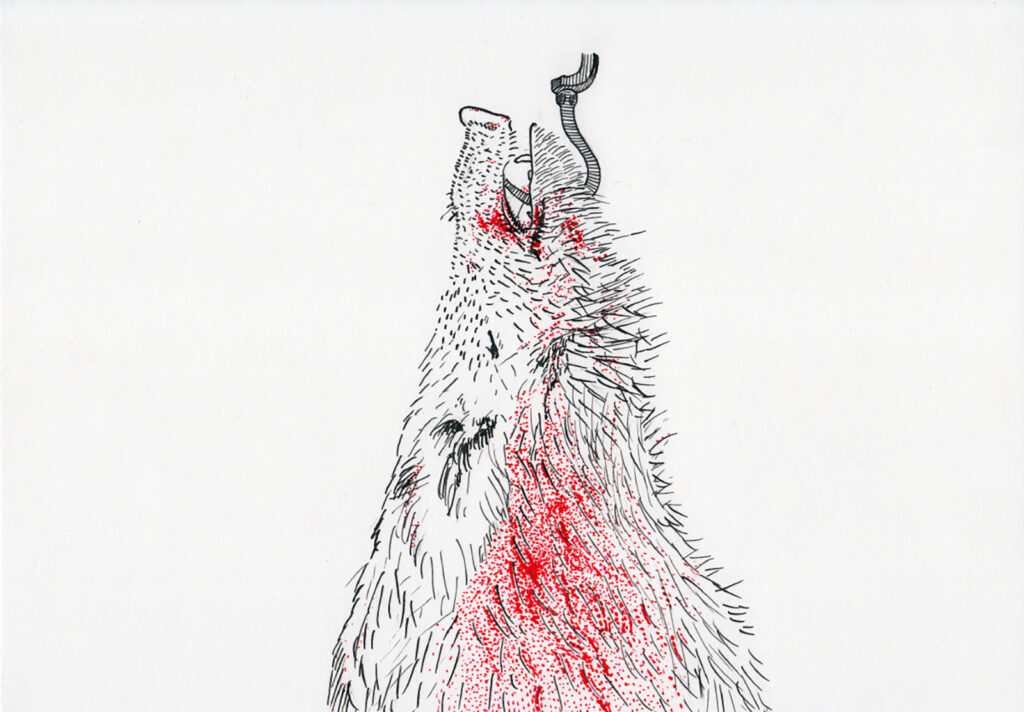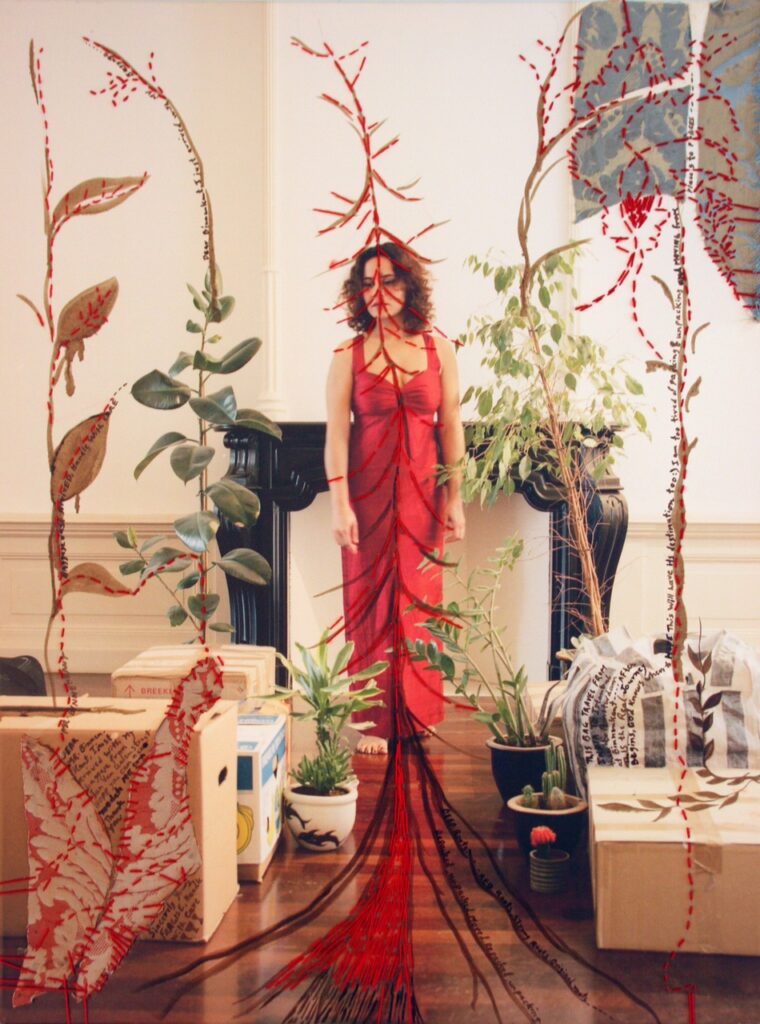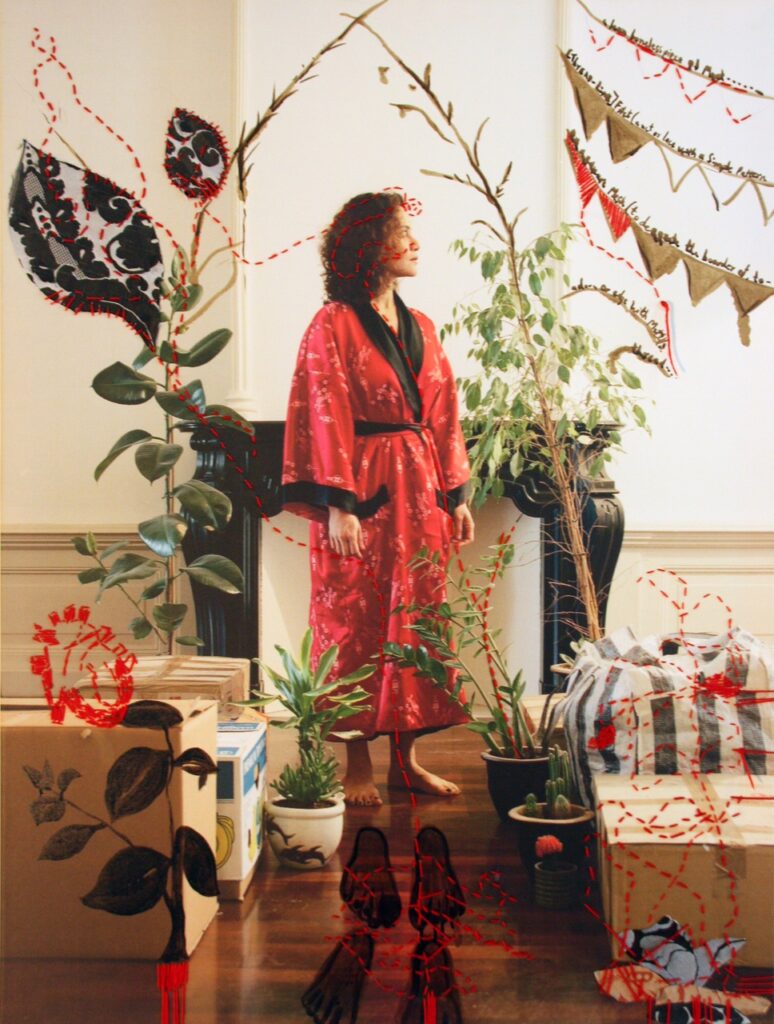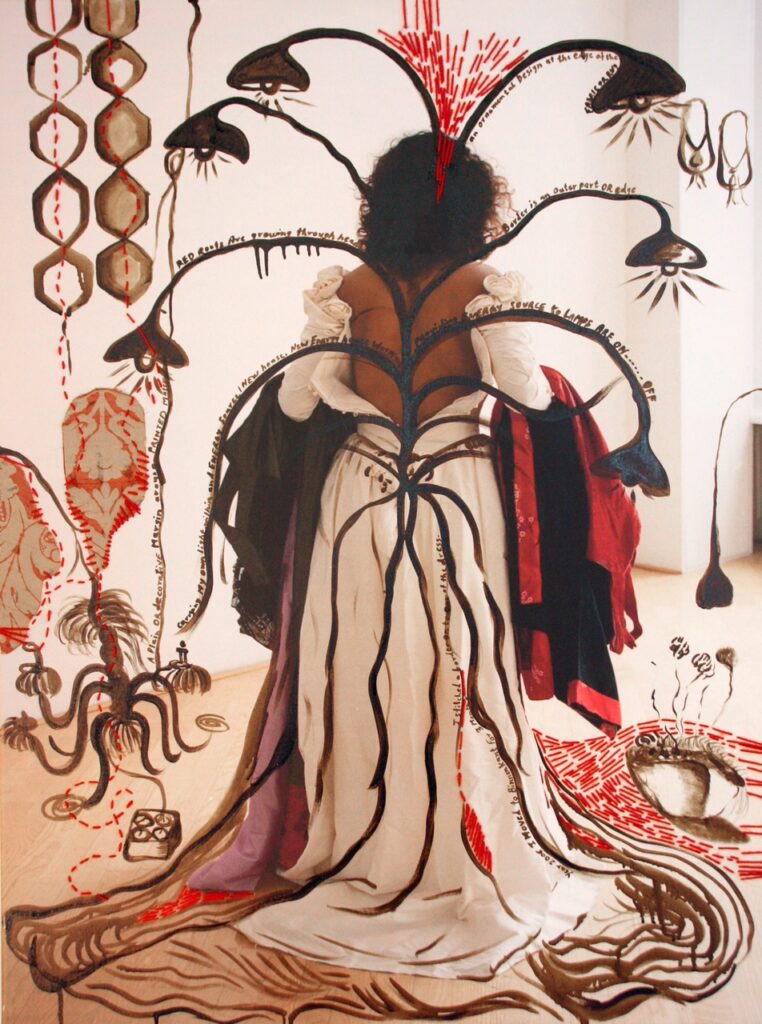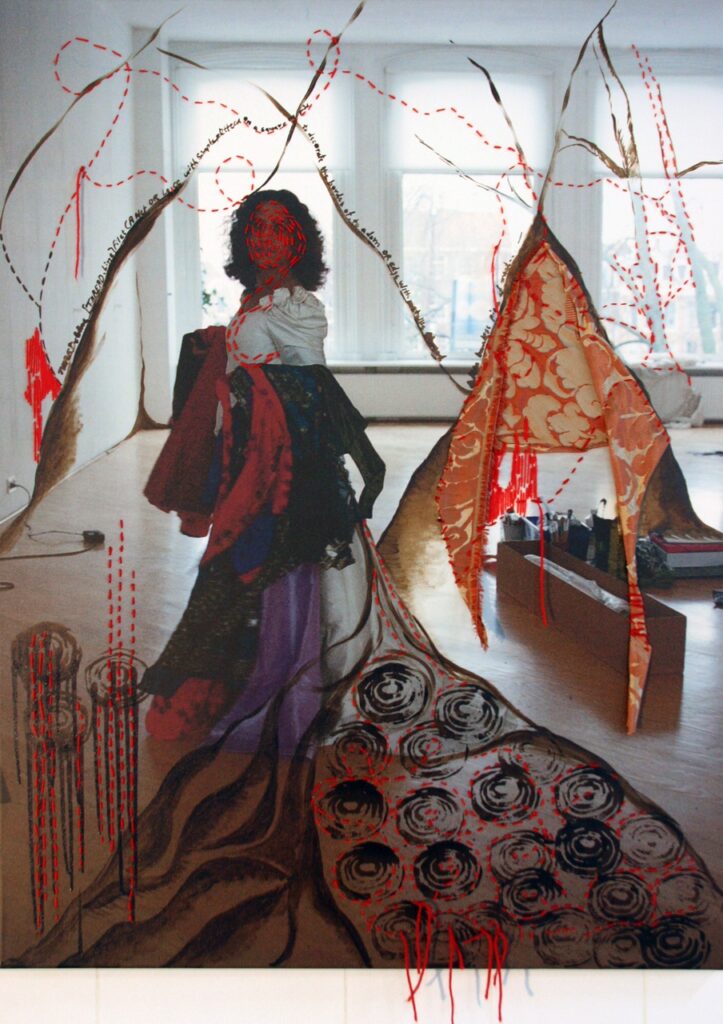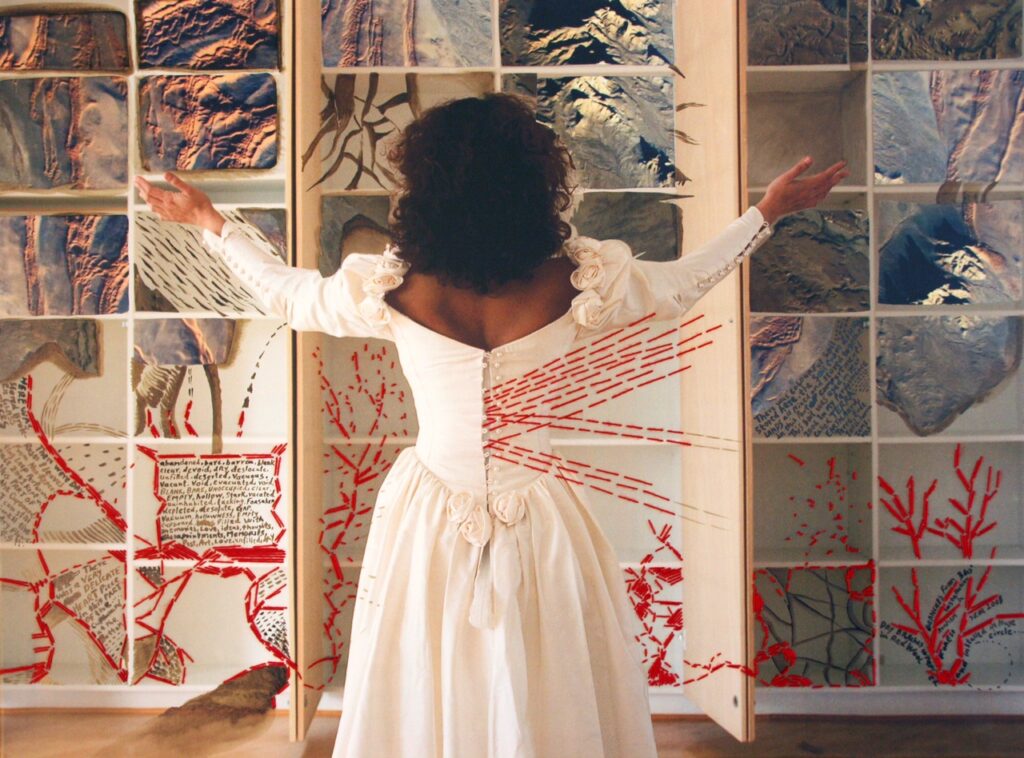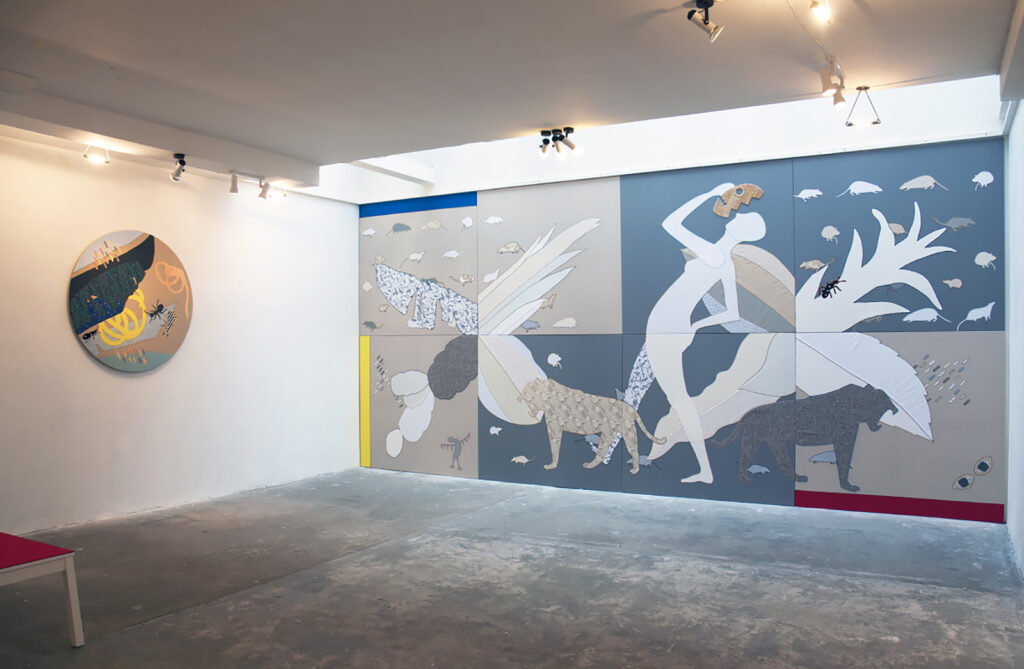- CURRENT EXHIBITIONS
- Art Island 202417 - 19 May, 2024with Atousa Bandeh, Phil Bloom, Dianne Hagen and Jens PfeiferInfoFrom 17 until 19 May, Lumen Travo Gallery brings to the suggestive location of Forteiland IJmuiden a selection of works on paper by artists Atousa Bandeh, Phil Bloom, Dianne Hagen, and Jens Pfeifer.
The works presented are rooted in the realms of dreams, the subconscious, nature, animals, and the symbolic meaning attached to everyday items. Ranging from abstract to figurative, encompassing drawings, paintings, collages, and prints, this presentation offers a glimpse into the world of two-dimensional art.
Come visit us at booth 9. CURRENT EXHIBITIONS - The Crow Messengers19 April - 18 May, 2024A solo show by Judith WesterveldInfoIn the solo exhibition, The Crow Messengers, Judith Westerveld presents a new body of work based on narratives told in the Southern African San languages |xam and !xun that form part of the Bleek and Lloyd Archive that was compiled in the 1870s and 1880s in Cape Town, South Africa. A testament to the lives and cultural practices of |xam and !xun people, the archive also provides a unique and rare insight into the impact of the Dutch colonization of South Africa.
Engaging different media such as film, watercolour paintings, photocollages, prints, sculptural installation and performance, Westerveld brings the archive and the colonial history it harbours into the present, and offers a glimpse of the unique way in which the narrators saw the world.
Join us for the festive opening of the exhibition on Friday 19th of April from 17.00 to 19.00 hrs. During the opening Judith Westereld will give an introduction to the exhibition and the Bleek and Lloyd Archive, at the hand of the artist publication she has recently made. PAST EXHIBITIONS - Works on Paper (Dreamscapes and other places) | group showWith Atousa Bandeh, Phil Bloom, Dianne Hagen, Monali Meher, Jens Pfeifer. OPENING : 15 March, 5-7 PM.InfoLumen Travo Gallery would like to invite you to the opening of the new group show, “Works on Paper (Dreamscapes and Other Places).” As the title suggests, this exhibition will exclusively feature works on paper by the following artists:
Atousa Bandeh (Iran, 1968)
Phil Bloom (NL, 1945) - whose work will debut at Lumen Travo Gallery
Dianne Hagen (NL, 1964)
Monali Meher (India, 1969)
Jens Pfeifer (NL, 1963)
The works presented draw inspiration from various sources: dreams and the subconscious, nature, animals, and the symbolic significance of everyday objects. Ranging from abstract to figurative, encompassing drawings, paintings, collages, and prints, this exhibition offers a rich exploration of the vibrant and multifaceted world of two-dimensional art.
Opening: Friday, March 15th, from 17:00 to 19:00 hrs. - Art Rotterdam 2024With Matea Bakula, Daniel de Paula, Otobong Nkanga and Thierry Oussou.InfoOn the occasion of Art Rotterdam 2024, Lumen Travo Gallery will proudly showcase the works of the following artists: Matea Bakula (1990, NL), Daniel de Paula (1987, Brazil), Otobong Nkanga (1974, Nigeria), Thierry Oussou (1989, Benin).
Despite their diverse backgrounds, practices, and use of various media, their works resonate in unexpected ways, pushing the boundaries of contemporary art and questioning the social infrastructures that shape our lives.
You can find us at booth 29, 1 - 4 February, 2024.Matea Bakula presents a series of small sculptures titled "To Gather" (2023), which results from the artist's fascination with fungi and their behaviour in their natural habitat. Made out of plaster, these works deceive the eye, suggesting the use of other materials such as cardboard. It is precisely this transformation that intrigues the artist.
In her creative process, Bakula looks beyond the aesthetics of the materials she is using. She works almost like a chemist, attempting to uncover the secrets behind the materials, while also emphasizing her desire to explore the recycle process which she calls "material reincarnation".
Matea Bakula (1990, Sarajevo) graduated from HKU Utrecht in 2013 and currently lives and works in Utrecht. Recent shows include: solo exhibition at Buitenplaats Doornburgh, Maarssen (upcoming, 2024), "Eartheaters", Lustwarande (2023); "A Wheel A Rope A Stone A Wing"at Park, Tilburg (2023).
Conceptual artist Daniel de Paula creates sculptures and installations from objects and images he appropriates, borrows, and acquires from the public sector and corporate entities. The juxtaposition of different artifacts that, together, could shed light on hidden aspects of their materialities, precedence and socio-political use has been his modus operandi throughout his whole career.
Works developed within the power-flow series set together fragments of infrastructural subterranean or submarine data cables - responsible for the fast circulation of information that control our economical system and media communication - and fulgurites, natural masses of vitrified or fused soil that result from the discharge of electrical lightings over sand, evidence of the natural flow of time inside geological formations.
Daniel de Paula (1987, Brazil) currently lives and works between Amsterdam and São Paulo. Recent exhibitions include: "infrastutura, instituição, indivíduo", at Jaqueline Martins Gallery, São Paulo (2023); "inalienable, imprescriptible and unseizable" at LABOR, Mexico City (2023);
Otobong Nkanga’s multidisciplinary work conveys the necessity of acknowledging the constant exploitation of natural and human resources caused by the damaging legacy of extraction under colonialism and global capitalism. Employing sculpture, drawing and performance, but also writing, publishing and pedagogical formats, Nkanga looks at the notion of 'land' as a geological and discursive formation, often taking as her starting point the systems and procedures by which raw materials are locally dug up, technologically processed and globally circulated.
Otobong Nkanga's (Nigeria, 1974) most recent solo exhibitions include Craving for Southern Light, IVAM Centre Julio González, Spain (2023), Gently Basking in Debris, Nashville TN (2023), Underneath the Shade We Lay Grounded, Sint-Janshospitaal, Bruges (2022), Otobong Nkanga, Kunsthaus Bregenz, Bregenz (2021-2022), Of Cords Curling around Mountains, Castello di Rivoli, Rivoli (2021-2022).
Her works have been acquired by public collections as Museum of Modern Art (MOMA), New York; Kröller-Müller Museum, Otterloo; TextielMuseum, Tilburg; Centre Pompidou, Paris; Tate Modern, London; Bonnefantenmuseum, Maastricht; Stedelijk Museum Amsterdam, Amsterdam; Van Abbemuseum, Eindhoven.
Nkanga is the 1st recipient of the Lise Wilhelmsen Art Award (Norway, 2019), and was awarded the Peter Weiss Award (Bochum, 2019), the Special Mention Award of the 58th International Art Exhibition of La Biennale di Venezia (Venice, 2019), the 2019 Sharjah Biennial Award (Sharjah, 2019), the Flemish Cultural Award for Visual Arts - Ultima (Brussels, 2018), the Belgian Art Prize (Brussels, 2017) and the 8th Yanghyun Art Prize (Seoul, 2015).
The large, performative gestures in Oussou’s work – coloured contours and textures against black backgrounds in an expressive, graphic style – are reminiscent of Cobra, a school of art that Oussou has studied in depth. As the recipient of the 2023 Royal Art Award for Modern Painting, Thierry Oussou has been developing his ongoing multi-layered project “Equilibrium Wind”, which addresses cotton as the white gold of today's global economy. As a visual and conceptual artist, he describes his method as social archaeology, in which he explores the relationship between contemporary art and ethnographic objects. In his artistic practice, Oussou shows great interest in professions that are marginalised and overlooked. From cotton workers to public transport drivers, his visual investigation aims to emphasise, or rather turn visible the different terms of labour that exist, and how they contribute to the society we live in.
Thierry Oussou (1988, Allada) lives and works between Amsterdam and Benin. In 2015-16 he attended the Rijksakademie van beeldende Kunsten in Amsterdam. Recent shows include: Riga Biennal (2023); Biennale di Architettura Venice, Italy (2023); British Textile Biennial, Pennine Lancashire, UK (2023); Central Musuem, Utrecht (2023); Aichi Triennale, Japan (2022). Oussou is the recipient of the 2023 Royal Award for Modern Painting. - cannibal spirits / do violence to word20 January - 9 March 2024New solo show by Brazilian artist Daniel de PaulaInfoConceptual artist Daniel de Paula creates sculptures and installations from objects and images he appropriates, borrows, and acquires from the public sector and corporate entities. An important aspect of de Paula’s practice is the thematization of his negotiations with institutions and the bureaucratic processes and legal procedures that enable his access to the objects and media he uses as raw material in his works. These frameworks broaden de Paula’s focus and dredge up intertwined histories of geological, social, political, and global economic developments. Imbued with these narratives, de Paula’s works materialize the undercurrents of power, capital, and, sometimes, corruption that influence the function and dysfunction of local and global systems.
The juxtaposition of different artifacts that, together, could shed light on hidden aspects of their materialities, precedence and socio-political use has been Daniel de Paula’s modus operandi throughout his whole career. Works developed within the power-flow series set together fragments of infrastructural subterranean or submarine data cables – responsible for the fast circulation of information that control our economical system and media communication – and fulgurites, natural masses of vitrified or fused soil that result from the discharge of electrical lightings over sand, evidence of the natural flow of time inside geological formations. What both of these elements physically display are tactile manifestations of high powered forces. What they hide is their individual significance and how their artificial or natural origins can provide a glimpse on our current relation with time.
Opening on January 20, 17:00 - 19:00 at Lumen Travo Gallery
Exhibition running until March 2, 2024
to reach your studio
in a Niemeyer edifice,
I use the lift,
the operator’s hand gestures
unfold obsolete labor,
a press of buttons,
a heron gleaning prey,
peripatetic entity,
it whispers:
“there are no more jobs, money,
equatorial auroras”,
doors open
1000 meters over
—the world’s most modern mine—
under performance-enhancing substances
a limb drills and
is touched by the texture of a cut,
a flow of flesh,
someone else tasked to cleanse,
knowing further oozes will follow,
the scrubbing halts,
stains persist
his immobility
unfurls language, a stigma
—one’s time exchanged for
the maintenance of polished surfaces—
he snaps out of it, googles
how to remove blood:
“steel brush”,
all products were once mountains,
things made are erasure,
the floor shines
damage and job done,
now he writes and unionizes
I call my gallerist, she finger taps a password,
sparks a lighter
—capitalism is combustion,
everything available will burn—
and in planetary mourning
sells shadows,
emails, smiles,
dresses impeccably,
and asks me if
I came across newfound distrust
of totalizing ideological systems
the culmination of my steps
a knock, withheld
I think of you,
howl a stone as
my apology,
it glides, skips,
drowns,
the ripples reach you
—all materiality is a language—
and you “get things”,
you read with skin:
“I’m sorry
for acknowledging abstractions
—capital, property, labor, value—
I know it hurts,
my self-critique
our self-annihilation,
only traversing this distance
can I return to
love, transformed”
I can finally enjoy my mother’s epitaph:
to preserve her name
as “payer” of the house’s lighting bill
—not all infrastructure is evil—
a feel of light switches,
every powerline flicker
her voice
“cannibal spirits
do violence to words”[1],
redemption,
[1] the quotation, and title of the exhibition, “cannibal spirits / do violence to words”, is taken from Rosmarie Waldrop’s 1980 poem 'When They Have Senses'
Photo Credits: Giovanni Nardi - Art Antwerp 202314 - 17 December 2023Solo presentation by Thierry OussouInfoLumen Travo Gallery is delighted to participate in Art Antwerp with a solo presentation by Beninese artist Thierry Oussou, who was recently awarded the Royal Award for Modern Painting (2023).
Thierry Oussou paints exclusively on black paper and favours large-scale formats. Distorted figures, faces, objects and symbols float freely against the dark background of the paper. The works presented here are part of his ongoing project ‘Equilibrium Wind’, which addresses cotton and its essential role in the global economy we live in.
Oussou explains: ‘Cotton has a long and complex history in my country. Three years ago, I myself acquired a large cotton plantation, where tens of people do seasonal work. Benin has countless farmers who produce cotton to support their families and communities. It is the number one export product. The white and brown cotton I use in my films and paintings has been cultivated in my own plantation, then processed, after which it was shipped to Amsterdam from Benin. I use this material to highlight the leading export product of my home country, and to advocate a fair global production and distribution cycle for a product whose price is clearly very different from that of gold or oil. My work places the plantation workers, who do such incredibly strenuous physical labour, in the limelight.’
The large, performative gestures in Oussou’s work – coloured contours and textures against black backgrounds in an expressive, graphic style – are reminiscent of Cobra, a school of art that Oussou has studied in depth. He says: ‘The joy ofregaining total intellectual and artistic freedom after the Second World War helped to counterbalance the nightmares of the past. Ireally respond to that spontaneity, and recognise an artistic kinship in Cobra’s mission to address and assimilate historical events that are traumatic or that have been overlooked. Some time ago I met Karel Appel’s widow and we talked for hours about the power of gestures, colours, and collaboration, and the importance of being part of something bigger, part of a movement.’
As a visual and conceptual artist, he describes his method as social archaeology, in which he explores the relationship between contemporary art and ethnographic objects.In his artistic practice, Oussou shows great interest in professions that are marginalised and overlooked. From cotton workers to public transport drivers, his visual investigation aims to emphasise, or rather turn visible the different terms of labour that exist, and how they contribute to the society we live in.Thierry Oussou (1988, Allada) lives and works between Amsterdam and Benin. In 2015-16 he attended the Rijksakademie van beeldende Kunsten in Amsterdam. Oussou is the recipient of the 2023 Royal Award for Modern Painting.
Recent shows include: Riga Biennal (2023); Biennale di Architettura Venice, Italy (2023); British Textile Biennial, Pennine Lancashire, UK (2023); Centraal Museum, Utrecht (2023); Aichi Triennale, Japan (2022). Oussou is the recipient of the Royal Award for Modern Painting (2023). Oude Kerk , Amsterdam (2020); Impossible is Nothing, Art Exchange, Essex (2019); Saõ Paulo Biennal (2019); 10th Berlin Biennale (2018). - What to Expect: Our Glimpse into 20243 November 2023 - 12 January 2024Matea Bakula, Thierry Oussou, Daniel de Paula and Judith WesterveldInfoAs we approach the end of 2023, Lumen Travo Gallery is delighted to present the new group exhibition "What to Expect: Our Glimpse into 2024".
This show features the works of four artists of the gallery: Matea Bakula, Thierry Oussou, Daniel de Paula, and Judith Westerveld. Although they come from different backgrounds, practices, and media, their works resonate with each other in unexpected ways, stretching the boundaries of what is considered contemporary art and offering a sneak peek into what you can expect from the 2024 gallery season, which is about to unfold.Matea Bakula presents a series of small sculptures titled "To Gather" (2023), which results from the artist's fascination with fungi and their behavior in their natural habitat. Made out of plaster, these works deceive the eye, suggesting the use of other materials such as cardboard. It is precisely this transformation that intrigues the artist.
In her creative process, Bakula looks beyond the aesthetics of the materials she is using. She works almost like a chemist, attempting to uncover the secrets behind the materials, while also emphasizing her desire to explore the recycle process which she calls “material reincarnation”.
Matea Bakula (1990, Sarajevo) graduated from HKU Utrecht in 2013 and currently lives and works in Utrecht. Recent shows include: solo exhibition at Buitenplaats Doornburgh, Maarssen (upcoming, 2024), “Eartheaters”, Lustwarande (2023); “A Wheel A Rope A Stone A Wing’”at Park, Tilburg (2023).
The juxtaposition of different artifacts that, together, could shed light on hidden aspects of their materialities, precedence and socio-political use has been Daniel de Paula’s modus operandi throughout his whole career. Works developed within the power-flow series set together fragments of infrastructural subterranean or submarine data cables – responsible for the fast circulation of information that control our economical system and media communication – and fulgurites, natural masses of vitrified or fused soil that result from the discharge of electrical lightings over sand, evidence of the natural flow of time inside geological formations.
Daniel de Paula (1987, Boston) currently lives and works betweenAmsterdam and São Paulo. Recent exhibitions include: “infraestutura, instituição, indivíduo”, at Jaqueline Martins Gallery, São Paulo (2023); “inalienable, imprescriptible and unseizable” at LABOR, Mexico City (2023);
Thierry Oussou paints exclusively on black paper and favours large-scale formats. The work installed here showcases his distinctively gestural style with drips, scratches, splatters and calligraphic marks. Distorted figures, faces, objects and symbols float freely against the dark background of the paper. For his ongoing project ‘Equilibrium Wind’, Oussou has been developing a multi-layered visual investigation, which addresses cotton as the white gold of today’s global economy.
Thierry Oussou (1988, Allada) lives and works between Amsterdam and Benin. In 2015-16 he attended the Rijksakademie van beeldende Kunsten in Amsterdam. Recent shows include: Riga Biennal (2023); Biennale di Architettura Venice, Italy (2023); British Textile Biennial, Pennine Lancashire, UK (2023); Centraal Musuem, Utrecht (2023); Aichi Triennale, Japan (2022). Oussou is the recipient of the Royal Award for Modern Painting (2023).
Artist Judith Westerveld presents the video installation “Message from Mukalap”, made in collaboration with composer, phonographer and researcher Aleks Kolkowski. At the core of this work lies a unique sound recording that captures a spoken message from a man named Mukalap, recorded around 1936 in South Africa. Mukalap speaks in !ora, a Khoe language that is now no longer spoken. His message is not only an urgent appeal for recognition, he also asks the audience to respond and send a message in return. Westerveld’s film is a response to his request.
Judith Westerveld (1985, Den Haag) lives and works in Amsterdam. Recent exhibitions include: CAPE X UTRECHT, AG Utrecht (2023), Tussen Grenzen, Museum Arnhem (2023). - Rudabeh’s daughterA new solo show by Atousa BandehInfoFor her new solo show, Atousa Bandeh was inspired by a fictive character in making. An epic figure, the Daughter of Rudabeh.
Amidst the pages of the Shahnameh (Book of Kings by Ferdosi), the love story of Rudabeh, the courageous daughter of a Kabul king, and Zal, the son of the Persian monarch, unfurls as a poignant allegory. Zal's birth with alabaster hair—an albino anomaly—leads his father to deem him unfit to ascend the throne. Left aside and seemingly abandoned, Zal's fate takes an extraordinary twist as he is nurtured and raised by Simorgh, a mythical bird dwelling atop a distant mountain. In a defiance of societal norms and conventions, Rudabeh's love for Zal transcends their fathers' vehement opposition to their union.
This union yields fruit as Rudabeh gives birth to a son destined to become a valiant defender of the Iranian realm. Dr. Homayounpour beautifully identifies the contemporary women's movement as the long-awaited manifestation of Rudabeh's daughter—an entity conspicuously absent from the Persian epic.
Amidst this nuanced backdrop, Atousa Bandeh embarks on an artistic venture—capturing the stages of Rudabeh's fictional daughter's life, from inception to maturity and old age. Bandeh delves into the significance of metamorphosis, embracing the tumultuous journey from adolescence to adulthood as a terrain fraught with profound significance. She suggests that the process of maturation resembles a battlefield, devoid of a singular, predefined endpoint. This perspective on life mirrors a wandering odyssey, where the focus isn't solely on the trophy, but rather the journey itself. Intuition emerges as a guiding threat in this adventure.
Through her artworks, Bandeh evaluates her own vantage point—an Iranian woman raised amidst the suffocating shadows of fear and oppression. Yet, she adamantly rejects internal submission to regressive paradigms that once imposed ownership of a woman's body, tethering her to another's dominion. This notion of dependence gives way to a resolute stance of empowerment and autonomy. The quest to unveil the hidden image of womanhood is an overarching theme that permeates the entire exhibition, presented as a multimedia installation containing paintings, videos, and objects. Each element reflects upon and interacts with the others, as if the protagonist is engaged in a continuous process of self-discovery and identity refinement.
Within a narrative woven with layers of history, resilience, and an unyielding spirit of change, the women of Iran ascend as a testament to the indomitable strength that accompanies the pursuit of justice and equality. Bandeh's artworks mirrors and gives shape to Homayounpour's insightful observations, illuminating the path of progress, hope, and maturation for generations to come.
As the movement evolves, the echoes of Rudabeh's unwritten daughter reverberate, infusing renewed vigor into the fabric of Iranian society and inspiring the world with a narrative of empowerment and transformation.Atousa Bandeh (1968, Iran) lives and works in Amsterdam.
Recent exhibitions include: "Tussen Grenzen" at Museum Arnhem (2023); "Global Dialogue" at Bradwolff Projects, Amsterdam (2023); "Doubt" at Lumen Travo Gallery, Amsterdam (2020); "History as Poem", Drents Museum (2018).
Her work is part of the collections of Drents Museum and Contemporary Art Museum Arnhem.
In 2021-22 Bandeh was appointed Stadstekenaar van Amsterdam (city drawer of Amsterdam). - an old / piece of gum that / streeeeetches2 June - 14 July, 2023A solo show by Mercedes Azpilicueta. Curated by Sjoerd Kloosterhuis. Amsterdam Art week 2023InfoIn the last few years Mercedes Azpilicueta (La Plata, Argentina, 1981) has been working on large installations in which she intertwines décors in the form of tapestries, textile sculptures, video and soundscapes. On the occasion of the Amsterdam Art week, she presents at Lumen Travo Gallery her exhibition ‘an old / piece of gum that / streeeeetches’, which consists of works from her new series Kinky Affairs at Home produced for her recent exhibition at Kunstmuseum Liechtenstein in Vaduz (2022). For this occasion, the works are combined with a selection of her recent poetry; the die is cast / in search of / four petals (2022).
SPECIAL OPENING TIMES during the Amsterdam Art Week:
* OPENING on Friday June 2nd, 16.00 - 19.00
* Saturday June 3rd, 12:00 - 18:00
- Book launch Cuentos Mestizos on Saturday June 3rd (15.00 - 16.00). This book brings together works from 2011-2021 and was initiated and published by Fundación María José Jove in A Coruña, Galicia, designed by desescribir (Cibrán Rico and Suso Vázquez); and distributed by Editorial Turner.
* Sunday June 4th, 12:00-17:00
On the invitation of curator Sjoerd KloosterhuisMercedes Azpilicueta (La Plata, Argentina, 1981) is a visual and performance artist from Buenos Aires living and working in Amsterdam. She was an artist in residence at the Rijksakademie van Beeldende Kunsten (2015-16) and was nominated for the Prix de Rome (2021).
Solo exhibitions include: Sammlung Philara, Düsseldorf (2022); Kunstmuseum Liechtenstein, Vaduz (2022); Gasworks, London (2021); CAC Brétigny, Brétigny-sur-Orge (2021); Museion, Bolzano/Bozen (2020); Van Abbemuseum, Eindhoven (2019); CentroCentro, Madrid (2019); and Museo de Arte Moderno de Buenos Aires (2018). In 2020 ROZENSTRAAT- a rose is a rose is a rose commissioned Onze Roeping - On Joyful Militancy, a new performance piece in the public space of Amsterdam.
Mercedes’s work has been also featured at Fries Museum, Leeuwarden (2023); Kunsthall Trondheim, (2022); Stedelijk Museum, Amsterdam (2021); Textielmuseum, Tilburg (2020, 2022); Busan Biennale (2020); Museo Jumex, Mexico; Villa Vassilieff, Paris; REDCAT, Los Angeles; MACBA, Barcelona (all 2018); TENT, Rotterdam (2015); and the Irish Museum of Modern Art, Dublin (2014). Upcoming exhibitions include the 12th Seoul Mediacity Biennale and Kunstverein Göttingen. Her work is part of the public collections of: van Abbemuseum, Eindhoven; Kunstmuseum Liechtenstein, Vaduz; Fries Museum, Leeuwarden; Museo Nacional Centro de Arte Reina Sofía, Madrid;TextielMuseum, Tilburg; Museo d’Arte Moderna e Contemporanea di Bolzano/Bozen [MUSEION]; Centro de Arte Dos de Mayo [CA2M], Madrid; Museo de Arte Moderno de Buenos Aires [MAMBA], Buenos Aires. - Art Island 202326 - 28 May, 2023with Matea Bakula, Monali Meher and Thierry OussouInfoLumen Travo Gallery will participate in the upcoming edition of Art Island 2023, which will take place from Friday 26 May to Sunday 28 May. 36 leading galleries and non-profit art institutions present work by their artists in a very suggestive location: the historic Forteiland just off the coast of IJmuiden.
On such special occasion, we are delighted to bring over the work of the following artists:
Matea Bakula (1990, Sarajevo)
Monali Meher (1969, Poona)
Thierry Oussou (1988, Allada)
Through a variety of media including sculpture and drawings, these artists will present their recent body of work, which stretches the boundaries between natural and artificial, materiality and its abstraction, building a poetic commentary of our condition as humans living in this contemporary world. - In the Labyrinth of Freedom by Ni Haifeng14 April - 13 May 2023OPENING: 14 April 2023, 17:00 - 19:00 hrs.InfoOn the occasion of his new solo exhibition at Lumen Travo Gallery, Ni Haifeng (1964, China) presents the installation "In the Labyrinth of Freedom", originally developed for the exhibition "Freethinkers" at the Amsterdam Museum in 2021.
If freedom is defined as the absence of external impediments to an agent of free will, how responsible are the wills to freedom to society at large? On the other hand, the concept of positive freedom, which holds that the freedom of an individual has to be mediated for the greater societal good, creates a slippery slope where freedom may easily slide into unfreedom.
Through a labyrinth of words, phrases, and visual forms, the exhibition attempts to interrogate the paradoxical nature of the notion of freedom, such as “forming one’s own idea,” the ideology of individualism, free will, or atomistic notions of selfhood.
The original installation comprised 268 flags, presented in various ways: hanging from the ceiling or stacked on a pedestal, they form a labyrinthine structure that the visitors can immers themselves in.
A flag is a symbol representing an idea or a particular entity. The phrase “rallying around the flag” tells us that flags possess the power of messaging, heralding, signaling, and identification, while “burning flags” or vandalizing flags often triggers emotional outrage, suggesting that flags are not merely representations but have become what they represent. By the same token, in this context, the flags that form the maze represent, herald, signal, and identify with various forces in the history of freethought and political phenomena.
The flags exhibited here are composed of words, phrases, and texts representing discourses on freedom from various ages, superimposed by the year in which they were uttered. Some of the flags represent short punching voices such as “of Human Bondage (1677),” “miserable laissez-faire (1892),” and “bare life (1995),” while others capture philosophical interrogations or intellectual ruminations, such as “We feel free because we lack the very language to articulate our unfreedom (2001),” “History only suggests that capitalism is a necessary condition for political freedom (1962),” and “Starting from unlimited freedom, I conclude with unlimited despotism (1872).” Some others read as “Anti-Vaxxer (2021),” “We were born free, and will stay free, as long as I am your president (2019),” or ironically, “Enduring Freedom (2001)”, which is the name of the American military operation in Afghanistan. Across diverse eras with contradictory meanings, the discourses are not a representation of the history of freedom but indexes that call forth the history in which the discourses were once born, lived, inspired or rejected. In other words, history is not depicted but contextualized as a readymade, absent, yet integral part of the work.
By juxtaposing the discourses of freedom with the times they appeared, the project also conceptualizes history as a labyrinth.
The development of freethinking overlapped and coincided with the Enlightenment, the advancement in natural science, colonialism, and the rise of capitalism. History is full of contradictions, and the freethinkers were necessarily embedded in such contradictions. The maze of flags can be seen as murky historical waters for contemporary individuals to retro-navigate through and to reconcile the contradiction between ideas such as "men are naturally free and equal" or "break the chains of mental slavery" with those of colonialism and the slave trade.
The present is marked by the current public health crisis, ecological crises, neoliberal capitalism, laissez-faire, political correctness, surging populism, ultra-rightwing ideology, and post-truth politics, where the ideas of freedom are most forcefully disputed. The new resurgence of bigotry mingles happily with the late-capitalism permissive culture, and the traditional freethinkers, freed from their shackles of unfreedom, have lost the necessary enmity to transgress. In the age of social media, freethinking is mostly contested in the Brownian motion of free speech in the clamorous digital space. When everything can be said, nothing seems to be heard.Ni Haifeng was born in 1964 in Zhoushan, China. In 1986, he graduated from Zhejiang Academy of Fine Arts, now the China Academy of Art. He currently lives and works between Amsterdam and Beijing.
His work was recently presented in the group exhibitions: Moving Stories, Het Valkhof Museum, Nijmegen, NL (2022), Freethinkers, the Amsterdam Museum, NL (2021), From Revolution to Globalization, Museum M+, Hong Kong (2021), Object Love, Museum Morsbroich, Leverkusen, Germany (2020), Say it Loud, Bonnefontenmuseum, Maastricht, NL (2020). Rhizome, Today Art Museum, Beijing, China (2018). Dialogues, Manifesta Office, Amsterdam, NL (2017).
Selected solo exhibitions include: The Para-Textual, Gallery In situ - Fabienne Leclerc, Paris, France (2018), Asynchronous, Parallel, Tautological et Cetera, PearlLam Galleries, Hong Kong (2015), Vive la Difference, Gallery Lumen Travo, Amsterdam, the Netherlands (2010). - Stars and light in a non happening lost space painted3 March - 8 AprilA solo show by Dianne HagenInfoWhen we think of abstract art as the opposite of narrative or as having a fair amount of indescribability we enter the realm of Dianne Hagen’s work. Hagen’s career features an extensive range of art practice: installations, sculptures, painting, drawing or short films. What they all have in common is the universal language of symbolic richiami they communicate with.
On the occasion of her new solo exhibition at Lumen Travo, Hagen presents a new series of paintings on linen and drawings on handmade Indian paper, which further develop the visual and ontological approach she has been pursuing throughout her whole career.
Her practice deals with the absence of a moralistic lesson: a provocative approach which brings the focus back to the contemplative nature of art, already meaningful per se, as opposed to the didactic tendency of nowadays’ contemporary art scene.
Abstract and figurative are blurred through means of perspective, hidden and unfolding and through diligent painterly labour. The tension between representation, recognizable elements and abstraction is palpable and builds a sacred space where decorative patterns are equally important as the clouds in the sky.
The delicate, subdued palette of the past begins to higher its temperature in high-keyed, saturated tints of old-fashioned charm: warm pink tones, succulent oranges, space-deep blue and dominant reds. The organic essence previously seen in Hagen's paintings and installations, with the presence of fabric and metals, has shifted to the rise of a looping, meditative, composition made up of an anti-narrative dance of recurring elements: solitary benches, bedsheets left undone and platforms-like shapes sketched from the absence of paint are here interwoven with patterns of Eastern sensibility, having the artist lived in India for many years.
These new works play with feelings of longing, desire, judgment, power, love and condemnation. They function as portals, windows, where the absence of a singular dominant narrative opens up the perspective to multiple ways of perceiving reality.
When the gaze is caged under one horizon, its freedom is undermined, as it becomes time-oriented. By leaving the narrative behind the freedom grows.Since 2006 Dianne Hagen has lived and worked in Amsterdam and Delhi (India). She studied at the Rietveld Akademie and followed the two-year residency at the Rijksakademie in Amsterdam.
Hagen exhibited her work in a solo show at Stedelijk museum Schiedam; group shows include : STUK museum Leuven, Belgium; Villa Giulia – CRAA Centro Ricerca Arte Attuale, Verbania, Italy; W139, Amsterdam; De Appel, Amsterdam; Museum Dhondt-Dhaenens, Belgium; Melly, Rotterdam.
Together with Sanjeev Sinha (†2020) she organized the international Art &World peace project in the Buddhist pilgrimage village Bodh Gaya in the state Bihar in 2006, 2011 and 2017. Each of these editions culminated with the publication of a catalogue.
Her works are in museums and private collections in The Netherlands, Canada, America, Belgium, France and India. - Art Rotterdam 20239-12 February 2023With Otobong Nkanga, NN Award winner Monali Meher, Dianne Hagen and Yvonne Dröge Wendel. 9-12 February 2023 at Van Nelle Fabriek in Rotterdam.InfoDuring Art Rotterdam 2023, Lumen Travo Gallery proudly presents the work of four artists of the gallery: Yvonne Dröge Wendel, Dianne Hagen, Monali Meher and Otobong Nkanga.
Through a consistent variety of techniques and approaches, this presentation aims to shed light on the practice of the selected artists, all committed to exploring the dualisms that permeate our reality: between natural and artificial, abstract and concrete, aesthetics and concept.
Otobong Nkanga (Nigeria, 1974)
Nkanga’s multidisciplinary work conveys the necessity of acknowledging the constant exploitation of natural and human resources caused by the damaging legacy of extraction under colonialism and global capitalism.
The drawing “We Stand Grounded” (2023) belongs to the ongoing series Social Consequences (2009-2023) which reveals concepts behind ideas of labour, domesticity, home, belonging and possession. These drawings have a surreal, yet diagrammatic feeling, clearly illustrating ‘cause and effect’ scenarios.
Nkanga also presents her latest tapestry, a unique work which deals with the symbolic universe the artist has been built in her practice, drawing parallel between the human body, the natural body and the industrial processes the exploit them.
Dianne Hagen (NL, 1964)
When we think of abstract as the opposite of narrative or as having a fair amount of indescribability, we enter the realm of Dianne Hagen’s work. On the occasion of the fair, Hagen presents a series of paintings on linen which further develop the visual and ontological approach she has been pursuing throughout her whole career.
Her work deals with the absence of a moralistic lesson: a provocative approach which brings the focus back to the contemplative nature of art, already meaningful per se, as opposed to the didactic tendency of nowadays’ contemporary art scene. Through means of perspective, hidden and unfolding, through diligent painterly labor and through the use of a very specific, almost old-fashioned color palette, new nostalgic nuances emerge, carrying us somewhere yet unknown, far away in time and space.
Monali Meher (India, 1969) - NN AWARD WINNER -
Over the last years, multi-disciplinary artist Monali Meher has created a body of work that reflects on notions of moving from place to place, migration, loss, change, hybrid identity, re-shaping memories, recycling materials & belongings, transformation and confrontation. The glass works result from Meher’s residency at Gent-Glas in 2019. Glass is an element that Monali has used on several occasions, including her performances: it embodies the sense of fragility and unsteadiness that characterizes our time. Inspired by the Japanese art form ‘Kintsugi’, which enhances the cracks and signs of time as the ultimate charm of an object, Meher creates ‘Melted glass pieces’: recycled glasses and bottles recovered from her café are combined together to form these dreamlike aggregations of matter.
Yvonne Dröge Wendel (NL, 1961)
Yvonne Dröge Wendel's work is a passionate search for the conditions under which objects and people relate to one another. Her approach investigates how objects and people are forming, re-forming, corrupting and constituting one another. The works “To be a worker” and “To be powerful” present casts of hands attached to wooden sticks: this playful installation shifts the focus on the specific way we touch objects and how consequently specific feelings, meanings and beings arise. In the photo series “An Alphabet of a Practice”, several stills taken from the film “Furniture of a Think Tank” are juxtaposed to the drawings highlighting the actions behind the image.
More info:
https://www.artrotterdam.com/ - An Alphabet of a Practice13 January - 25 February 2023Lumen Travo gallery is proud to present the new solo show by Yvonne Dröge Wendel.InfoYvonne Dröge Wendel's work is a passionate search for the conditions under which objects and people relate to one another. Her approach investigates how objects and people are forming, re-forming, corrupting and constituting one another. From showing things as they are, Dröge Wendel moves towards showing things that are evolving, open ended and unknown in themselves. Materials that previously provided the solid ground to stand on, become fluid, shifting towards a more unstable and fragile world of ideas and performative acts.
In her exhibition at Lumen Travo Gallery, Dröge Wendel introduces two new works: "An Alphabet of a Practice" and “Ideas grow better on bigger paper”.
“An Alphabet of a Practice” consists of five large glass-sheets with laser cut line drawings. This series embodies the transition from concrete to abstract, with the organic shapes of the first panels gradually mutating into more abstract compositions.
This same visual evolution is witnessed in the photo series “An Alphabet of a Practice”, in which several stills taken from the film “Furniture of a Think Tank” by Dan Walwin are juxtaposed to the drawings highlighting the actions behind the images.
“Ideas grow better on bigger paper – to form, to be informed” is a sculptural work in which two huge paper sheets fill up the gallery space, moving from being just plain paper sheets to three dimensional forms. This work questions how far the material, the paper itself, inspires the formation of thought and at which moment these papers gain just enough qualities to be seen as some thing.
The works “To be a worker” and “To be powerful” present casts of hands attached to wooden sticks: this playful installation shifts the focus on the specific way we touch objects and how consequently specific feelings, meanings and beings arise.
The installation of drawings “Siphonophore” finds its inspiration in the homonymous animal. A siphonophore can be seen as the biggest animals of the planet, but it is actually a colony of individual parts that together compose a living thing. Like a reverse puzzle, this installation was created as a drawing on the paper formats A8, A7, A6, A5, A4, A3, A2 paper and, later on, deconstructed into pieces, each piece of paper shows a detail of the animal’s silhouette.Yvonne Dröge Wendel (1961) lives and works in Amsterdam. She trained at the Gerrit Rietveld Academie in Amsterdam and was an artist in residence at the Rijksakademie in Amsterdam (1993-1994) and Delfina Studios in London (2002- 2003). She publishes art books, features in solo and group exhibitions, and creates artworks in public space. She is head of the department of Fine Arts at the Gerrit Rietveld Academie. In 1994 she won the second Prix de Rome and in 2016 she was the laureate of the prestigious Dr. A.H. Heineken Prize for Art.
Recent exhibitions include To Be To Gather (solo), Stroom, Den Hague (2022), Jam Extra - Forest destroyed due to a vast amount of strawberry jam, Paltz Biennale Soest (2021), LIEBES DING - OBJECT LOVE Museum Morsbroich, Leverkusen (2020), Dismantling the Scaffold, Tai Kwun Contemporary, Hong Kong (2018), Furniture for a Think Tank, Van Abbemuseum Eindhoven (2018), Paint it Soft, Schunck Glaspaleis, Heerlen (2017), What does art do at hospitals? KØS Museum of Art in Public Spaces, Koge/Copenhagen (2017).
This exhibition was made with the friendly assistance of
René Welker (casts of hands on sticks), Isis Verberk & Birna
Björnsdottir (struggling and performing with large sheets of paper and varnish) and Esther de Vries ( line drawings on glass panels).
"An Alphabet of a Practice" is running until 25 February, 2023. - Silent Land5 November - 17 December 2022Lumen Travo Gallery is proud to present the new group show "Silent Land", featuring the work of Razia Barsatie (SR), Monali Meher (IND), Otobong Nkanga (NG) and Mariëlle Videler (NL).InfoIn a context where human actions seem to speak more loudly and violently than thousands of years of natural evolution, "Silent Land" aims to set the stage for a conversation in which man and nature can take equal part.
The exhibition consists in a site-specific installation, several sculptural works, a textile series, a photographic series and works on paper. Through a consistent variety of techniques and approaches, the four selected artists offer their hands, voice and sensibility to address very urgent issues such as sustainability, identity, migration and the endless cycle of exploitation of natural resources.When approaching the exhibition, one might be struck by the subtle aroma that pervades the gallery space. This is given by the use of turmeric, traditional spice in India and Suriname, native lands of artists Monali Meher and Razia Barsatie.
Monali Meher (1969, India) proposes a continuation of the visual dialogue initiated on the occasion of her recent solo show at Lumen Travo. In the site-specific installation "Unknown Landscape" (2022), several natural elements such as soil, bark and coal are combined together with the glass works created during the artist’s residency at GlasGent. The result is a colorful and dynamic assemblage which is laid on the gallery floor. Like the natural landscape, this installation is alive, evolving silently but persistently.
The materiality of the soil, the unique textural properties of the landscape emerge in each and one of the works selected for this exhibition: sometimes evocated through the provocative metaphor of land as the ultimate playing field for men presented in Otobong Nkanga’s (1974, Nigeria) photo series "Alterscapes:Playground" (2005-15), sometimes enclosed within the tireless experimentation with tapioca flour initiated by Razia Barzatie.
Since 2020, Rijksakademie resident Razia Barsatie (1982, Suriname) has been researching whether an ecological alternative to epoxy can be found. Tapioca flour answered her call: when you boil it, it becomes a transparent jelly that gradually hardens. This discovery led to the creation of the "Tapioca schilderij" (2022), a series of skin-looking pieces which are hanged as folded sheets on the walls of the exhibition space.
Behind these works, there is the aim to explore the properties of the materials, unfolding new organic and non-harmful possibilities of working with them. On the surface of the tapioca sculptures there are molds resulting from the chemical processes: like a living organism, these works breath and grow, interacting also with the patterns of the exhibition floor.
Next to them, Barsatie presents a series of one-line drawings in which she combines the visual elements of the tapioca skins with her own inner universe. Drawing has a therapeutic purpose for her, as it transfers the trauma from the soul onto the paper, therefore, liberating oneself from the unbearable heaviness of past wounds.
The action of drawing conceived as a cathartic process plays a central role also in the practice of artist Mariëlle Videler (1970, NL) who, since 2020, has meticulously nurtured her sequence of series 365. In 365 BIRDS she drew a bird every day for a whole year; the following year she did the same with plants for 365 PLANTS. Both these experiences have instilled in her a considerable quantity of knowledge about species and nature, a knowledge that is now asking to be released, shared with the world. Just like an explosion of wisdom, the cluster of 7 drawings exhibited in the office space is the direct consequence of this necessity. Its lively colors are juxtaposed to an incredibly meticulous - almost meditative - technique, which is also reflected in Videler’s tapestries titled The secrets are in the plants (2020-21). These works represent the artist’s intention to tribute the rich and vibrant essence of the silent nature that surrounds us. - The Beginning of A New Beginning2 September - 29 October, 2022A solo show by Monali MeherInfoLumen Travo Gallery is delighted to open a new gallery season with the new solo show by Monali Meher.
Titled ‘The Beginning of A New Beginning’, this exhibition finds its starting point in the intense and unprecedented sequence of lockdowns the world has recently experienced. Through a new series of mix media drawings and assemblages, Meher reflects on the pandemic period just gone by (or, maybe, still in the process?), pointing out the relentless cycle of ‘multiple beginnings’ we, as humans, are enduring in the hope to find a renewed and positive perspective for the world.
Over the last years multi-disciplinary artist Monali Meher has created a body of work that reflects on notions of moving from place to place, migration, loss, change, hybrid identity, re-shaping memories, recycling materials & belongings, transformation and confrontation. By mirroring her own experience through the various artistic disciplines involved in her practice, she explores the present time with her unique sensibility, creating a versatile oeuvre of mix media drawings, installations, photographs and performances. Monali Meher’s artistic practice witnesses her quest for defining the body as a trouble spot of time and space’s connections or mutual extensions. With her mixed media drawings she transfers her performance on the paper, by transforming a dynamic movement into a frozen bi-dimensional image.
OPENING WEEKEND:
- Friday 2 September, 17:00 - 21:00 hrs
- Saturday 3 September, 11:00 - 17:00 hrs
*with a site-specific performance 'Gilded' by Monali Meher at 15:00 hrsMonali Meher (India,1969) lives and works in Ghent, Belgium.
Meher received ‘Unesco -Aschberg’ residency, Vienna 1998, Rijksakademie Van Beeldende Kunsten 2000- ‘01, Amsterdam, KHOJ New Delhi 2004, VASL residency, Karachi 2008, ComPeung, Thailand 2011, ‘Casa Masaccio’ Italy 2012.
She Performed and exhibited internationally; Tate modern, Sinop Biennale Turkey, Rijksmuseum Twenthe, Art Dubai, ‘Rebelle’, MMKA Arnhem, NRLA Glasgow, Prague Biennale 5th, MAXXI museum Rome, Guangzhou Live, China, Infr’action Sete, France, 4th Thessaloniki Biennale, Bochum kunstmuseum Germany, Arezzo Biennial.
In 2013 Meher received the prestigious ‘Golden Chimera Award’ for innovation and originality. Recent exhibitions include: ’Living, Forgiving, Remembering’ at De Kerk, Museum Arnhem; ‘Ben Cobra’ at Cobra Museum Amstelveen; Kunsthall 3,14 Bergen, Norway, performed at museum SMAK for Art Ghent, participated in VAICA 2 ‘Field of vision’, video art, Mumbai, performed at Arctic Action VI in Longyearbyen, Spitsbergen. In 2021- 22, she was part of online ‘Upcycling’ Sinop biennale 8, Turkey. - Art Rotterdam 202219 - 22 May at Van Nelle FabriekInfoLumen Travo Gallery takes part in the yearly appointment at Art Rotterdam with the following artists: Otobong Nkanga, Atousa Bandeh, Jens Pfeifer and Thierry Oussou, also nominated for the NN Award.
Otobong Nkanga (1974, Nigeria)
The Earth’s survival is reliant on water. Nigerian artist Otobong Nkanga conveys such a message in a vibrant, large-scale tapestry, presented by Lumen Travo Gallery during Art Rotterdam 2022.
"Tied to the Other Side" is about how we deal with the elements of earth and water.
For Nkanga, the depth of the sea and the earth also signifies the depth of time. As our quests and demands for minerals expand, the deep sea and deeper levels in the earth become terrains for global corporations to mine such valuable ores as copper, nickel and cobalt. On the blue tapestry we see this craving take on the shape of a scaffold-like structure with arms, plants and a container attached to it, and in the shape of a needle that pricks a human body. The needle represents the machinery and system that exploits people, land and sea.
Tied to the other side measures 3.5 x 6 meters and was woven according to Nkanga's specifications and drawings by the Tilburg Textile Lab on the recently purchased Dornier loom. This is a state-of-the-art loom that can handle complex patterns and structures and can weave rugs up to three and a half meters wide.
Atousa Bandeh (1968, Iran)
In her new series of paintings, Atousa Bandeh searches for ephemeral moments of equilibrium and silence in her observations. These small and not dramatic moments are landscapes of forms and colors, mostly occupied by obscure and unclear actions taken by bodies.
Bandeh composes the bodies as weightless entities floating in the painting and firmly rejects any material distinction between the body and its surrounding. She, instead, brings the body back to its purest meaning of ‘form between other forms’, with the intention of releasing it from any gender, race, or political labeling.
Thierry Oussou (1988, Benin) - NN Award nominee
"Equilibrium Wind" is the on-going project developed by Oussou in recent years, which addresses the cotton plantations located in the district of Panouignan in Benin and the significant impact they have on the country's economic growth.
For this series, Oussou has created a multi-level investigation which starts from a purely empirical point of view: after observing the routines and duties of the cotton workers, the artist began to cultivate cotton himself, gaining first-hand experience of the exhausting and necessary labour that the Beninese farmers face every day.
He later translated the knowledge and the material collected into a series of works that aim to give visibility to the workers, while raising awareness on the different stages of productions.
From the cotton plantations to the comfort of our homes, from the raw material to the soft clothes that we wear every day: Oussou re-connects the dots of cotton manufacturing, pointing out the sequence of actions that we, as consumers, often forget about.
The flag installed outside the fair represents all the people working in the shadows. It is a symbol for the farmers that work hard and are not seen in our society.
Jens Pfeifer (1963, Canary Island)
Transparency is a layer which drifts over or in front of that what we want to examine and comprehend. By itself, transparency is imperceptible, invisible, non-existent.
In his series of works Jens Pfeifer examines and visualises the phenomena of transparency by questioning its qualities and applying it upon the cultural, social or political context of the topic.The sculptural works offer the viewer an understanding of the interrelation between the different layers of information and knowledge between art, science and socio-politics, without revealing the mysterious sensation they comprise.
In the series of smaller sculptures titled Exercises in Observation, refences to recent global occurrences -like the pandemic, colonial structures and ecological changes, are juxtaposed in a playful, ingenuous way, while in Fade to Black and The Grit the artist shares with us his profounder interpretation of the concept of transparency.
More info at:
https://www.artrotterdam.com/ - Compositions and Sorry’s12 May - 2 July, 2022Belgian artist Guillaume Bijl returns to Lumen Travo Gallery with his new solo exhibition, consisting of recent sorry's and compositions.InfoGuillaume Bijl (°1946, Antwerp) is known for his large-scale installations and visual realism. Since the late 70s, Bijl created realistic decors using found objects. In doing this, he had a pioneering role in the resurgence of the ready-made. Bijl shows the audience various aspects of our western ‘civilisation’ and consumer society. Using extreme stereotypes, he creates a sort of ‘archeology of our time’ in a tragi-comedic, alienating way.
On the occasion of his new solo show at Lumen Travo Gallery, Bijl presents his recent sorry's and compositions.
Compositions, mostly called 'Composition Trouvée', are fragments from reality, objects that seem to have been taken from antiquaries or gift shops. These often kitschy-looking works are smaller in scale and always thoughtfully put together.
The term 'Composition Trouvée' alludes to the existing ‘Object Trouvée’, in the sense that each of these is a consciously compiled and recognizable composition. Whereas Marcel Duchamp proclaimed single objects to be ready-mades, Bijl has promoted entire environments to this status.
This ostensibly exact reconstruction of a slice of life as work of art sheds a light on the exterior appearance of our actions, their superficiality and uselessness: they help us realize that in life, our environment and its stereotypical spatial organization constantly condition us to become ‘consumer beings’.
His Sorry works can take on different forms. They are bizarre still life, installations with an absurd element to them, making them fall out of reality, into the surreal.
To quote the artist: “The word ‘sorry’ is a prototypical, cool word of this age. When, in 1987, I started compiling a number of absurd assemblages of existing objects, and thus made an abstraction, I was ‘being unfaithful’ to my own realistic form. As a result, I called those little works ‘sorries’.”
In his artistic practice, Bijl can be considered something of an anthropologist who, for once, does not research into the life of exotic overseas cultures, but, instead, operates between Antwerp and New York, Amsterdam and Paris, observing and mimicking our very Western and very contemporary existences.
Guillaume Bijl had major solo exhibitions and took part in numerous group shows including the Paris Biennial (1982), SMAK, Gent, (1984), Kunsthalle Bern (1986), Belgian Pavillion - Venice Biennial (1988), New Museum, New York (1989), Documenta 9, Kassel (1992), Sydney Biennal (1992), Centre Pompidou, Paris (2000), Skulptur Projekte, Münster (2007), 11th Lyon Biennial (2011), Istanbul Biennial (2013), Busan Biennal (2006) and Manifesta 11, Zürich (2016). Recently he took part in following projects: Beaufort (2018), Play, Kortrijk (2018), Félicien Rops Museum, Namur (2018), Power to the People, Schirn Kunsthalle, Frankfurt (2018), the Bruegel Year, Dilbeek (2019.), Musée d’art Contemporain, St Etienne, 2021.
Guillaume is represented now by Galleries like Nicolai Wallner Gallery, Copenhagen, Nagel-Draxler Gallery, Berlin, Lumen Travo, Amsterdam, Keteleer Gallery, Antwerp, H. Winter Gallery, Vienna Mulier-Mulier Gallery / Knokke, Vienna, Zero Galleria, Milaan, Meredith Rosen Gallery, New York.
------
Special opening times for the Amsterdam Art Week
SPECIAL OPENING TIMES
Thursday 12 May, 17:00 – 21:00
Friday 13 and Saturday 14 May, 12:00 – 18:00
Sunday 15 May, 12:00 – 17:00 - Equilibrium Wind19 March - 30 April 2022A solo show by Thierry OussouInfoBeninese artist Thierry Oussou returns to Lumen Travo Gallery with a solo exhibition which will present a completely new body of work, developed by the artist during these past months back to his motherland, Benin.
Equilibrium Wind finds its starting point in the cotton plantations located in the district of Panouignan in Benin and the significant impact they have on the country's economic growth.
Cotton is an important African product in the globalized arena. It is featured in international discourses and debates on privatisation, poverty alleviation, agricultural subsidies, and sustainable development. But unlike gold or oil, cotton grows from the efforts and sweat of millions of small‐scale farmers, with households and entire communities depending on it.
After gaining first-hand experience by cultivating cotton himself, Oussou translated this knowledge into the creation of the works featured in the exhibition, consisting in a new series of drawings, a video and several installations.
Opening on Saturday 19th March, 17:00 – 19:00 hrs.In his artistic practice, Thierry Oussou (BJ, 1988) shows great interest in professions that are marginalised and overlooked. From cotton workers to public transport drivers, his visual investigation aims to emphasise, or rather turn visible the different terms of labour that exist, and how they affect the society we live in.
In 2015-16 Oussou was resident at the Rijksakademie van beeldende Kunsten, Amsterdam, Netherlands. In 2018 he was awarded with the Tollman Award.
Recent exhibitions include: Aichi Triennale, Japan (upcoming, 2022); Centraal Museum, Utrecht (upcoming, 2023); Art contemporain du Bénin, Palais de la Marina Cotonou (2022); Oude Kerk , Amsterdam (2020); Impossible is Nothing, Art Exchange, Essex (2019); Saõ Paulo Biennal (2019); 10th Berlin Biennale (2018). - On Friendship / (Collateral Damage) IV – How to Explain Hare Hunting to a Dead German Artist22 January - 12 March, 2022A solo show by Joseph Sassoon Semah. Curated by Linda Bouws.InfoIn the occasion of his new solo show at Lumen Travo Gallery, Joseph Sassoon Semah takes us on a journey of critical analysis of Joseph Beuys and the Germany’s post-war history. Exhibition curated by Linda Bouws.
Joseph Beuys (1921, Krefeld- 1986, Dusseldorf) is one of the most influential German post-war artists, who became particularly famous for his performances, installations, lectures and Fluxus concerts.
But who was Beuys truly? Joseph Beuys mythologized his war history as a National Socialist and Germany's problematic and post-traumatic past. After Word War ll Beuys transformed himself from perpetrator to victim. His service in the Luftwaffe did not offset his artistic practice. During the 100the anniversary of Beuys in Germany (2021/22) none of these controversial aspects of Beuys' work, values and ideas are focused upon. As part of this celebration, it is high time to add a more critical eye on Beuys' work and his relationship to Germany's post-war history. Joseph Sassoon Semah, has done extensive research into Joseph Beuys' work, values and ideas and based on this research and texts he analyses the deeper meaning of the (secret) symbols used by Joseph Beuys. He reacts to them using monumental new sculptures and a series of old and new drawings, performances, texts, and meetings.
Partners: Lumen Travo Gallery, Gerard-Marcks-Haus Bremen, Landgoed Nardinclant/Amsterdam Garden, Goethe-Institut Amsterdam, Duitsland Instituut Amsterdam/UvA, Redstone Natuursteen & Projecten, Deutsche Bank, Birkway Advocaten, Geestelijke Gezondheidszorg Amacura, Maarten Luther Kerk, and The Maastricht Institute for the Arts. After completion of the manifestation a complementary publication will be compiled.
‘On Friendship / (Collateral Damage) IV - How to Explain Hare Hunting to a Dead German Artist’ [The usefulness of continuous measurement of the distance between Nostalgia and Melancholia]' is curated by Linda Bouws.
The project is realised in part with the support of Mondriaan Fund, the public fund for visual art and cultural heritage and Redstone Natuursteen & Projecten.
© Stichting Metropool Internationale Kunstprojecten - Lingering on the Rim II – Drawings5 December - 18 December, 2021by Otobong NkangaInfoWe are delighted to announce the second part of Otobong Nkanga’s solo exhibition Lingering on the Rim, which opened last summer at Lumen Travo Gallery. A few months after the finissage of the show, a new series of drawings enters the office space.
These new works carry on the visual conversation initiated by Nkanga during the first part of the show. They depict short moments, glimpses into the dream, reflecting on ideas of labour, domesticity, possession, life and afterlife.
What do we leave behind when we are gone?
Where we see only darkness and oblivion, Nkanga sees the opportunity for a new life to rise.
Lingering on the Rim II is open for visits from the 5th until the 18th December 2021, in combination with the show Murder of Crows by Kristiina Koskentola. - Murder of Crows5 November - 18 December, 2021A solo show by Kristiina KoskentolaInfoLumen Travo Gallery is excited to present Murder of Crows, a solo show by Kristiina Koskentola.
In her recent work Koskentola explores modes of knowledge production, polyvocal subjectivity, and agency of multiple co-actors (human and nonhuman), often through “peripheral”, spiritual, or forgotten ecologies, different temporalities and geographies.
At the exhibition in Lumen Travo, the natural world and the otherworldly entangle in film, objects, and collage works and generate meditative environment that reflects various processes and bodies in fluid multispecies alliances.Kristiina Koskentola is a visual artist. She earned her PhD in 2017 from the University of the Arts London, Chelsea College of Arts. Currently, she divides her time between Amsterdam, Helsinki, and Beijing.
Her research-based, multi-disciplinary practice spans across various media including video, installation, interactive performative (cooking) projects, publications, and lectures. Her work is in close connection to posthuman/post anthropocentric discourse. Transcultural and monistic perspectives, coexistence, and human relationships with our co-beings and surroundings are at the core of her practice. - Beyond Transparency04 September - 30 October, 2021A solo show by artist Jens PfeiferInfoIn his new artworks shown at Lumen Travo Gallery, Jens Pfeifer examines and visualises the phenomena of transparency by questioning its qualities and applying it upon the cultural, social or political context of the topic.
All material conveys its own information that, in Pfeifer’s work, relate specifically to the various characteristics of elements like wind, earth, water and their interconnecting energy.
The sculptural works offer the viewer an understanding of the interrelation between the different layers of information and knowledge between art, science and socio-politics, without revealing the mysterious sensation they comprise.Jens Pfeifer (1963, Canary Islands) studied at Royal College of Art in the UK and the Gerrit Rietveld Academie in the Netherlands. His work was exhibited internationally at venues such as Gemeentemuseum Den Haag in the Netherlands, CCCB in Spain, CEAC in China and Art Forum Berlin. His work is held in various private and public collections, among which that of Museum Boijmans Van Beuningen in the Netherlands. Pfeifer received grants from the Fonds bkvb, Amsterdam, the Foundation Stokroos, Utrecht and the Pollock-Krasner-Foundation, New York. His work is represented in numerous collections. He works as adviser and teacher at the Gerrit Rietveld Academie in Amsterdam. - Lingering on the Rim17 June - 24 July, 2021A solo show by Otobong NkangaInfoA few years after her last exhibition in Amsterdam, Otobong Nkanga (Kano, 1974) returns to Lumen Travo Gallery with her new solo show, “Lingering on the Rim”, which offers a glimpse into her multi-disciplinary practice, spanning tapestry, drawing, photography, installation, video and performance.
Full of literary, religious, and geological references, Nkanga's work sheds light on how production affects both humans and nature, but also how dependent the world is on this circulation of goods. In Nkanga's practice, the theme is often given a poetic setting, where the titles are central to the understanding of the works.
On the occasion of her solo show at Lumen Travo Gallery, the artist presents a series of new drawings, two textile pieces, and a multimedia installation, among others.Otobong Nkanga’s most recent solo exhibitions include an upcoming solo show at Castello di Rivoli, Turin Italy (2021), “When Looking Across the Sea, Do You Dream?” at Villa Arson, Nice (2021); “Uncertain Where the Next Wind Blows” at Henie Onstad Kunstsenter, Høvikodden, Norway (2020-2021); “There's No Such Thing as Solid Ground” at Martin Gropius-Bau, Berlin (2020); “From Where I Stand” at Middlesbrough Institute of Modern Art (MIMA), Middlesbrough (2020-2021); “Acts at the Crossroads” at Zeitz MOCAA, Cape Town (2019); “From Where I Stand”, Tate St. Ives, St. Ives (2019); “A Lapse, a Stain, a Fall” at Ar/geKunst, Bolzano (2018); “To Dig a Hole that Collapses Again” at Museum of Contemporary Art (MCA), Chicago (2018).
Otobong Nkanga is the 1st recipient of the Lise Wilhelmsen Art Award (Norway, 2019), and was awarded the Peter Weiss Award (Bochum, 2019), the Special Mention Award of the 58th International Art Exhibition of La Biennale di Venezia (Venice, 2019), the 2019 Sharjah Biennial Award (Sharjah, 2019), the Flemish Cultural Award for Visual Arts - Ultima (Brussels, 2019), the Belgian Art Prize (Brussels, 2017) and the 8th Yanghyun Art Prize (Seoul, 2015). - Imaginary Travels15 May, 12 June, 2021Group show with Dianne Hagen, Jens Pfeifer, Monali Meher and Thierry OussouInfoAt a time when traveling has become incredibly difficult, we would like to offer an opportunity to experience an imaginary journey around the world.
We'd like to do this through the very diverse approaches of the four selected artists, who bring to Lumen Travo a new body of work, developed almost entirely from the beginning of the 2020 lockdown. Their experiences, fascinations and considerations are here combined together, resulting in a kaleidoscopic visual excursion. - Doubt20 March - 8 May, 2021A solo show by Atousa BandehInfo“There is nothing more mysterious than a TV set left on in an empty room. It is even stranger than a man talking to himself or a woman standing dreaming. It is as if another planet is communicating with you.” - Baudrillard
The solo show “Doubt” by Iranian artist Atousa Bandeh leaves one high and dry in where one might find himself under the news bombardment of unrest and fire and fury. The significant difference from the daily bombardment is in the direction where this exhibition takes the viewer. Surrounded by multi-size and multimedia artworks, instead of de-sensitization proper of the age of horizontalist social media numbing, her works make a new sensation, embedding the daily with the timeless, the mythical with the political, and the far with the objects close by.Atousa Bandeh (1968, Iran) studied Visual Arts from 1992 to 1995 at the Minerva Art Academy in Groningen and received her MFA in 2002 at the Sandberg Institute in Amsterdam, graduating in video and film. Recent exhibitions include: solo show “Doubt” at Lumen Travo Gallery (2021); group exhibition at Drentse Museum, Assen (2020); group exhibition “Untitled (Spirit of Changing Times) at Lumen Travo Gallery Amsterdam (2020); Sculpture Biennial Tehran (2020); Invisible present tens III AG Gallery Tahran (2019); "History as a Poem" at Drents Museum (2018); “Dialogues” Manifesta office Amsterdam (2017); “Preplexity” Alloy Dazibao Montreal, Canada (2018). - Pietà, A Reconsideration of the Gesture7 November - 20 December, 2020A solo show by Rini HurkmansInfoIn the exhibition 'Pietà, A Reconsideration of the Gesture', Rini Hurkmans presents works that she developed during her working period as Artist in Residence at the Royal Netherlands Institute in Rome (KNIR). Her research into the press photo of the moment just after Michelangelo's Pietà was attacked in 1972 serves as the starting point for her new work that also builds upon earlier work inspired by this photo since she acquired it in 1992.
The Pietà is a religious image of a mother with her dead son on her lap. It is an icon that depicts general emotions of human suffering in which loss, love, and grief come together and therefore the theme extends beyond the Christian belief. When the Pietà (1499) in the St. Peter’s Basilica in Rome was attacked by Laszlo Toth in 1972, he destroyed the left arm. Consequently, the initial gesture that reaches out to the public to engage with the theme of the Pietà was annihilated.
The gesture and the press photo are multi-interpretable and carry a duality that challenges the viewer to consider ethical issues about justice and injustice, vulnerability and strength, perpetrator and victim.
The works in the exhibition invite to reconsider the gesture, its engaging role that might include an awareness of communality, closeness, sensibility, and intuition, but might also involve gestures that disrupt, destroy, conceal, and condemn.Rini Hurkmans was born in Deurne in 1954, the Netherlands.
She studied at the Academy for Visual Art Education in Amersfoort from 1974 to 1977 and from 1977 to 1981 at the Academy for Art and Design, St. Joost in Breda. Her first museum solo exhibition is “Rini Hurkmans: Current Events” at the Stedelijk Museum Amsterdam in 1991, after which she lives in New York from 1992 to 1993 and participates in the international studio program of MoMA, P.S.1. Hurkmans is regularly visiting lecturer and artist in residence in the Netherlands and the USA, including New York, Boston and Minneapolis. Since 1990 Hurkmans is a teacher and mentor at the Gerrit Rietveld Academie in Amsterdam and she initiates several exhibitions and round table discussions with students and alumni. From 2010 to 2017 she participates in the research group of LAPS, Research Institute for Art and Public Space, Amsterdam. Her work is included in many outstanding public and private collections. In addition, she realizes important public commissions in the Netherlands and abroad, including a sculpture for the ‘Parque de la Memoria’ in Buenos Aires (presently under construction). Currently she lives in the Netherlands and France. - One eye and two takes on vulnerability3 September - 24 October, 2020A show by Matea Bakula and Milena NaefInfoThis show is all about human dimensions and everyday actions. How do you relate to an object and space in everyday life? Matea Bakula and Milena Naef show in two different ways how these questions can be translated into materiality.Milena Naef (Engen, 1990) is fascinated by those spaces that have been created by man and that are related to ourselves. She translates Le Corbusier's measurement system, called 'Modulor', into free marble structures, leading to the creation of abstract spaces that relate to the human body. Naef works with traditional materials such as marble and glass, giving them a new and unique character, which creates contrasts and allows materiality to be renewed.
Matea Bakula (Sarajevo, 1990) has developed a new body of work, where the corrugated cardboard holds a central role, confirming once again Bakula’s interest for humble materials and their hidden potential.
Her starting point is whether you are aware or not of the most mundane actions of your routine. Consider replacing a toilet roll for instance. It is not necessary that you do it with your full concentration and yet there is only one way to do it right. - Untitled (Spirit of Changing Times)7 June - 25 July, 2020Group show with Atousa Bandeh, Judith Westervelt and Thierry OussouInfoIt’s becoming an annual tradition for Lumen Travo to host every year around this time a group show addressing our social and political present through the works on paper, collages and paintings of our artists. Last year the show 'Reflections on Nature' focused on the binomial controversy between natural and artificial through Matea Bakula’s sculptures and Joseph Sasson Semah’s works. And this year it seems even more necessary to continue with this conversation.
‘Untitled (Spirit of Changing Time)' features the recent body of work of some of the gallery’s key artists - Atousa Bandeh, Judith Westervelt and Thierry Oussou. Developed under these times, the dystopian circumstances we live in, this group show presents different stories from different cultures coming together with the hope of raising awareness in our visitors, while keeping developing a visual conversation about this very moment, unfolding those urgent matters that need to be addressed. - Bird Bath29 February - 31 May, 2020A solo show by Mariëlle VidelerInfoSensing birds... Do we want to make a bird's heart beat faster?
Starting from this very question, Dutch artist Mariëlle Videler has developed her personal investigation over birds and their way of dealing with the urban environment, making them her main focus in these most recent years of activity.
By creating a microclimate on her balcony, with a drip shower, seeds, colors and viewpoints, Mariëlle began her artistic research, whose results we are thrilled to host at our gallery.
Three models will be exhibited during the show, together with the impressive installation 365 BIRDS, presenting the outcome of Mariëlle's practice during 2019, when she drew one new bird every day for the entire year.
The exhibition runs until April the 11th, alongside the public program 'Bird Club': 4 days per week, 24 women will share a personal story about a bird, in the context of the installation 365 BIRDS.
Bird Club is inspired by American pioneer naturalist and writer Florence Merriam Bailey (1863-1947). Bailey educated society about appreciating birds in their natural environment, instead of shooting them for study or decoration.Visual artist Mariëlle Videler (NL, 1970) is a multimedia artist, creating installations, drawings, objects, videos and performances. She identifies herself with a traveller who undertakes physical as well as imaginary journeys. In the past decade she intensively explored the knowledge, ideology and craft of indigenous cultures such as the Columbian Arwaku, and the Inuit of Greenland. Her work is a plead for sensory and corporeal awareness. Inspired by nature she creates a pathway into the texture of the world. - and materiality becomes nothing but a mere representation of a structure of dominance18 January - 22 February, 2020A solo show by Daniel de Paula. Curated by Sjoerd Kloosterhuis.InfoIn occasion of his first solo presentation in the Netherlands, entitled 'and materiality becomes nothing but a mere representation of a structure of dominance', Brazilian artist and researcher Daniel de Paula presents a series of objects and works that give continuation to his ongoing investigations towards infrastructure and the production of geographical space understood as the reproduction of violent practices that are fundamental to capitalist production. Through a variety of sculptural and conceptual strategies the artist proposes, not only a critical reflection of the physical structures that surround us, but also of the agency and invisible phenomena they conceal.Artist Daniel de Paula currently lives and works between Amsterdam and São Paulo.
He graduated in 2012 from FAAP with a BFA in Visual Arts, São Paulo. In 2017 began a masters in Human Geography, USP, University of São Paulo, (interrupted), São Paulo, and in 2018 came to the Netherlands for a post-academic residency at the Jan van Eyck Academie in Maastricht.
Recent solo exhibitions include, Francesca_Minini, Milan (2019); Kunsthalle Gent, Gent (2019); Galeria Jaqueline Martins, São Paulo (2017); Galeria Leme, São Paulo (2015); White Cube Gallery, São Paulo (2014) and Centro Cultural São Paulo, São Paulo (2011). His works have also been included in relevant institutional group exhibitions such as: Il coltello nella carne, curated by Jacopo Crivelli Visconti, Padiglione d’Arte Contemporanea, Milan (2018).
Daniel de Paula was awarded the following scholarships: Independent Programme of the São Paulo School (2014), Cité Internationale des Arts, Paris (2013) and Casa Tomada, São Paulo (2012). He won the acquisition award at the Programa de Exposições do Centro Cultural São Paulo (2011), awarded at the exhibition EDP at the Artes at Institute Tomie Ohtake curated by Agnaldo Farias, São Paulo (2010). Artist - Political Strategy16 November 2019 - 11 January 2020A solo show by Thierry OussouInfoOn the occasion of the Amsterdam Art weekend, Lumen Travo Gallery presents a new series of ink, acrylic and oil-bar works on paper by Beninois artist Thierry Oussou.
"Political Strategy" is a visual investigation that finds its inspiration in one of the oldest and most popular games in Africa - the board game Adji. The rules are easy as well as the aspect of the game itself: the Adji board is composed of two rows of six holes each, and 48 seeds are used. Two players stand in front of each other trying to accumulate more seeds as possible while moving them from one hole to another. Wins who ends up with more seeds.
According to Thierry perspective, Adji is just the starting point of a much deeper investigation that touches upon all aspects of society and its rules, opening up to a series of interpretations: on one side seeds can be perceived as people migrating from a place to another. On a different perspective, seeds can be money, the fundament of our economy. And, the board itself can symbolize our country as well the cities we live in.
Thierry does not investigate only the game itself but also its surrounding, translating through an alphabet of signs and colours the attitude of the players and the way they deal with winning and losing: a line of paint draws the gesture of a human, the disappointment or the explosive excitement rising after the victory. The faces surfacing from almost every work are the people who, through the game, reveal their inner and true self.
The old concept of “game of forces” is here rejuvenated by the fresh vision of an artist constantly challenging his visitors with new elements and interpretations, evidence of his interest in the subtle details and in common-place, everyday drawings - drawing that are barely noticeable yet ubiquitous, that highlight the universality of their approach as a shared visual language of expression.
In his practice Oussou deals with questions about authenticity, history, heritage and visibility. Through his use of various media including painting, sculpture and video, he brings reflection to this moment, crafting probing yet poetic commentaries on the threads that link the past and the future.Thierry Oussou was born in 1988 in Allada, Benin, where he founded the art studio Yè; he continues to give workshops on arts and visual culture in schools and cultural institutions across Benin.
He has participated in residencies at the Rijksakademie, Amsterdam (2015), and Dokoutin, Brussels (2014). Thierry exhibited at the Dakar Biennale in 2014, at the Berlin Biennial in 2018 and at the 2019 Brazil Biennial. - On Friendship III – The Third Galut: Baghdad, Jerusalem, Amsterdam’: The Guest becomes Host.7 September - 12 October, 2019A solo show by Joseph Sassoon Semah. Curator: Linda Bouws.InfoOn Friendship/(Collateral Damage) III – The Third GaLUT: Baghdad, Jerusalem, Amsterdam (7 September 2019-19 January 2020) is an aesthetic and poetic research into the cities Baghdad, Jerusalem and Amsterdam, which has been conceived by artist Joseph Sassoon Semah and curated by Linda Bouws (Metropool International Art Projects). All these cities are said to have been tolerant at some time in their history, but how does that relate to ‘otherness’ and what does it mean today?
The project focuses on two lines of thought. The first is what Semah calls ‘The Third GaLUT’, the third Exile, a metaphor for disconnectedness. The second is ‘The Guest’ - someone who is allowed to live and work in a foreign context tests his surroundings by articulating his particular position in exile without any reservations. The Guest becomes Host. By this process Semah investigates one of the greatest achievements of human civilisation: hospitality. Joseph Sassoon Semah translates his cultural and visual heritage, and its subtext, into contemporary art. While doing so he reassesses and redefines lost heritages.
Joseph Sassoon Semah shares his lost rich Babylonian cultural heritage and asks the public to review their own art, culture, traditions and identity. This will take place mainly in 36 public locations in Amsterdam.
There will be new pieces of art, performances, debates, lectures, round-table discussions, video-interviews, a publication in English, articles on diverse platforms, and a research report as well as a video report. Simultaneously in Amsterdam (The Hermitage), Baghdad (in front of the Meir Tweig Synangogue) and Jerusalem (Jerusalem Biennale 2019) a small house will be built: MaKOM in MaKOM.Artist Joseph Sassoon Semah was born in Baghdad (Iraq, 1948), as one of the last of a Babylonian Jewish family lineage, the grandson of Chief Rabbi Hacham Sassoon Kadoori (1885-1971). Kadoori was the head of the Babylonian Jewish community and preached of peace between Judaism, Islam and Christianity. Baghdad once was one of the most diverse an tolerant cities in the world. The Babylonian Jews in Iraq were one of the oldest and historically seen, the most important Jewish community. The Talmud Bavli was compiled in Babylon and during the British mandate in the 1920s, the well-educated Jews played an important role in public life. But from 1948, the year of independence for Israel, life for Jews in Iraq becomes extremely difficult.
Between 1950-1952, 120.000 - 130.000 Iraqi Jews were transported to Israel. The displaced Baghdadi Jews were forced to leave behind their culture and possessions in Iraq. Semah, together with his parents was displaced to the State of Israel in 1950. His grandfather Hacham Sassoon Kadoori refused to leave Iraq and stayed in Bagdhad until his death.
As a Babylonian Jew who emigrated to the West (Amsterdam), he is part of GaLUT (Exile), an endless cycle of diaspora and return. You long for your country of birth and search for a way to relate to your cultural heritage and traditions. Heritage reminds us of our history.
On Friendship/(Collateral Damage) III – The Third GaLUT: Baghdad, Jerusalem, Amsterdam was realised in part with the support of AFK, BPD Cultuurfonds, Metropool International Art Projects and Mondriaan Fonds. - Flowers, Candles, Crucifixes3 May - 1 June, 2021A group show with Ani Eloyan, Dianne Hagen and artist duo HENR.InfoAni Eloyan’s (Armenia, 1988) works on paper are collages that stitch together elements from the world of cartoons, whose language confronts and questions the issues of sexuality, class, aesthetics and social acceptability.
Her artistic practice extends the notion of how humour can tell us something about our under- standing of that nature but as well the limit of our understanding. Like in “The failed mystic”, the energetic, playful and humorous scenarios she portrays pose serious questions and challenge our perception of recognizable popular comic characters.
Ani Eloyan graduated from the Rietveld Academie in Amsterdam in 2010. Her striking graduation show with huge painted collages populated by comicstrip characters won the Fine Art Department Prize. Her work is represented in a number of collections including that of the Gemeentemuseum Den Haag and AKZO Nobel Nederland.
By sharing the same dark and provocative touch of artist Eloyan, Dianne Hagen's (The Netherlands, 1964) artistic practice evolves mainly around the notion of visceral instincts. Dianne proposes a series of artworks dealing with desires, death, suppression and power. The works have a surreal presence and provoke associations, which not necessarily lead you to one single truth or outcome. Hagen establishes a direct association between the object shown and the mental image it conveys. For this occasion she exhibits both drawings and sculptures.
Dianne Hagen studied at the Rietveld Akademie and followed the two-year residency at the Rijksakademie in Amsterdam. Her works are in museums and private collections in Holland, Canada, America, Belgium, France and India.
Under the title "Dreamland", the artist duo HENR makes works that investigate the creation of a land dreamed.
In an increasingly globalised world, for many people the desire for a place, terrain or space of their own has been exponentially grown. More and more people wish to have an own recognizable culture with which they the can identify. Culture is what gives meaning to our surroundings and significance to a territory. It is the cultivation of an area that causes the existence of a mental space. - Modern Buildings2 March - 26 April 2019A solo show by Stephen WillatsInfo"Modern Buildings" brings together a selection of smaller works, and works on paper by British artist Stephen Willats.
This body of work, which has been built from the early 1970s onwards, explores and represents the polemics and symbolism of ‘modern building’ and its effects on contemporary life.
For almost 60 years the work of Stephen Willats has featured the ‘modern building’ especially in connection with social housing, initially as optimistic sign posts to a future society that embraced modernistic values.
Later on this changed to a more critical relationship when the problems surrounding people’s actual lives in these buildings became all too apparent. Indeed, the works from the 1970’s and 1980’s mainly focus on the representation of the individual in relation to buildings in which they live and see around them, accompanying these works is the Building Series, (1987 onwards) and here in pen and ink drawings the building is represented as an object or monumental totem.
Recently Stephen Willats has explored the symbolism of the ‘tower block’ as an ‘object’ that reflect the reductive ‘object language’ of contemporary society, by presenting the ‘modern building’ as a mirage, a vision of the future which is locked into a process in time in which the individual projects themselves into being part of an object based contemporary reality.
This solo exhibition focuses on his smaller works bringing a variety of different forms of treatment together for the first time.Stephen Willats (1943, London) is a British artist, who lives and works in London. Since the early 1960s he has created works concerned with extending the territory in which art functions, while leading a critical examination of environments shaped by contemporary life. He is one of the forerunners of conceptual art in Europe, embracing interdisciplinary processes and theory from sociology, systems, analysis, cybernetics, computer technology, semiotics and philosophy, in the furtherance of the element of interactivity which continues to be one of the key drivers in his work.
Stephen Willats is an international figure in contemporary art; he has worked in the Netherlands since the 1970’s where his work is represented in several public collections, it has been exhibited in the Van Abbe Museum Eindhoven, De Gemeente Museum den Haag, Breda, Venlo etc. Most recently his work was seen in "Becoming Dutch" in the Van Abbe Museum. Upcoming shows include a significant retrospective that the Migros Museum in Zurich will host in May 2019. - Reflections on Nature26 January - 23 February, 2019Our very first show of 2019 features the works of three artists of the gallery: Atousa Bandeh, Matea Bakula and Joseph Semah.InfoThe group show "Reflections on Nature" deals with what we consider an urgency that is worth to be addressed in this early part of the year, with the hope it will rise the right awareness in our audience: as the title suggests, all the artworks presented in the exhibition relay on the dualistic controversy between natural and artificial, in order to analyze the presence of Nature in such a man-centered world.
The arisen reflections also lead to a necessary confrontation with the role of animals and their involvement in contemporary society: through Bakula’s beeswax sculptures, through Bandeh’s large canvas where plastic bags become the main protagonists of this weirdly aesthetic composition, and through Semah’s bronze rabbit lying on the floor, we would like to begin a provocative visual conversation over Nature, to help rise awareness towards the present and the future history of the world we are living in, while also growing a substantial understanding on the importance of animals and natural sources and materials. - Doing business with the Dutch23 December, 2018 - 19 January, 2019A solo show by Ade DarmawanInfoFor the exhibition "Doing business with the Dutch", Darmawan has been looking into how a society comes to an agreement as a nation and works together to sell itself as human capital, by consciously constructing a national identity and by presenting it as a value for economic trade. The act of this structured trade created trends and produced certain objects and stories, that are often re-intrepreted and misintrepreted. The installation presented in the show is inspired by books and images -strictly produced by the Dutch about Indonesia from the 1800-1900 and by the contemporary trading culture in the Netherlands- and presented as a design of a domestic interior.Ade Darmawan’s own art explores his country, Indonesia, its history and, most importantly, its people. His installations are based on a study of the life cycle of everyday objects, collected from, both, home and industrial consumption. Embedded in these found objects and collages are narratives about national ideologies and aspirations, as well as parallels with similar capitalist ambitions. Ade often turns the spotlight on what he calls “minor histories”— events that in themselves may not possess historic relevance but, in the aggregate, make up a community’s past.
- Tabulating Table20 October - 18 November, 2018A solo show by Riet Wijnen. Curated by Sjoerd Kloosterhuis.InfoRiet Wijnen (1988, Venray, the Netherlands) is an artist based in Amsterdam who works mostly in the media of photography, sculptures, video, and text writing. In her work, she explores links between abstraction, perception, language, and structures through the historiography of abstraction in different fields: starting with early modernism in art and slowly moving towards science, philosophy and activism.
In her show at Lumen Travo, for which she was invited by Amsterdam based curator Sjoerd Kloosterhuis, the artist will present new parts of her ongoing project in the cycle "Sixteen Conversations on Abstraction" which she started in 2015.
The main organizing principle of the cycle consists of sixteen fictional conversations, sixteen subsequent works, and one sculpture (which functions as a diagram, mapping the connections amongst the different conversations).
Works by Stephen Willats and Marianne Wex will function as footnotes to the exhibition that will run till November 17th.Riet Wijnen’s solo exhibitions include: P/////AKT, Amsterdam (2016) and at Ellen de Bruijne Projects in Amsterdam (2015). She participated in several groups shows among others at Frans Hals Museum, Haarlem (2018); The 21st Biennale of Sydney, Sydney (2018); Casco – Office for Art, Design and Theory, Utrecht, Museum (2018 and 2017) and The Center for Contemporary Art & Culture at PNCA, Portland (2017).
Wijnen is currently a resident at the Rijksakademie van beeldende kunsten and together with Falke Pisano she is working on a long-term commission to redesign the workspace at Casco Art Institute: Working for the Commons, Utrecht. - Me Neither7 September - 13 October, 2018In the occasion of her new solo show at Lumen Travo Gallery, Kathe Burkart presents a selection of the large-scale works in painting, photography and video.InfoThe latest additions to her well known Liz Taylor Series are paintings primarily from the last 4 years, made mostly in the Dutch language.
Besides that, the show features the Amsterdam premiere of the new video piece Losing The Studio, as well as several other video works, along with selected works from the past year in Nudes series. - The Dream of a Common Language26 May - 9 July, 2018A solo show by Judith WesterveldInfoFor the exhibition 'The Dream of a Common Language', artist Judith Westerveld creates a new body of work that explores the concept of a common language by focusing on marginalized, endangered and extinct languages. Central to her work is a collaborative process of language learning, storytelling and reflecting upon the history and present state of the languages of the San and Khoikhoi, the indigenous people of South Africa, within the broader context of the Dutch colonization of South Africa.
What if the Dutch colonists had learned to speak these languages instead of imposing their own language upon those they encountered? And what if we would learn these languages today? These are formative questions in Westerveld's work.
The artworks tell the stories of different San and Khoe languages and the people that speak them, stories that are often missing in dominant historiographies and present day discourse. - Works on Paper and Some Objects14 April - 19 May, 2018Group show with Franck Bragigand, Mariëlle Videler and Thierry OussouInfoFranck Bragigand, mostly known for his remarkable body of works consisting in ‘painting subjects’, proposes here a selection of drawings focused on a new manner of Painting and representing the world.
Through his poetic, he has built a graphic communication based on painted circles connecting colors, words and information. This cromatic code enables him to paint any time, any civilization, any history and any notion. The result is an astonishing series of colored and written circles, which create language in itself.
The emerging talent Thierry Oussou (Benin, 1988) is exhibiting at Lumen Travo gallery for the first time. In 2014 he participated in residencies at Dokoutin, Brussels and in 2015 at Rijksakademie, Amsterdam. In his artistic practice he deals with questions about authenticity, history, heritage and visibility. He also reflects on the relationship between contemporary art and ethnographic objects in museums. On this special occasion he will exhibit a series of drawings and masks.
In one of her recent travels, Mariëlle Videler (Netherlands, 1970) undertook many hikes in the Andes and devoted her time to the study of indigenous cultures in Colombia. By doing research she wanted to connect two worlds: the world of city dwellers living in an extractive economy, detached from the sources of nature, and the world of the indigenous people, for whom nature is part of a spiritual world. Resulting from this experience is a total of 40 drawings recently made in Bogotá, Colombia. - Bridging Realities10 March - 7 April, 2018A project by Tiong Ang. With Heekyung Ryu, Ola Hassanain, Ingrid SangHee Edwards, Stavroula Gregoriou, Sebastian Gonzalez de Gortari, Winston Nanlohy, Robert Wittendorp and Alejandro Ramirez.InfoBridging Realities starts with a collective performance by a group of artists, curated by Tiong Ang. As a deviation from the concept of ‘solo exhibition’, he has invited young international artists (former students at the Utrecht Graduate School of Visual Art- MaHKU) - and who were performers in his previous work - to show a singular piece and a video from their own practice, and by doing so, present themselves physically to the audience, in a series of collective happenings and performances.
The young artists presented here are at the beginning of their careers. Mostly dislocated from their home countries, their diverse practices reflect upon an imagined ‘other’ zone of agency, in which they are able to reach a balanced platform from which ‘a free life’ and ‘an autonomous art practice’ are explored in productive and dialectic entanglement. The performances and art pieces defy the expected object-oriented nature of artworks being displayed in a gallery setting.In recent years, Tiong Ang has been working on large and long-term installation projects in institutions in the Netherlands and abroad. Collaboration, shared authorship, transference and performativity are the key elements in these works. He orchestrates clusters of people as a social intermediary, guiding subjective perspectives within shared conditions, with a focus on socio-cultural patterns. ‘Sleeper’ (continuing project, as of 2017, originally conceived for BAK Utrecht) is a collective and durational performance executed by young artists and himself that with each rendering finds its own rhythmic and spatial continuance.
Addressing the gap between presence and representation, Tiong Ang is interested in micro-sociological undercurrents of anxiety, resentment, or resistance. His genuine subject has always been human presence, in all its forms and relationships. This exhibition-performance-programme aims to connect and combine situations of solitude, retreat, encounter, or close gathering in ambivalently composed ways, and in which diversity and multiplicity form natural layers of meaning. - So help me god27 January - 23 December, 2017With Dianne Hagen, Atousa Bandeh and Sanjeev Sinha. Curated by Dianne Hagen.InfoSO HELP ME GOD is a group exhibition curated by Dianne Hagen and Marianne van Tilborg and featuring artworks by Atousa Bandeh, Sanjeev Sinha and Dianne Hagen.
The title of the show comes from a detail in Dianne’s work “The truth, nothing but, so help me god” and deals with one of the main concepts behind this project: the truth.
As if there is such a thing as a single truth! Truth is made from memories and memories are shapable. For this reason truth is untrustworthy.
Likewise, the artworks exhibited in the show are not only the representations of a situation, but they become an interactive visual experience, leading the visitors towards an open conversation with them.Sanjeev Sinha calls his work psychological realism. He presents a series of cup-shaped sculptures, filled with coal and with a steel skeleton resembling the meridians on the globe. They oppose to their naïf and feminine presence a harsh edge.
Atousa Bandeh's works in this exhibition have a similar dualistic human consciousness.
These last series of paintings have a focus on destruction and waste. They have an unsettling touch to it, an almost macho, romantic destructiveness.
Dianne Hagen, as both artist and curator of the show, proposes a series of provocative artworks dealing with desires, death and power.
Atousa, Sanjeev and Dianne's artistic coalition generates unexpected and provocative connections towards the perception of time, gender, and art. - Moments in the Think Tank24 November - 23 December, 2017A solo show by Yvonne Dröge WendelInfoYvonne Dröge Wendel is concerned with the relational and performative abilities of things, a theme that touches on present-day questions about our relationship to the material world around us. She sets up experimental encounters and aims to capture what it is that objects actually do. Rethinking the subject-object distinction and reworking our understanding of what it is for humans and non-humans to constitute a world is the main focus point of her artistic practice.
The drive behind her work is tangible and visible in her playful, philosophical encounters. In 1992, she married and took the name of ‘Wendel', a cupboard she inherited from her mother. In 1994, she had her Renault 16TL blessed in Rome. Since 2000, numerous performances took place involving Black Ball, a large felted ball measuring 3.5 meters in diameter, that the public moves down streets and alleyways and through gates and doorways. People respond with visible enjoyment to the ball and interact spontaneously with it. This work was on view in Leeuwarden, Amsterdam, Bolzano, Newcastle, New York, Istanbul, Odense, Johannesburg, Rotterdam and will be in Hong Kong in 2018. In 2008, Dröge Wendel set up Item Store: a shop for things that had yet to be defined. Since 2012 she works on the design of her Denk Tank, literally a Think Tank. A large steel object, a building where individuals can consult objects about themselves. Her aim is to create a place that helps to formulate the essential questions when it comes to the future of things. - Blinded Hunt21 October - 18 November, 2017A solo show by Mariëlle VidelerInfoBlinded Hunt is a project about a cultural discovery that took place in the small village of Uummannaq, Greenland, where the Dutch artist Mariëlle Videler travelled completely blindfolded.
According to Videler, travelling blind opens the mind to a completely different experience; it changes her perspective towards the indigenous cultures she is approaching, it creates a new balance between the senses, and it stimulates the imaginative power. It’s discovering new land without seeing, reconnecting with the non-human environment. - Roots and Threads, Borders and Pieces9 September - 14 October, 2017A solo show by Monali MeherInfoOver the last three years Meher has created a body of work that reflects on notions of moving (verhuizen), from place to place, migration, loss, change, transformation and confrontation.
Mirroring her own experience through various artistic disciplines she uses, exploring the present surrounding and it’s found objects she has produced a dynamic landscape of mix media drawings, installations and photographs.
In her solo show titled, Roots and Threads, Borders and Pieces, she traces her transitory life from past to present, local to global, repaired, rehearsed and reshaped through running thread. - The Chemistry between dr. Frank and Me3 June - 15 July, 2017A solo show by Matea BakulaInfoThe two series of works in the exhibition relay on the act of movement. The artist brings the materials of both works to life without unfolding them from their intrinsic values, therefore allowing the materials to keep their substance. Bakula’s fascination and respect for chemicals like polyurethane foam and methylethylketon is clearly visible and it seems that the works are the result of a collaboration in which the artist becomes a choreographer who, by putting it to an extreme, is able to find the profound character of the materials.
- Amsterdam Trail 201730 April - 27 May, 2017Works by Atousa Bandeh and Monali Meher with tribal art from Tibet, India and Cina.Info
- Dialogues21 April - 10 November, 2017Group exhibition at the Manifesta headquarters in AmsterdamInfoManifesta launches the group exhibition Dialogues by Lumen Travo Gallery in its headquarters at Herengracht 474.
This will mark the 7th edition of Manifesta’s in-house exhibitions.
Featuring nine artists of the gallery, the show finds its starting point in the contrast between the contemporary identity of Lumen Travo and the historical past of the Manifesta HQ building. The gallery decided to approach this unique location in a pro-positive way by highlighting the unexpected connections rather than differences arising from the dialogue between the art and the space. Here, the works leave their comfort zone to inhabit a building whose historical background appears far from them. In this whimsical juxtaposition, new combinations emerge. The result is a unique “conversation” that goes beyond time, space, color and materials.
Placing together old and contemporary, Eastern and Western, rich and poor, the artworks and location find their common ground in the delicate details and unexpected similarities that little by little appear throughout the exhibition. In this cultural exchange, the initial contrast becomes the strength of the exhibition rather than its weakness – offering new meanings and fresh perspectives.ARTISTS
1- Meschac Gaba’s Wisdom Lake This installation that can be considered the fil rouge of the whole curatorial concept behind this show since it’s scattered all over the place, from the entrance, till the rooms upstairs. It consists of 12 brains of ‘grandes maîtres’, as Meschac Gaba calls them, 12 great people who have made an impression on his life in a humanist, scientific, philosophical, religious and political way: Jesus Christ, Mahatma Ghandi, Desiderius Erasmus, Abraham Lincoln, Karl Marx, Louis Pasteur, Marcel Broodthaers, Kwame Nkrumah, Martin Luther King, Miriam Makeba, Harald Szeemann and King Ghezo from Benin. Here the presence of the gold element creates a chromatic affinity with the golden decoration on the wall and the baroque style of the location and proposes new exchanges between Africa and the Western world. Lake of Wisdom is a work about memory, history and appreciation. In his art, Meschac Gaba focuses on issues around intercultural balance and imbalance; he often addresses ideas of value and revaluation, manifesting with irony and charm these tradeoffs through the notions of cultural alteration, creolization of cultures.
2- Flag of Compassion This is an ongoing conceptual artwork, initiated in 2002. It investigates ethical values in society. The artwork consists out of various elements: the word ‘compassion,’ an instrument ‘the Flag,’ a Manifesto, a foundation managing the artwork, the Unda Foundation, a distribution network and a website where you can purchase the Flag (www.flagofcompassion.com). The Flag of Compassion shows an undulating golden yellow horizontal bar centrally placed on a white field. The colour white symbolizes purity, non-violence and peace. The colour golden yellow symbolizes the energy of life, (human) warmth and compassion, and the emanation of the positive forces of the human being. This is not the symbol of a nation, institution, society, political party or religious conviction but expresses an abstract concept of a universal human value. It is a means for every individual to express compassion. For this occasion an explanatory video about the Flag has been installed at the help desk of Manifesta in order to welcome the visitors with a symbol that goes beyond cultural, social and geographical differences. Here the Flag becomes official standard of the exhibition.
3- Otobong Nkanga’s Remains of the Green Hill Halfway between a performer, a film-maker, a sculptor, Nkanga creates narratives that dwell on memory, environment, and the postcolonial histories embedded in her home country. Remains of the Green Hill is a video installation by the African artist Otobong Nkanga. The Green Hill in Tsumeb, Namibia, is an area that once had a high concentration of minerals, crystals and copper. The Owambo looked after it for generations. After the arrival of German colonists, Green Hill was exhausted by the export industry. During her visit, Otobong Nkanga found only a fenced off crater. Only a few green and blue traces of malachite and azurite serve to remind us of its rich past. This video installation deals with the lack of prosperity, with the environmental changes caused by a brutal colonial past. It shows what happens when material abundance is replaced by absence, and then desire is superseded by cool disinterest. This main concept is also enhanced by the location, a humble room which reflects upon the video’s topics in its own way.
4- Tiong Ang’s Models for (the) People Models for (the) People consists of an installation specially developed and produced by artist Tiong Ang for the Shanghai Biennial. Examining the visionary potential of Shanghai’s old and new history within the social, economic, political, ethnic and cultural relationships of our hybrid global reality, Tiong Ang has composed a hallucinatory, visual narrative along different tracks of transformation, questioning the credibility and persistence of its origins and bearings. Models for (the) People is a range of disparate images juxtaposed in both sequential and spatial environments. Video images, paintings, objects, songs and words in three languages are united in a display that generates a ‘contradictory space’, where differentiation and mutual contestation rule. In his practice, engaging in the search of intercultural encounters, the artist introspects the construction of collective and individual identities in different contexts of cultural shifts, whether in Europe or in China. He explores the forms and interactions of the intercultural dialogue, resulting in many collaborative and performative works in which he acts whether as an artist, a curator or an art critics.
5- Yvonne Dröge Wendel’s Universal Pattern Universal Pattern is a project initiated by Yvonne Dröge Wendel in 2002. This project focuses on the popular Brabant pattern and the values that each different culture has been giving to it. In Europe, many people appear to associate the pattern with rural cuisine and picnics. In Japan, the material has a spiritual significance. Buddha statues are wrapped in the cloth and placed on graves to signify that a child has died. In Indonesia, the checkered material is associated with the symbolization of good and evil; English colonists introduced the material to South Africa where it is used for children's school uniforms. The African Masaii claim that pattern as part of their national costume. This installation deals with cultural appropriation and authenticity of tradition. The project shows that our way of thinking is largely based on forgery and has always linked to human emotions and interpretations. The investigation into the fabric's origins can be seen as a sort of mathematical formula on how ideas about authenticity actually originate. The artist is concerned with the relationship between people and objects, and the quest for challenging new ways of relating to things. Dröge Wendel sets up experimental encounters and aims to capture what it is that objects can actually do. Rethinking the subject-object distinction and reworking our understanding of what it is for humans and nonhumans to constitute a world is the main focus point of her artistic research. In support of the theoretical achievements, her artistic practice will further develop built environments that evoke dialogue, inform and help formulate essential questions concerning (the future of) things.
6- Georges Adéagbo’s installation Georges Adéagbo produces site-specific installations through which he investigates the relationship between his own personal experience and the cultural-political history of his country. He regularly collects and organizes pictures, books, vinyls, objects trouvés that he puts together every time in a different way. The results of his practice are huge site specific installations which fill the space with their multiplicity of symbols, stories, concepts related with each other through a clever game of references and unexpected connections. His artworks are visual maps of his itineraries throughout the streets of Benin, his town. As a neutral bridge between races and by revealing aspects of cultures he seeks to serve as a catalyst for mutual understanding. Respecting and celebrating worldwide diversity, Georges is constantly searching for evidence of sources common to all to present in his composition. His hope is that all of us will be able to sense stages of our evolution and gain an insight into our destiny.
7- Ni Haifeng’s Washing Hands The humble location chosen for this video develops an immediate visual connection between the tiles installed in the toilet wall and the background shown in the video. Protagonist of the video is a dystopian detail: the action of washing clean hands that gradually become dirty. Ni Haifeng’s practice stems from an interest in cultural systems of return, exchange, language and production. Through photography, video and installations, Ni Haifeng explores the simultaneous creation and obliteration of meaning while drawing attention to the cyclical movements of people, products and goods that are often reflective of patterns of colonialism and globalization. Aims to subvert the status quo and counteract preconceived notions of art are, in Ni Haifeng’s words, an effort towards reaching a “zero degree of meaning”. The concept of uselessness plays a key role within his practice.
8- Atousa Bandeh Ghiasabadi’s Dragon Atousa Bandeh Ghiasabadi’s works are mainly two dimensional. Her drawings, videos and film works are stories delved in the ephemeral dimension of her memories. Her artistic practice can be described as visual poetry. She throws her images almost literally onto the paper-images of objects and portraits that conceal a profusion of symbolic associations. Personal memories tend to pop up not in a clear-cut way, but blurred, vague and deformed. Rather than representing a plain narrative, expressed in feathery layers of papers and moving images. Her life is caught in lyrical lines. In this aesthetic horror vacuum, there is a constant feeling of almost grabbing the story behind those faces portrayed by Atousah, but it’s a fleeting dream with a thousand meanings we will never completely know.
9-Monali Meher’s Falling through Irkal Well Monali Meher started her career by introspecting cultural shifts through a series of performances in which body and gender play an important role. Her artistic performances, installations, objects, photographs and videos witness her quest for defining the body as a trouble spot of time and space connections or mutual extensions. Beyond this quest, Monali Meher draws an ontological thought - time influencing human essence and evolution. With her drawings, she transferred her performance to the paper, by transforming a dynamic movement in a frozen two-dimensional image. Drawings for Monali Meher are like autobiographical diagrams; they often deal with the concepts of decay, hybridization of various elements from both European and Indian cultures, reshaping belongings and intimacy. Although her works are considered highly autobiographical, they also indicate a global truth hidden in them, which make them a collective, universal in nature.
10- Jens Pfeifer’s Right Here Jens Pfeifer is a visual artist, making sculptures, drawings and site-specific work. Being brought up in a forest, animals and the forest itself form a familiar and ever returning image in Pfeifer’s work. Collecting pictures from nature, like anthropologists do, his art contrasts yet with this scientific approach to elaborate a direct, timeless and unstructured dialogue with the viewer. The artist returns to the origins of language, myth, by playing on human instinctive emotions. His sculptures connect the civilization with the wide world of nature. Here the garden of Manifesta headquarters becomes the perfect location for showing and exploring the ‘un-cultural’, what escapes from and is not domesticated by human. - Mighty Process25 March - 22 April, 2017Group show with Katrin Korfmann & Jens Pfeifer, Berend Strik, Milena Naef and Ni Haifeng.InfoIs there a difference between the materialization of a conceptual art piece, the casting process of a bronze sculpture, the creation of wooden chairs, the precise hammering of gold leaves on a Buddha statue, the finishing of a decorative vase? Eventually the objects will enter different worlds and will be confronted with different audiences and their expectations. But in the process of making, materials don’t adhere to prestige or hierarchy.
The romantic notion of the lonely artist struggling with his materials has become obsolete since, all around the world, artworks are created in dusty factories by the same hands that produce consumer items and decorative frivolities.
In this exhibition artists Katrin Korfmann and Jens Pfeifer invited Berend Strik, Milena Naef and Ni Haifeng to shed light on the artistic making process and the meaningfullness of materials. - The Twilight of the Streep8 January - 18 March 2017A solo show by Evelyn JansenInfo
- Georges Adéagbo & Otobong Nkanga16 July - 3 September 2016Info
- Hesitation16 October, 17 November 2016Lumen Travo is delighted to present a new solo show called Hesitation collectively developed by eight artists; Cecilia Bengtsson, Kristina Benjocki, Sara Campos, Rini Hurkmans, Didi Lehnhausen, Judith Westerveld, Lotte van der Woude & Aimée Zito Lema.InfoThe artists were invited upon the initiative of Rini Hurkmans: they are from different generations and regions of the world and come together to engage in a visual and aural conversation on the topic of hesitation as resistance nowadays.
Hesitation can occur when we are dealing with resistance. Hesitation as the pause of breathing before speaking; pondering or withdrawing before acting. The moment of slowing down and decoding what appears 'ready' or 'correct' in order to open up new relations and opportunities. Hesitation as a means for resistance - resistance as material, as an attitude or as a political act. - Lost Codes3 September - 8 October 2016A solo show by Ibrahim QuraishiInfoLumen Travo Gallery is delighted to present a new series of works by Ibrahim Quraishi, exploring notions of migration and resistance. For this project Lost Codes Quraishi invited different people who went through migratory processes. With them he explores their inner migration and their sense of belonging. In a live performance, they literally move their lost objects, the lost codes and the lost gestures in space. Lost Codes thus becomes a choreo-graphy of physical memories and absent objects connecting mem-ories, spaces, journey’s and bridging the distance between the known and the unknown.
Also on show at the gallery are a series of four M-Portraits, a series of paintings on the topic of the classical Arab Patriarch and Quraishi’s recent studies based on his visit to the Kurdish region of Iraq and Rojava in North Syria. His studies are a homage to The Kurdish Woman’s Resistance Movement and the female and male soldiers fighting Daesh (Islamic State) and the Syrian dictatorship. - THE DEFENSE ! / LA DÉFENSE !28 May - 30 June 2016Lumen Travo presents the work that Adéagbo exhibited in his 2015 show at Museum De Lakenhal, Leiden.InfoGeorges Adéagbo (1942, Cotonou, Benin) produces site-specific installations, in which he creates a relationship between his own personal history and the cultural and political history and current events related to the place where he is working. In preparation for his installation for Global Imaginations (2015), Adéagbo visited Leiden, particularly De Meelfabriek and Museum De Lakenhal, for inspiration. At Museum De Lakenhal, Lucas van Leyden’s “The Last Judgement” made a particular impression.
Textiles are a recurring feature of Adéagbo’s work, symbolising the fusion of local and global, highlighting issues of interdependence seen between tailor and weaver and also through first world and third world labour divisions. Textiles played a key role in Leiden’s industrial heritage, from where – centuries ago – they were shipped to the Benin in West Africa. - Amsterdam Trail 201623 April - 15 May, 2016
- Fragments27 November - 16 January, 2016A solo show by Otobong NkangaInfo
- Art Language12 March - 16 April, 2016A solo show by Franck BragigandInfo
- Before Language (Imagination out of Focus)24 October - 21 November 2015A solo show by Ani EloyanInfo
- And the wind of history sings in me…12 September - 17 October 2015A solo show by Rini HurkmansInfo
- Step Change3 June - 11 July, 2015A solo show by Stephen WillatsInfo
- Jump to the beat of the animal feet18 April – 23 May 2015
- Peter Zegveld, solo show18 March - 11 April 2015Info
- Stills31 January - 7 March 2015With Atousa Bandeh, Kathe Burkhart and Monali MeherInfo
- Meeting Point27 November 2014 - 24 January 2015With Franck Bragigand, Meschac Gaba, Ni Haifeng, Otobong NkangaInfo
- I am a Mountain25 October - 22 November 2014A show by Katrin Korfmann & Jens PfeiferInfo
- SALON DES INNOCENTS1 March - 1 April 2014A solo show by Dianne HagenInfoThe title of the new solo show by Dianne Hagen, “Salon des Innocents” at Lumen Travo Gallery, is a subtle reference to nineteenth-century art salons where artists showed their works to the public. This title also pays tribute to the famous painting by Rubens called “Massacre of the Innocents”. The Flemish painter depicts the Bible story where King Herod orders the killing of all newborn boys, because it was thought the savior Jesus would be among them. In this painting Hagen recognised these universal themes of suffering. Her recent work includes suggestions such as the Christian cross, the crown of thorns, and the aureole. Hagen processes them so that they are equally strong as forms of suffering as the symbols of victory and heroism.Throughout her new body of works Hagen does not unfold her intentions in a single glance, what you’d rather keep hidden, unfolds. A provocation about your expectations to an open area where truth is subjective. Object and the image melt in your mind. Hidden or subconscious emotions and references to sexuality, suffering and religion are recurring themes. Topics that touch her personally and that seem indescribable, she makes visible. Her work opens a personal cosmos, open to the viewers desires.



